List of Solar System objects by size
This is a partial list of Solar System objects by size, arranged in descending order of mean volumetric radius, and divided into several size classes. These lists can also be sorted according to an object's mass and, for the largest objects, volume, density and surface gravity, insofar as these values are available. This list contains the Sun, the planets, dwarf planets, many of the larger small Solar System bodies (which includes the asteroids), all named natural satellites, and a number of smaller objects of historical or scientific interest, such as comets and near-Earth objects.
 |
| Objects |
|---|
| Lists |
| Planets |
|
|
Objects on this list are ordered by mean radius rather than mass; thus, objects on the lower portions of the table can be more massive than objects higher on the list if they have a higher density.
Many trans-Neptunian objects (TNOs) have been discovered; in many cases their positions in this list are approximate, as there is frequently a large uncertainty in their estimated diameters.
Solar System objects more massive than 1021 kilograms (one yottagram [Yg]) are known or expected to be approximately spherical. Astronomical bodies relax into rounded shapes (ellipsoids), achieving hydrostatic equilibrium, when their own gravity is sufficient to overcome the structural strength of their material. It was believed that the cutoff for round objects is somewhere between 100 km and 200 km in radius if they have a large amount of ice in their makeup;[1] however, later studies revealed that icy satellites as large as Iapetus (1,470 kilometers in diameter) are not in hydrostatic equilibrium at this time,[2] and a 2019 assessment suggests that many TNOs in the size range of 400-1000 kilometers may not even be fully solid bodies, much less gravitationally rounded.[3] Objects that are ellipsoids due to their own gravity are here generally referred to as being "round", whether or not they are actually in equilibrium today, while objects that are clearly not ellipsoidal are referred to as being "irregular".
Spheroidal bodies typically have some polar flattening due to the centrifugal force from their rotation, and can sometimes even have quite different equatorial diameters (scalene ellipsoids such as Haumea). Unlike bodies such as Haumea, the irregular bodies have a significantly non-ellipsoidal profile, often with sharp edges.
There can be difficulty in determining the diameter (within a factor of about 2) for typical objects beyond Saturn. (See 2060 Chiron as an example.) For TNOs there is some confidence in the diameters, but for non-binary TNOs there is no real confidence in the masses/densities. Many TNOs are often just assumed to have Pluto's density of 2.0 g/cm3, but it is just as likely that they have a comet-like density of only 0.5 g/cm3.[4] For example, if a TNO is incorrectly assumed to have a mass of 3.59×1020 kg based on a radius of 350 km with a density of 2 g/cm3 but is later discovered to have a radius of only 175 km with a density of 0.5 g/cm3, its true mass would be only 1.12×1019 kg.
The sizes and masses of many of the moons of Jupiter and Saturn are fairly well known due to numerous observations and interactions of the Galileo and Cassini orbiters; however, many of the moons with a radius less than ~100 km, such as Jupiter's Himalia, have far less certain masses.[5] Further out from Saturn, the sizes and masses of objects are less clear. There has not yet been an orbiter around Uranus or Neptune for long-term study of their moons. For the small outer irregular moons of Uranus, such as Sycorax, which were not discovered by the Voyager 2 flyby, even different NASA web pages, such as the National Space Science Data Center[6] and JPL Solar System Dynamics,[5] give somewhat contradictory size and albedo estimates depending on which research paper is being cited.
There are uncertainties in the figures for mass and radius, and irregularities in the shape and density, with accuracy often depending on how close the object is to Earth or whether it has been visited by a probe.
Graphical overview
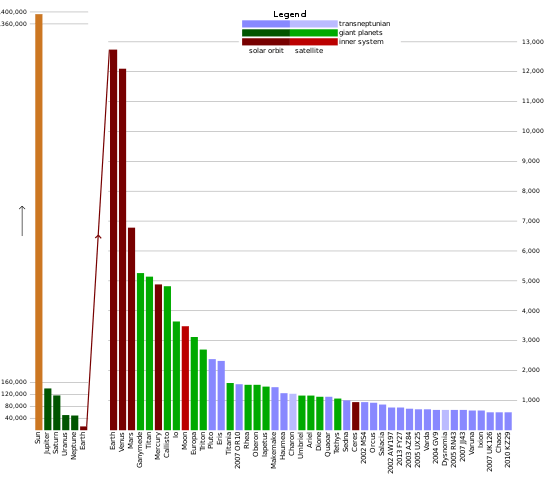
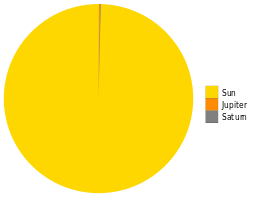 Relative masses of the bodies of the Solar System. Objects smaller than Saturn are not visible at this scale.
Relative masses of the bodies of the Solar System. Objects smaller than Saturn are not visible at this scale.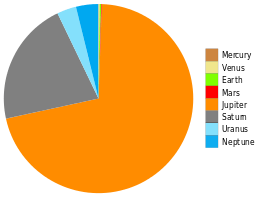
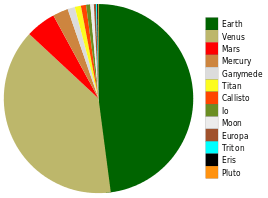
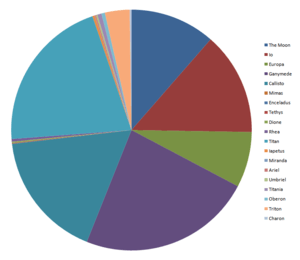
List of objects by mean radius
Larger than 400 km
It was once expected that any icy body larger than approximately 200 km in radius was likely to be in hydrostatic equilibrium (HE).[7] However, Ceres (r = 470 km) is the smallest body for which detailed measurements are consistent with hydrostatic equilibrium,[8] whereas Iapetus (r = 735 km) is the largest icy body that has been found to not be in hydrostatic equilibrium.[9] Earth's moon (r = 1,737 km) is also not in hydrostatic equilibrium, but—unlike icy Ceres and Iapetus—it is composed primarily of silicate rock, which has a much higher tensile strength than ice.
For simplicity and comparative purposes, the values are manually calculated assuming a sphericity of 1. The size of solid bodies does not include an object's atmosphere. For example, Titan looks bigger than Ganymede, but its solid body is smaller. For the giant planets, the "radius" is defined as the distance from the center at which the atmosphere reaches 1 bar of atmospheric pressure.[10] The radius of Saturn's main rings is 136,775 km.
| Body[note 1] | Image | Radius[note 2] | Volume | Mass | Density | Gravity[note 3] | Type | Shape | # [note 4] |
Discovery | ||||
|---|---|---|---|---|---|---|---|---|---|---|---|---|---|---|
| (km) | (R⊕) | (109 km3) | (V⊕) | (1021 kg) | (M⊕) | (g/cm3) | (m/s2) | (⊕) | ||||||
| Sun |  |
696342±65[11] | 109.3 | 1,414,300,000 | 1,305,700 | 1988500000 | 333,000 | 1.408 | 274.0 | 27.94 | star | round | 1 | - |
| Jupiter | 69911±6 | 10.97 | 1,431,280 | 1,321 | 1898200 ±? | 317.83 | 1.326 | 24.79 | 2.528 | planet (gas giant); has rings | round | 2 | - | |
| Saturn | 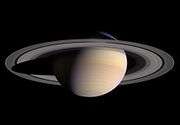 |
58232±6 (w/o rings) |
9.140 | 827,130 | 764 | 568340 ±? | 95.162 | 0.687 | 10.445 | 1.065 | planet (gas giant); has rings | round | 3 | - |
| Uranus |  |
25362±7 | 3.981 | 68,340 | 63.1 | 86813 ±? | 14.536 | 1.27 | 8.69 | 0.886 | planet (ice giant); has rings | round | 4 | 1781 |
| Neptune | _flatten_crop.jpg) |
24622±19 | 3.865 | 62,540 | 57.7 | 102413±? | 17.147 | 1.638 | 11.15 | 1.137 | planet (ice giant); has rings | round | 5 | 1846 |
| Earth |  |
6371.00 | 1 | 1,083.21 | 1 | 5972.4 | 1 | 5.514 | 9.80665 | 1 | planet (terrestrial) | round | 6 | - |
| Venus | 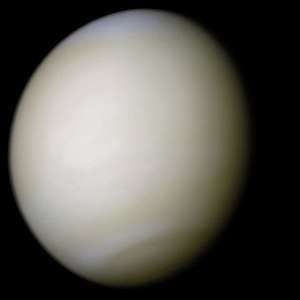 |
6051.8±1.0 (w/o gas) |
0.9499 | 928.43 | 0.857 | 4867.5 | 0.815 | 5.243 | 8.872 | 0.905 | planet (terrestrial) | round | 7 | - |
| Mars | 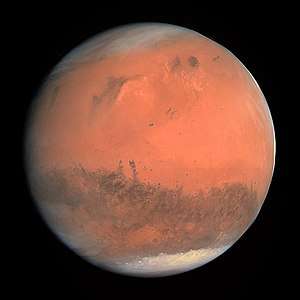 |
3389.5±0.2 | 0.5320 | 163.18 | 0.151 | 641.7 | 0.107 | 3.9335 ± 0.0004 | 3.721 | 0.379 | planet (terrestrial) | round | 8 | - |
| Ganymede Jupiter III |
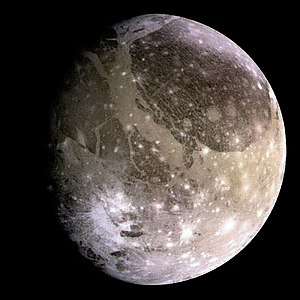 |
2634.1±0.3 | 0.4135 | 76.30 | 0.0704 | 148.2 | 0.0248 | 1.936 | 1.428 | 0.146 | moon of Jupiter | round | 9 | 1610 |
| Titan Saturn VI |
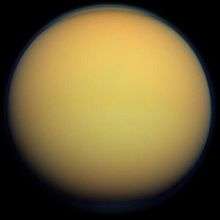 |
2574.73±0.09 (w/o gas)[lower-alpha 1] |
0.4037[lower-alpha 1] | 71.50 | 0.0658 | 134.5 | 0.0225 | 1.8798 ± 0.0044 | 1.354 | 0.138 | moon of Saturn | round | 10 | 1655 |
| Mercury | 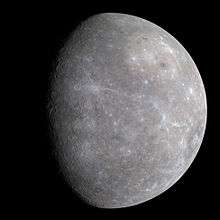 |
2439.7±1.0 | 0.3829 | 60.83 | 0.0562 | 330.1 | 0.0553 | 5.427 | 3.7 | 0.377 | planet (terrestrial) | round | 11 | - |
| Callisto Jupiter IV |
 |
2410.3±1.5 | 0.3783 | 58.65 | 0.0541 | 107.6 | 0.018 | 1.8344 ± 0.0034 | 1.23603 | 0.126 | moon of Jupiter | round | 12 | 1610 |
| Io Jupiter I |
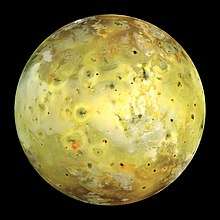 |
1821.6±0.5 | 0.2859 | 25.32 | 0.0234 | 89.32 | 0.015 | 3.528 ± 0.006 | 1.797 | 0.183 | moon of Jupiter | round | 13 | 1610 |
| Moon (Luna) Earth I |
1737.4 | 0.2727 | 21.958 | 0.0203 | 73.42 | 0.0123 | 3.3464 | 1.625 | 0.166 | moon of Earth | round | 14 | - | |
| Europa Jupiter II |
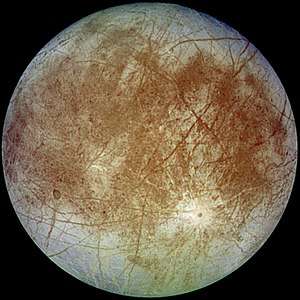 |
1560.8±0.5 | 0.2450 | 15.93 | 0.0147 | 48.00 | 0.008035 | 3.013 ± 0.005 | 1.316 | 0.134 | moon of Jupiter | round | 15 | 1610 |
| Triton Neptune I |
 |
1353.4±0.9[lower-alpha 1] | 0.2124[lower-alpha 1] | 10.38 | 0.0096 | 21.39±0.03 | 0.003599 | 2.061 | 0.782 | 0.0797 | moon of Neptune | round | 16 | 1846 |
| Pluto 134340 |
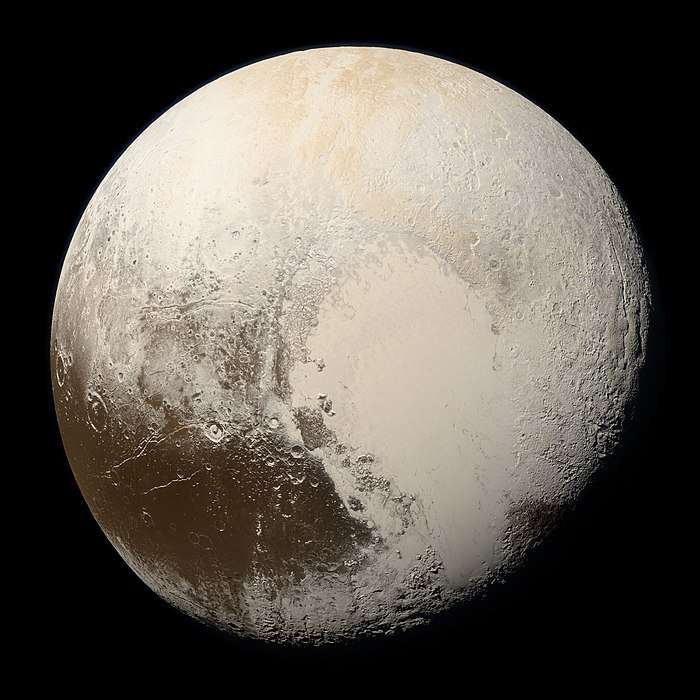 |
1188.3±0.8[12] | 0.186 | 7.057 | 0.00651 | 13.0±0.03[13] | 0.0028 | 1.854 ± 0.006 | 0.084 | dwarf planet; plutino; multiple | round | 17 | 1930 | |
| Eris 136199 |
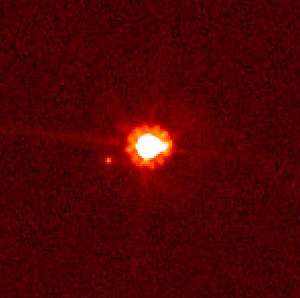 |
1163±6[lower-alpha 2][14] | 0.1825[lower-alpha 2] | 6.59 | 0.0061 | 16.6±0.2[15] | 0.0022 | 1.885 ± 0.006 | 0.824 | 0.062 | dwarf planet; SDO; binary | round | 18 | 2003 |
| Titania Uranus III |
_color%2C_edited.jpg) |
788.4±0.6[lower-alpha 3] | 0.1237[lower-alpha 3] | 2.06 | 0.0019 | 3.40±0.06 | 0.00059 | 1.711 ± 0.005 | 0.378 | 0.0385 | moon of Uranus | round | 20 | 1787 |
| Haumea 136108 |
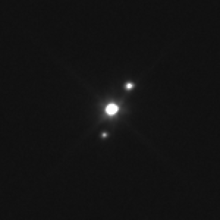 |
780[16][lower-alpha 4] | 0.12 | 1.98[lower-alpha 5] | 0.0018 | 4.01±0.04[17] | 0.00066 | 2.018[16][lower-alpha 4] | 0.401 | 0.0409 | dwarf planet?; resonant KBO (7:12); trinary; has rings |
round (scalene ellipsoid) |
19 | 2004 |
| Rhea Saturn V |
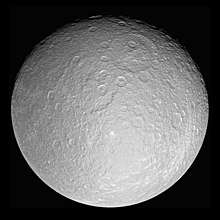 |
763.8±1.0[lower-alpha 3] | 0.1199[lower-alpha 3] | 1.87 | 0.0017 | 2.307 | 0.00039 | 1.236 ± 0.005 | 0.26 | 0.027 | moon of Saturn | round | 21 | 1672 |
| Oberon Uranus IV |
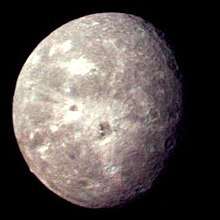 |
761.4±2.6[lower-alpha 1] | 0.1195[lower-alpha 1] | 1.85 | 0.0017 | 3.08±0.09 | 0.0005 | 1.63 ± 0.05 | 0.347 | 0.035 | moon of Uranus | round | 22 | 1787 |
| Iapetus Saturn VIII |
 |
734.5±2.8 | 0.1153 | 1.66 | 0.0015 | 1.806 | 0.00033 | 1.088 ± 0.013 | 0.223 | 0.0227 | moon of Saturn | round | 23 | 1671 |
| Makemake 136472 |
.jpg) |
715+19 −11[18] |
0.112 | 1.53 | 0.0014 | ≈ 3.1 | 0.00053 | 1.95 | 0.57 | 0.0581 | dwarf planet?; cubewano | round | 24 | 2005 |
| Gonggong 225088 |
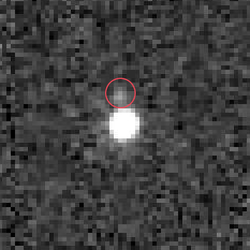 |
615±25[19] | 0.0983 | 1.03 | 0.0009 | 1.75±0.07 | 0.00029 | 1.72 ± 0.16 | 0.3 | 0.0306 | dwarf planet?; resonant SDO (3:10) | round | 25 | 2007 |
| Charon Pluto I |
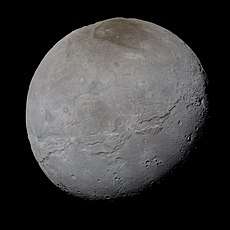 |
606±0.5 | 0.0951 | 0.932 | 0.0009 | 1.586±0.015 | 0.00025 | 1.702 ± 0.021 | 0.288 | 0.0294 | moon of Pluto | round | 26 | 1978 |
| Umbriel Uranus II |
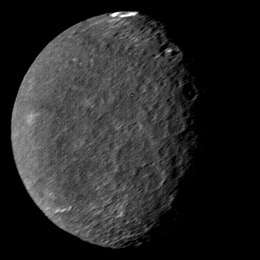 |
584.7±2.8 | 0.0918 | 0.837 | 0.0008 | 1.28±0.03 | 0.00020 | 1.39 ± 0.16 | 0.234 | 0.024 | moon of Uranus | round | 27 | 1851 |
| Ariel Uranus I |
.jpg) |
578.9±0.6 | 0.0909 | 0.813 | 0.0007 | 1.25±0.02 | 0.000226 | 1.66 ± 0.15 | 0.269 | 0.027 | moon of Uranus | round | 28 | 1851 |
| Dione Saturn IV |
561.4±0.4 | 0.0881 | 0.741 | 0.0007 | 1.095 | 0.000183 | 1.478 ± 0.003 | 0.232 | 0.0237 | moon of Saturn | round | 29 | 1684 | |
| Quaoar 50000 |
560.5±0.6 | 0.0879 | 0.737 | 0.0007 | 1.4±0.2 | 0.0002 | 1.99 ± 0.46[20] | 0.3 | 0.0306 | cubewano; binary | round[20] | 30 | 2002 | |
| Tethys Saturn III |
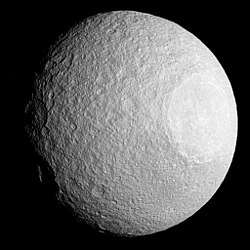 |
531.1±0.6 | 0.0834 | 0.624 | 0.0006 | 0.617 | 0.000103 | 0.984 ± 0.003[21] | 0.145 | 0.015 | moon of Saturn | round | 31 | 1684 |
| Sedna 90377 |
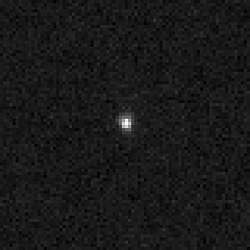 |
498±40 | 0.0785 | 0.516 | 0.0005 | ? | sednoid; detached object | unknown | 32 | 2003 | ||||
| Ceres 1 |
469.7±0.1[22] | 0.0742 | 0.433 | 0.0004 | 0.938[23] | 0.000157 | 2.17 | 0.28 | 0.029 | dwarf planet; belt asteroid | round | 33 | 1801 | |
| Orcus 90482 |
 |
458±13 | 0.0719 | 0.404 | 0.0004 | 0.61±0.04 | 0.0001 | 1.53 ± 0.14 | 0.2 | 0.0204 | plutino; binary | unknown | 34 | 2004 |
| Salacia 120347 |
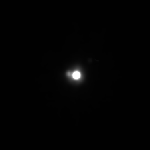 |
423±11 | 0.0664 | 0.3729 | 0.0003 | 0.492±0.007[24] | 0.000082 | 1.5 ± 0.12[24] | 0.165 | 0.0168 | cubewano; binary | unknown | 35 | 2004 |
From 200 to 399 km
All imaged icy moons with radii greater than 200 km except Proteus are clearly round, although those under 400 km that have had their shapes carefully measured are not in hydrostatic equilibrium.[25] The known densities of TNOs in this size range are remarkably low (1–1.2 g/cm3), implying that the objects retain significant internal porosity from their formation and were never gravitationally compressed into fully solid bodies.[26]
| Body[note 1] | Image | Radius[note 2] (km) |
Mass (1020 kg) |
Density (g/cm3) |
Type[note 5] | Remarks – shape[note 5] | Refs[note 6] r · M | ||||||
|---|---|---|---|---|---|---|---|---|---|---|---|---|---|
| Varda 174567 |
 |
384±8 | 2.664±0.064 | 1.24+0.5 −0.35 |
cubewano; binary | Maclaurin spheroid[28] | [28] · [29] | ||||||
| 2002 AW197 55565 |
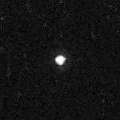 |
384±19 | – | – | cubewano | – | [29] · M | ||||||
| 2002 MS4 307261 |
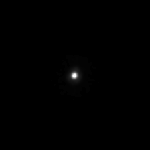 |
≈ 383 | – | – | cubewano | oblate spheroid?[30] | [30] · M | ||||||
| 2013 FY27 532037 |
 |
370+45 −43 |
– | – | detached object; binary | – | [31] · M | ||||||
| 2003 AZ84 208996 |
 |
353±12 | – | 0.87±0.01 | plutino; possible binary | scalene ellipsoid[32] | [32] · M | ||||||
| Dysnomia Eris I |
 |
350±58 | – | – | moon of Eris | – | [33] · M | ||||||
| 2004 GV9 90568 |
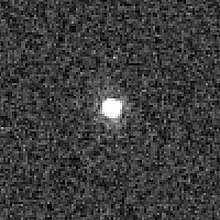 |
340±17 | – | – | cubewano | – | [34] · M | ||||||
| 2005 RN43 145452 |
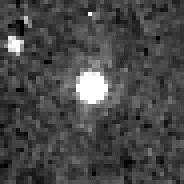 |
340+28 −37 |
– | – | cubewano | – | [34] · M | ||||||
| Varuna 20000 |
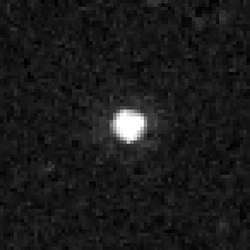 |
334+77 −43 |
≈ 1.6 | 0.99 | cubewano | scalene ellipsoid | [35] · [36] | ||||||
| 2002 UX25 55637 |
332±15 | 1.25±0.03 | 0.82±0.11 | cubewano; binary | likely non-spherical[26] | [37] · [38] | |||||||
| 2018 VG18 | ≈ 328 | – | – | SDO | – | [7] · M | |||||||
| Gǃkúnǁʼhòmdímà 229762 |
.png) |
321±14 | 1.361±0.033 | 1.02±0.17 | SDO; binary | likely non-spherical[39] | [39] · [26] | ||||||
| 2014 UZ224 | 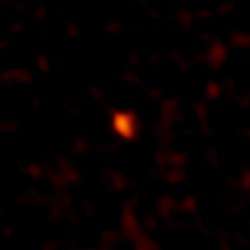 |
318+16 −20 |
– | – | SDO | – | [40] · M | ||||||
| 2014 EZ51 523692 |
≈ 313 | – | – | SDO | – | [7] · M | |||||||
| 2015 RR245 523794 |
≈ 313 | – | – | resonant KBO (2:9) | binary; may be smaller | [41] · M | |||||||
| 2008 OG19 470599 |
309.5+28 −56.5 |
– | 0.609±0.004 | SDO | scalene ellipsoid[42] | [42] · [42] | |||||||
| Ixion 28978 |
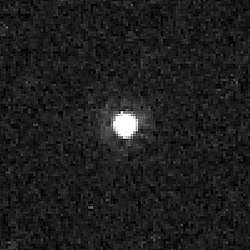 |
308.5±10 | – | – | plutino | – | [43] · M | ||||||
| 2010 RF43 | ≈ 306 | – | – | SDO | – | [7] · M | |||||||
| 2006 QH181 | 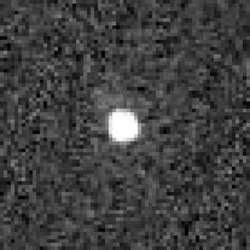 |
≈ 304 | – | – | resonant SDO (3:10) | – | [27] · M | ||||||
| Chaos 19521 |
300+70 −65 |
– | – | cubewano | – | [34] · M | |||||||
| 2010 JO179 | ≈ 299 | – | – | resonant SDO (5:21) | – | [7] · M | |||||||
| 2012 VP113 | ≈ 299 | – | – | sednoid | – | [7] · M | |||||||
| 2010 KZ39 | ≈ 299 | – | – | detached | – | [7] · M | |||||||
| 2002 TC302 84522 |
 |
292+53 −44 |
– | – | resonant SDO (2:5) | – | [37] · M | ||||||
| 2014 AN55 543354 |
≈ 292 | – | – | SDO | – | [7] · M | |||||||
| 2002 XW93 78799 |
283+36 −37 |
– | – | other TNO | – | [44] · M | |||||||
| 2004 XR190 | 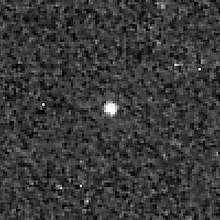 |
≈ 278 | – | – | SDO | – | [7] · M | ||||||
| 2002 XV93 | 275+11 −12 |
– | – | plutino | – | [45] · M | |||||||
| 2003 VS2 84922 |
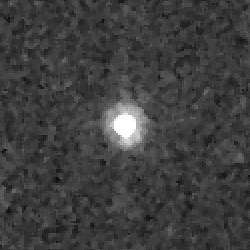 |
274+15 −22 |
– | > 0.7 | plutino | scalene ellipsoid; non-equilibrium shape[46] | [46] · [46] | ||||||
| 2005 RM43 145451 |
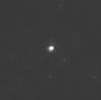 |
≈ 272 | – | ≈ 0.56 | SDO | – | [7] · [27] | ||||||
| 2010 RE64 523639 |
≈ 272 | – | – | SDO | – | [7] · M | |||||||
| 2014 WK509 523759 |
≈ 272 | – | – | SDO | – | [7] · M | |||||||
| 2008 ST291 528381 |
≈ 272 | – | – | resonant SDO (1:6) | – | [7] · M | |||||||
| 2013 FZ27 523671 |
≈ 272 | – | – | SDO | – | [7] · M | |||||||
| 2003 UZ413 455502 |
 |
≈ 268 | – | ≈ 2.64 | plutino | likely scalene ellipsoid[47] | [7] · [47] | ||||||
| 2017 OF69 | ≈ 266 | – | – | plutino | – | [27] · M | |||||||
| 2007 JJ43 278361 |
≈265 | – | – | cubewano | – | [48] · M | |||||||
| Vesta 4 |
262.7±0.1 | 2.59 | 3.46 | belt asteroid type V | formerly round (not in hydrostatic equilibrium: frozen-in ellipsoidal shape and large impact basins)[49][50] | [51] · [51] | |||||||
| 2014 FC69 | ≈ 259 | – | – | SDO | – | [7] · M | |||||||
| 2014 YA50 | ≈ 259 | – | – | plutino | – | [7] · M | |||||||
| Pallas 2 |
 |
256±3 | 2.11±0.26 | 3.0±0.5 | belt asteroid type B | irregular, borderline[52] | [52] · [53] | ||||||
| 2004 TY364 120348 |
256+19 −20 |
– | – | cubewano | – | [43] · M | |||||||
| 2014 FC72 | ≈ 253 | – | – | SDO | – | [27] · M | |||||||
| 2008 AP129 315530 |
≈ 253 | – | – | cubewano | – | [7] · M | |||||||
| 2014 UM33 472271 |
≈ 253 | – | – | cubewano | – | [7] · M | |||||||
| 2010 FX86 | ≈ 253 | – | – | cubewano | – | [7] · M | |||||||
| Enceladus Saturn II |
 |
252.1±0.2 | 1.08±0.001 | 1.609±0.005 | moon of Saturn | round (not in hydrostatic equilibrium: frozen-in ellipsoidal shape) | [54] · [55] | ||||||
| 2005 UQ513 202421 |
249+32 −38 |
– | – | cubewano | – | [29] · M | |||||||
| 2010 VZ98 445473 |
≈ 247 | – | – | SDO | – | [7] · M | |||||||
| 2015 AM281 495603 |
≈ 247 | – | – | resonant KBO (2:5) | – | [7] · M | |||||||
| 2010 VK201 523645 |
≈ 236 | – | – | cubewano | – | [7] · M | |||||||
| 2011 FW62 2015 AJ281 |
≈ 236 | – | – | plutino | – | [7] · M | |||||||
| Miranda Uranus V |
 |
235.8±0.7 | 0.659±0.075 | 1.2±0.15 | moon of Uranus | round | [56] · [57] | ||||||
| Dziewanna 471143 |
 |
235+18 −5 |
– | – | SDO | – | [58] · M | ||||||
| 2005 TB190 145480 |
 |
232±31 | – | – | detached object | – | [33] · M | ||||||
| 1999 DE9 26375 |
231±23 | – | – | resonant SDO (2:5) | – | [59] · M | |||||||
| 2003 FY128 120132 |
230±11 | – | – | SDO | – | [33] · M | |||||||
| 2011 GM27 471288 |
≈ 230 | – | – | cubewano | – | [7] · M | |||||||
| 2003 QX113 | 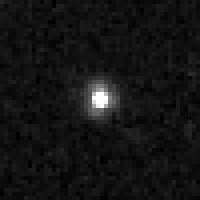 |
≈ 230 | – | – | SDO | – | [7] · M | ||||||
| 2002 VR128 84719 |
224+24 −22 |
– | – | plutino | – | [45] · M | |||||||
| Vanth Orcus I |
 |
221.3±5.1 | ≈ 0.7 | ≈ 1.5 | moon of 90482 Orcus | – | [60] · [60] | ||||||
| Hygiea 10 |
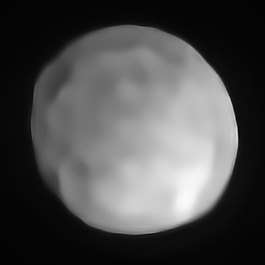 |
217±7 | 0.832±0.08 | 1.944±0.25 | belt asteroid type C | round | [61] · [61] | ||||||
| 2003 QX111 | ≈ 217 | – | – | SDO | – | [27] · M | |||||||
| 2004 NT33 444030 |
212+44 −40 |
– | – | cubewano | – | [29] · M | |||||||
| Proteus Neptune VIII |
.jpg) |
210±7 | 0.44 | ≈ 1.3 | moon of Neptune | irregular; borderline | [5] · [5] | ||||||
| 2005 QU182 303775 |
208±37 | – | – | SDO | – | [33] · M | |||||||
| 2002 KX14 119951 |
 |
207.5±0.5 | – | – | cubewano | – | [62] · M | ||||||
| 2001 QF298 469372 |
 |
204+20 −22 |
– | – | plutino | – | [45] · M | ||||||
| Huya 38628 |
 |
203±8 | > 0.5 | > 1.43 | plutino; binary | – | [37] · [63] | ||||||
| 2004 PF115 175113 |
203+49 −38 |
– | – | plutino | – | [45] · M | |||||||
|
Legend:
| |||||||||||||
From 100 to 199 km
This list contains a selection of objects estimated to be between 100 and 199 km in radius (200 and 399 km in diameter). The largest of these may lie above the boundary for hydrostatic equilibrium, but most are irregular. Most of the trans-Neptunian objects (TNOs) listed with a radius smaller than 200 km have "assumed sizes based on a generic albedo of 0.09" since they are too far away to directly measure their sizes with existing instruments. Mass switches from 1021 kg to 1018 kg (Zg). Main-belt asteroids have orbital elements constrained by (2.0 AU < a < 3.2 AU; q > 1.666 AU) according to JPL Solar System Dynamics (JPLSSD).[64] Many TNOs are omitted from this list as their sizes are poorly known.[27]
| Body[note 1] | Image | Radius[note 2] (km) |
Mass (1018 kg) |
Type | Remarks – shape | Refs[note 6] r · M |
|---|---|---|---|---|---|---|
| 2004 UX10 144897 |
199±19.5 | ≈ 30 | plutino | – | [45] · [65] | |
| Mimas Saturn I |
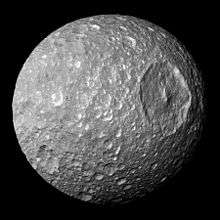 |
198.2±0.4 | 37.49±0.03 | moon of Saturn | round (smallest body currently known to have an ellipsoidal shape, but not in hydrostatic equilibrium) | [54] · [55] |
| 1998 SN165 35671 |
196.5±19.5 | cubewano | – | [29] · M | ||
| Nereid Neptune II |
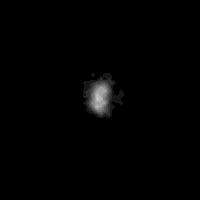 |
178.5±6.5 | moon of Neptune | probably irregular in shape[66] | [66] · M | |
| 2001 UR163 42301 |
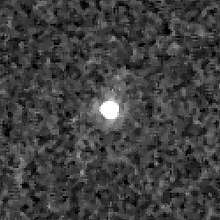 |
≈ 176 | resonant KBO (4:9) | – | [27] · M | |
| 1996 TL66 15874 |
169.5±10 | SDO | – | [33] · M | ||
| 2004 XA192 230965 |
169.5+60 −47.5 |
SDO | – | [45] · M | ||
| 2002 WC19 119979 |
 |
≈ 169 | 77±5.34 | resonant KBO (1:2); binary | – | [67] · [67] |
| Interamnia 704 |
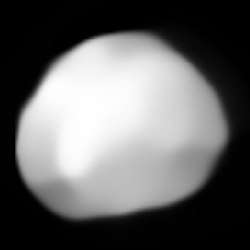 |
166±3 | 37.9±12.8 | belt asteroid type F | scalene ellipsoid; likely in hydrostatic equilibrium[68] | [68] · [68] |
| Ilmarë Varda I |
 |
163+19 −17 |
moon of 174567 Varda | – | [69] · M | |
| Hiʻiaka Haumea I |
 |
≈ 160 | 17.9±1.1 | moon of Haumea | probably irregular in shape[70] | [17] · [17] |
| 2010 TY53 | ≈ 158 | extended centaur | – | [7] · M | ||
| 2010 TJ | ≈ 158 | SDO | – | [7] · M | ||
| 1999 CD158 469306 |
≈ 155 | > 12.5 | resonant KBO (4:7) | – | [27] · [27] | |
| Europa 52 |
152.0±1.8 | 23.8±5.8 | belt asteroid type C | irregular shape[71] | [72] · [73] | |
| 2004 EW95 120216 |
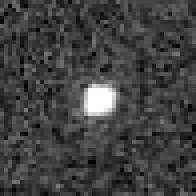 |
145.5 | plutino | – | [27] · M | |
| Davida 511 |
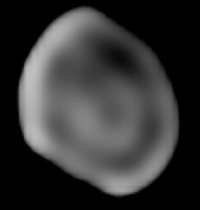 |
145.2±1.1 | 33.8±10.2 | belt asteroid type C | irregular shape | [74] · [73] |
| 2002 TX300 55636 |
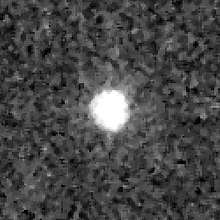 |
143±5 | cubewano; Haumea family | – | [75] · M | |
| Sylvia 87 |
143±5.5 | 14.78±0.06 | outer belt asteroid type X; trinary | irregular shape[71] | [76] · [77] | |
| Actaea Salacia I |
 |
143±12 | moon of 120347 Salacia | – | [78] · M | |
| 1995 SN55 | ≈ 139 | Lost centaur or transient TNO | – | [7] · M | ||
| Hyperion Saturn VII |
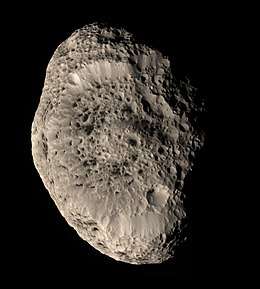 |
138.6±4 | 5.62±0.05 | moon of Saturn | irregular shape | [25] · [25] |
| Lempo 47171 |
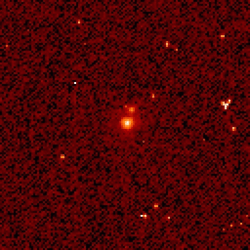 |
136+8.5 −9.5 |
plutino; trinary | – | [79] · M | |
| 1998 SM165 26308 |
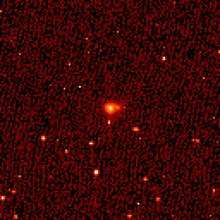 |
134±14 | 6.87±1.8 | resonant KBO (1:2) | irregular shape | [80] · [80] |
| Euphrosyne 31 |
133.5±1.3 | 12.7±6.5 | belt asteroid type C; binary | irregular shape | [72] · [73] | |
| Chariklo 10199 |
 |
≈ 130 | centaur | has rings | [81] · M | |
| Eunomia 15 |
128.2±1.5 | 31.4±1.8 | belt asteroid type S | irregular shape[71] | [82] · [73] | |
| 2005 RR43 145453 |
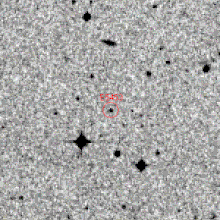 |
≈ 126 | ≈ 14.6 | cubewano; Haumea family | – | [83] · [27] |
| Hiisi Lempo II |
125.5+8 −8.5 |
secondary of 47171 Lempo | – | [79] · M | ||
| Hektor 624 |
125±13 | 7.9±1.4 | Jupiter trojan (L4) type D; binary | irregular shape; contact binary | [84] · [84] | |
| Sila 79360 |
124.5+15 −15.5 |
10.8±0.22 | cubewano; binary | – | [85] · M | |
| 2007 RW10 309239 |
123.5±15 | quasi-satellite of Neptune | – | [33] · M | ||
| Juno 3 |
123.3±5.9 | 27.3±2.9 | belt asteroid type S | irregular shape[71] | [86] · [73] | |
| Altjira 148780 |
123+19 −70 |
cubewano; binary | – | [29] · M | ||
| Cybele 65 |
118.6±2.1 | 13.6±3.1 | outer belt asteroid type C | irregular shape | [87] · [73] | |
| Nunam 79360 |
118+14 −15 |
secondary of 79360 Sila | – | [85] · M | ||
| 2001 QC298 | 118+10 −12 |
11.88±0.14 | cubewano; binary | – | [29] · [29] | |
| Psyche 16 |
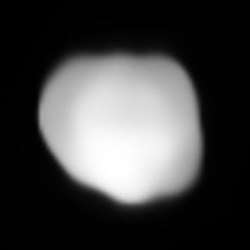 |
≈ 117 | 24.1±3.2 | belt asteroid type M | irregular shape | [88] · [89] |
| Patientia 451 |
112.9±2.3 | 10.9±5.3 | belt asteroid type C | irregular shape | [86] · [73] | |
| 2014 NW65 523727 |
≈ 112.5 | centaur | – | [7] · M | ||
| Ceto 65489 |
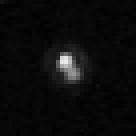 |
111.5±5 | 5.4±0.4 | extended centaur; binary | – | [33] · [90] |
| 2001 FP185 82158 |
≈ 111 | SDO | – | [91] · M | ||
| Herculina 532 |
111.2±2.4 | belt asteroid type S | irregular shape[71] | [87] · M | ||
| S/2007 (148780) 1 Altjira I |
110.5+17 −62.5 |
secondary of 148780 Altjira | – | [29] · M | ||
| Bamberga 324 |
110.35±0.72 | 10±1 | belt asteroid type C | irregular shape | [86] · [73] | |
| Doris 48 |
108.2±2.4 | 6.1±3.0 | belt asteroid type C | irregular shape | [86] · [73] | |
| 2000 YW134 82075 |
≈ 108 | resonant SDO (3:8); binary[27] | – | [27] · M | ||
| Chiron 2060 or 95P |
 |
108±5 | centaur | has rings | [37] · M | |
| Egeria 13 |
107±6 | 8.8±4.2 | belt asteroid type G | irregular shape | [73] · [73] | |
| Iris 7 |
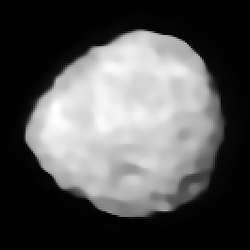 |
107±2.5 | 13.8±1.3 | belt asteroid type S | irregular shape | [92] · [92] |
| Phoebe Saturn IX |
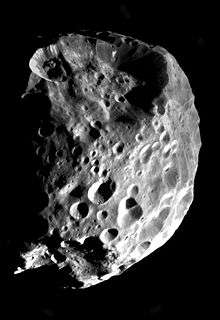 |
106.6±0.8 | 8.29±0.01 | moon of Saturn | formerly round[93] | [25] · [25] |
| S/2012 (38628) 1 Huya I |
 |
106±15 | moon of 38628 Huya | – | [37] · M | |
| Deucalion 53311 |
≈ 106 | cubewano | – | [27] · M | ||
| 2015 TH367 | ≈ 106 | centaur | – | [7] · M | ||
| Camilla 107 |
105±4 | 11.2±0.3 | outer belt asteroid type C; trinary | irregular shape[94] | [86] · [73] | |
| Fortuna 19 |
103±3 | 8.6±1.5 | belt asteroid type G | irregular shape | [73] · [73] | |
| Thisbe 88 |
102±5 | 15.3±3.1 | belt asteroid type B | irregular shape[94] | [73] · [73] | |
| Eugenia 45 |
101±1 | 5.7±0.1 | belt asteroid type F; trinary | irregular shape[71] | [86] · [95] | |
| Legend: | ||||||
From 50 to 99 km
This list contains a selection of objects 50 and 99 km in radius (100 km to 199 km in average diameter). The listed objects currently include most objects in the asteroid belt and moons of the giant planets in this size range, but many newly discovered objects in the outer Solar System are missing, such as those included in the following reference.[27] Asteroid spectral types are mostly Tholen, but some might be SMASS.
| Body[note 1] | Image | Radius[note 2] (km) |
Mass (1018 kg) |
Type – notes | Refs[note 6] r · M |
|---|---|---|---|---|---|
| Chicago 334 |
99.4±2.8 | 5.1±5.6 | belt asteroid type C | [86] · [73] | |
| Bienor 54598 |
99+3 −3.5 |
centaur | [96] · M | ||
| Themis 24 |
98±2 | 5.9±1.9 | belt asteroid type C; Themis family | [86] · [73] | |
| Larissa Neptune VII |
97±5 | ≈ 4.2 | moon of Neptune | [97] · [lower-alpha 6] | |
| Ursula 375 |
96.8±1.3 | 8.4±5.3 | belt asteroid type C | [82] · [73] | |
| S/2002 (2001 QC298) 1 2001 QC298 I |
96+9 −10 |
secondary of 2001 QC298 | [29] · M | ||
| S/2018 (532037) 1 2013 FY27 I |
 |
≈ 95 | moon of (532037) 2013 FY27 | [31] · M | |
| Amphitrite 29 |
94.8±0.6 | 13±2 | belt asteroid type S | [86] · [73] | |
| Daphne 41 |
94.5±0.5 | 6.3±0.1 | belt asteroid type C; binary | [99] · [73] | |
| Aurora 94 |
93.8±3.6 | 6.2±3.6 | belt asteroid type C | [74] · [73] | |
| Hermione 121 |
94±3 | 5.0±0.3 | outer belt asteroid type C; binary | [100] · [73] | |
| Bertha 154 |
93.4±0.9 | 9.2±5.2 | belt asteroid type C | [73] · [73] | |
| Hebe 6 |
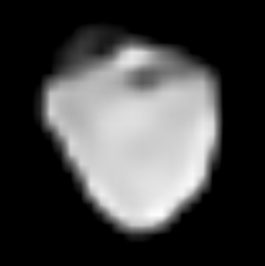 |
92.6±1.4 | 14±1 | belt asteroid type S | [87] · [73] |
| Metis 9 |
≈ 92 | 8.4±1.7 | belt asteroid type S | [86] · [73] | |
| Elektra 130 |
90.3±1.3 | 6.6±0.4 | belt asteroid type G; trinary | [86] · [101] | |
| Loreley 165 |
90±1 | ≈ 19±2 | belt asteroid type C | [86] · [73] | |
| Janus Saturn X |
89.5±1.4 | 1.898±0.001 | moon of Saturn | [25] · [25] | |
| Teharonhiawako 88611 |
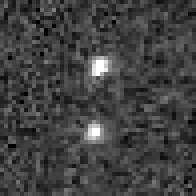 |
89+16 −18 |
2.44±0.03 | cubewano; binary | [29] · [102] |
| Nemesis 128 |
89±1 | 6.0±2.6 | belt asteroid type C | [82] · [73] | |
| Aegle 96 |
88.9±0.8 | 6.4±6.3 | belt asteroid type T | [86] · [73] | |
| Diotima 423 |
88±32 | 6.9±1.9 | belt asteroid type C | [86] · [73] | |
| S/2015 (136472) 1 Makemake I |
≈ 87.5 | moon of Makemake | [103] · M | ||
| Galatea Neptune VI |
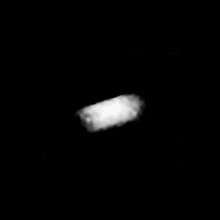 |
87.4±4.9 | 2.12±0.08 | moon of Neptune | [97] · [104] |
| Aletheia 259 |
87.2±0.5 | 7.8±0.4 | belt asteroid type CP/type X | [86] · [73] | |
| Phorcys Ceto I |
 |
87+8 −9 |
≈ 1.67 | secondary of 65489 Ceto | [90] · [90] |
| Palma 372 |
86.8±1.4 | 5.2±0.6 | belt asteroid type B | [72] · [73] | |
| Alauda 702 |
86±28 | 6.06±0.36 | belt asteroid type C; binary | [72] · [105] | |
| Winchester 747 |
85.9±1.6 | 3.8±2.2 | belt asteroid type C | [87] · [73] | |
| Aspasia 409 |
85.5±0.6 | 11.8±2.3 | belt asteroid type C | [86] · [73] | |
| Hilda 153 |
85.3±1.6 | outer belt asteroid; Hildas | [87] · M | ||
| Pretoria 790 |
85.2±1.3 | 4.6±0.3 | outer belt asteroid type P; Cybele asteroid | [87] · [73] | |
| Himalia Jupiter VI |
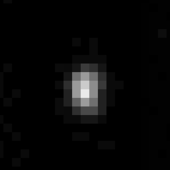 |
≈ 85 | 4.2±0.6 | moon of Jupiter | [5] · [106] |
| Namaka Haumea II |
 |
≈ 85 | 1.8±1.5 | moon of Haumea | [17] · [17] |
| Weywot Quaoar I |
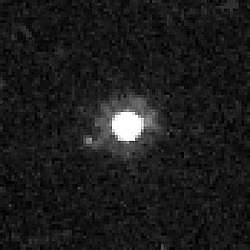 |
≈ 85 | moon of 50000 Quaoar | ||
| Germania 241 |
84.4±1.6 | ≈ 0.86±5 | belt asteroid type CP/type B | [87] · [73] | |
| Freia 76 |
84.2±1.0 | 2.0±4.2 | outer belt asteroid type P/type X; Cybele asteroid | [82] · [73] | |
| Rhadamanthus 38083 |
≈ 84 | trans-Neptunian object | [27] · M | ||
| Kalliope 22 |
83.8±1.5 | 8.16±0.26 | belt asteroid type M; binary | [86] · [107] | |
| Stereoskopia 566 |
83.7±1.7 | outer belt asteroid type C; Cybele asteroid | [86] · M | ||
| Amalthea Jupiter V |
84±2 | 2.08±0.15 | moon of Jupiter | [108] · [109] | |
| Agamemnon 911 |
83.3±2.0 | Jupiter trojan (L4) type D | [87] · M | ||
| Elpis 59 |
82.6±2.3 | 3±0.5 | belt asteroid type CP/type B | [86] · [73] | |
| Siegena 386 |
82.5±1.4 | 8.1±1.6 | belt asteroid type C | [87] · [73] | |
| Sycorax Uranus XVII |
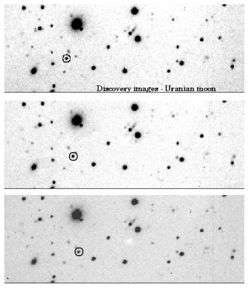 |
82.5+18 −21 |
moon of Uranus | [43] · M | |
| Puck Uranus XV |
 |
81±2 | moon of Uranus | [110] · M | |
| Prokne 194 |
80.8±0.6 | 2.7±0.3 | belt asteroid type C | [86] · [73] | |
| Eunike 185 |
80±1 | 3.6±2.6 | belt asteroid type C | [86] · [73] | |
| Gyptis 444 |
79.7±0.2 | 10.6±2.8 | belt asteroid type C | [86] · [73] | |
| Despina Neptune V |
78±5 | moon of Neptune | [97] · M | ||
| Hypatia 238 |
77.8±0.4 | 4.9±1.7 | belt asteroid type C | [86] · [73] | |
| Merapi 536 |
77.6±1.8 | ≈ 26±5 | belt asteroid type X | [73] · [73] | |
| Lachesis 120 |
77.6±0.6 | belt asteroid type C | [86] · M | ||
| Io 85 |
77.4±1.9 | 2.6±1.5 | belt asteroid type FC/type B | [87] · [73] | |
| Bononia 361 |
77.2±1.3 | belt asteroid type D | [86] · M | ||
| Minerva 93 |
77.08±0.65 | 3.5±0.4 | belt asteroid type C; trinary | [86] · [73] | |
| Alexandra 54 |
77.07±0.32 | 6.2±3.5 | belt asteroid type C | [86] · [73] | |
| Laetitia 39 |
77±2 | 4.7±1.1 | belt asteroid type S | [73] · [73] | |
| 2004 TT357 | 76.25±5[lower-alpha 7] | resonant KBO (2:5); contact binary | [111] · M | ||
| Berbericia 776 |
75.9±0.4 | 2.2±2.7 | belt asteroid type C | [86] · [73] | |
| Juewa 139 |
.jpg) |
75.6±0.8 | 5.5±2.2 | belt asteroid type CP/type X | [86] · [73] |
| Parthenope 11 |
75±1 | 5.91±0.45 | belt asteroid type S | [82] · [73] | |
| Manwë 385446 |
 |
≈ 75 | ≈ 1.41 | resonant KBO (4:7); binary | [112] · [112] |
| Pales 49 |
≈ 74.9 | 4.2±2.2 | belt asteroid type C | [87] · [73] | |
| Adeona 145 |
74.8±2.7 | 2.08±0.57 | belt asteroid; Adeona family | [73] · [73] | |
| Eleonora 354 |
74.5±0.2 | 7.2±2.6 | belt asteroid type S | [86] · [73] | |
| Comacina 489 |
74.1±1.9 | belt asteroid type S | [87] · M | ||
| 1998 WW31 | _1.jpg) |
≈ 74 | 2.66±0.02 | cubewano; binary | [113] · [113] |
| Arethusa 95 |
74.0±2.4 | belt asteroid type C | [74] · M | ||
| Flora 8 |
73.7±0.5 | ≈ 9.2±1.8 | belt asteroid type S; Flora family | [86] · [73] | |
| Pulcova 762 |
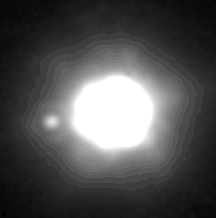 |
73.7±0.4 | 1.4±0.1 | belt asteroid type F; binary | [86] · [114] |
| Hispania 804 |
73.50±0.96 | 5±1.78 | belt asteroid type P | [82] · [73] | |
| Lomia 117 |
≈ 73 | 6.08±0.63 | belt asteroid type X | [73] · [73] | |
| Dione 106 |
73.3±1.4 | 3.1±1.5 | belt asteroid type G | [87] · [73] | |
| Julia 89 |
72.7±0.6 | 6.7±1.8 | belt asteroid type S | [86] · [73] | |
| Sibylla 168 |
72.7±1.6 | 3.9±1.8 | belt asteroid type C | [86] · [73] | |
| Philomela 196 |
72±2 | 4±1.5 | belt asteroid type S | [86] · [73] | |
| Irene 14 |
72±1 | 2.9±1.9 | belt asteroid type S | [82] · [73] | |
| Meliboea 137 |
71.9±1.3 | 7.3±3.1 | belt asteroid type C | [82] · [73] | |
| Aglaja 47 |
71±4 | 3.2±1.7 | belt asteroid type C | [73] · [73] | |
| Vibilia 144 |
70.7±1.4 | 5.3±1.2 | belt asteroid type C | [87] · [73] | |
| Isolda 211 |
70.6±1.2 | 4.5±2.4 | belt asteroid type C | [86] · [73] | |
| Adorea 268 |
70.3±1.6 | 3.2±2.3 | belt asteroid type FC | [74] · [73] | |
| Patroclus 617 |
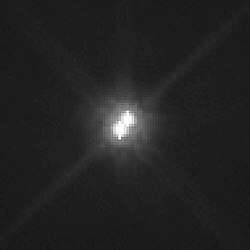 |
70.181±0.434 | 1.36±0.11 | Jupiter trojan (L5) type P; binary | [86] · [73] |
| Dido 209 |
70.175±5.06 | 4.59±7.42 | belt asteroid type C | [73] · [73] | |
| Dembowska 349 |
69.715±2.15 | 3.58±1.03 | belt asteroid type R | [87] · [73] | |
| Princetonia 508 |
69.845±1.155 | 2.99±0.65 | belt asteroid type C | [82] · [73] | |
| Melpomene 18 |
69.797±1.226 | 3 | belt asteroid type S | [86] · [53] | |
| Bertholda 420 |
69.349±1.723 | ≈ 14.8±0.9 | outer belt asteroid type P | [86] · [73] | |
| Hedwig 476 |
69.247±0.488 | belt asteroid type P | [86] · M | ||
| Nemausa 51 |
.jpg) |
69.079±0.483 | 2.48±0.86 | belt asteroid type G | [86] · [73] |
| Hesperia 69 |
69.065±2.35 | 5.86±1.18 | belt asteroid type M | [87] · [73] | |
| Typhon 42355 |
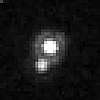 |
69±4.5 | 0.87±0.03 | SDO; resonant KBO (7:10); extended centaur; binary | [96] · [115] |
| Liguria 356 |
68.28±0.94 | ≈ 7.83±1.5 | belt asteroid type C | [82] · [73] | |
| Medea 212 |
68.06±1.25 | ≈ 13.2±1 | belt asteroid type DCX | [87] · [73] | |
| Massalia 20 |
67.84±1.837 | 5±1.04 | belt asteroid type S | [72] · [73] | |
| Portia Uranus XII |
67.6±4 | moon of Uranus | [5] · M | ||
| Wratislavia 690 |
67.325±1.9 | ≈ 12.8±0.3 | belt asteroid type CPF | [87] · [73] | |
| Eukrate 247 |
.png) |
67.215±1.25 | belt asteroid type CP/type Xc | [87] · M | |
| Papagena 471 |
67.095±2.6 | 3.05±1.73 | belt asteroid type S | [82] · [73] | |
| Protogeneia 147 |
66.465±2.55 | ≈ 12.3±0.5 | belt asteroid type C | [87] · [73] | |
| Emma 283 |
66.193±0.129 | 1.38±0.03 | belt asteroid type X; binary | [86] · [73] | |
| Erminia 705 |
66.131±0.589 | belt asteroid type X | [86] · M | ||
| Lumen 141 |
66.08±0.755 | ≈ 8.25±5.77 | belt asteroid type C | [82] · [73] | |
| Paha Lempo I |
 |
66+4 −4.5 |
0.746±0.001 | moon of 47171 Lempo | [79] · [116] |
| Lucina 146 |
65.947 | belt asteroid type C | [117] · M | ||
| Sawiskera Teharonhiawako I |
 |
65.5+12 −13 |
secondary of 88611 Teharonhiawako | [29] · M | |
| Kleopatra 216 |
65.333 | 4.64±0.02 | belt asteroid type M; trinary | [118] · [73] | |
| Achilles 588 |
65.049±0.277 | Jupiter trojan (L4) type DU | [86] · M | ||
| Lamberta 187 |
64.938±1.217 | 1.8±0.85 | belt asteroid type C | [86] · [73] | |
| Carlova 360 |
64.563±1.416 | belt asteroid type C | [86] · M | ||
| Klymene 104 |
64.495±1.901 | belt asteroid type C | [86] · M | ||
| Ornamenta 350 |
64.365±0.599 | belt asteroid type C | [86] · M | ||
| Polyxo 308 |
64.289±0.779 | belt asteroid type T | [86] · M | ||
| Dynamene 200 |
64.151±0.973 | ≈ 1.07±0.16 | belt asteroid type C | [86] · [73] | |
| Desiderata 344 |
62.985±0.689 | 1.39±0.48 | belt asteroid type C | [74] · [73] | |
| Panopaea 70 |
63.956±0.373 | 4.33±1.09 | belt asteroid type C; Eunomia family | [86] · [73] | |
| Thule 279 |
63.295±1.85 | belt asteroid type D | [87] · M | ||
| Tanete 772 |
.jpg) |
63.237±0.649 | belt asteroid type C | [86] · M | |
| Ate 111 |
63.172±0.117 | 1.76±0.44 | belt asteroid type C | [86] · [73] | |
| Borasisi 66652 |
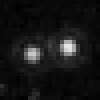 |
63+12.5 −25.5 |
3.433±0.027 | cubewano; binary | [29] · [119] |
| Ino 173 |
62.911±0.745 | 4.79±3.11 | belt asteroid type X | [86] · [73] | |
| Charybdis 388 |
62.877±0.944 | belt asteroid type C | [86] · M | ||
| Aemilia 159 |
62.618±0.596 | belt asteroid type C | [86] · M | ||
| Pompeja 203 |
62.296±0.539 | belt asteroid type DCX | [72] · M | ||
| Aurelia 419 |
62.235±1.54 | 1.72±0.34 | belt asteroid type F | [73] · [73] | |
| Hestia 46 |
62.07±1.7 | 3.5 | belt asteroid type P/type Xc | [87] · [120] | |
| Boliviana 712 |
62.063±0.632 | belt asteroid type C/type X | [72] · M | ||
| 2006 SQ372 308933 |
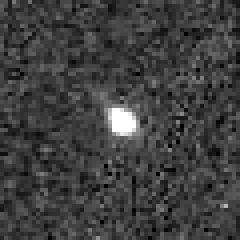 |
≈ 62 | extended centaur | [7] · M | |
| Argentina 469 |
61.555±0.825 | 4.53±1.76 | belt asteroid type X; Cybele asteroid | [82] · [73] | |
| S/2000 (1998 WW31) 1 1998 WW31 I |
_1.jpg) |
≈ 61.5 | secondary of 1998 WW31 | [113] · M | |
| Gudrun 328 |
61.295±1.86 | 3.16±0.46 | belt asteroid type S | [73] · [73] | |
| Leto 68 |
61.255±1.569 | 3.28±1.9 | belt asteroid type S | [86] · [73] | |
| 2001 QG298 139775 |
≈ 61 | plutino; contact binary | [121] · M | ||
| Elfriede 618 |
60.77±0.795 | belt asteroid type C | [82] · M | ||
| Hippo 426 |
60.645±1.125 | belt asteroid type F | [82] · M | ||
| Undina 92 |
60.465±0.85 | 4.43±0.25 | belt asteroid type X | [82] · [73] | |
| Bellona 28 |
 |
60.45±1.9 | 2.62±0.15 | belt asteroid type S | [122] · [73] |
| Diana 78 |
60.3±1.35 | 1.27±0.13 | belt asteroid type C | [123] · [73] | |
| Myrrha 381 |
60.29±1.35 | ≈ 9.18±0.8 | outer belt asteroid type C | [87] · [73] | |
| Anchises 1173 |
60.245±1.455 | Jupiter trojan (L5) type P | [82] · M | ||
| Armida 514 |
60.047±0.395 | belt asteroid type XC | [124] · M | ||
| Antigone 129 |
59.72±1.955 | 2.65±0.89 | belt asteroid type M | [73] · [73] | |
| Nuwa 150 |
59.564±0.935 | 1.62±0.2 | belt asteroid type C | [125] · [73] | |
| Veritas 490 |
59.402±0.915 | 5.99±2.23 | belt asteroid type C; Veritas family | [126] · [73] | |
| Paris 3317 |
59.395±0.588 | Jupiter trojan (L5) type T | [127] · M | ||
| Galatea 74 |
59.355±1.4 | 6.13±5.36 | belt asteroid type C | [128] · [73] | |
| Deiphobus 1867 |
59.11±0.808 | Jupiter trojan (L5) type D | [129] · M | ||
| Äneas 1172 |
59.01±0.403 | Jupiter trojan (L5) type D | [130] · M | ||
| Diomedes 1437 |
58.893±0.59 | Jupiter trojan (L4) type D | [131] · M | ||
| Terpsichore 81 |
58.864±0.367 | 6.19±5.31 | belt asteroid type C | [132] · [73] | |
| Ani 791 |
58.433±0.512 | belt asteroid type C | [133] · M | ||
| Freda 1093 |
58.365±1.45 | belt asteroid type C | [134] · M | ||
| Ulla 909 |
58.22±1.2 | belt asteroid type X; Ulla family | [135] · M | ||
| Zelinda 654 |
58.151±1.189 | 1.35±0.14 | belt asteroid type C | [86] · [73] | |
| Chloris 410 |
58.123±0.422 | ≈ 6.24±0.3 | belt asteroid type C | [86] · [73] | |
| Epimetheus Saturn XI |
58.1±1.8 | 5.266±0.006 | moon of Saturn | [25] · [25] | |
| Johanna 127 |
58.07±1.965 | 3.08±1.35 | belt asteroid type C | [136] · [73] | |
| Circe 34 |
57.745±0.989 | ≈ 3.66±0.03 | belt asteroid type C | [86] · [73] | |
| Leda 38 |
57.705±0.665 | 5.71±5.47 | belt asteroid type C | [73] · [73] | |
| Eucharis 181 |
57.692±0.732 | belt asteroid type S/type Xk | [137] · M | ||
| Victoria 12 |
57.544±0.599 | 2.45±0.46 | belt asteroid type S | [138] · [73] | |
| Adelheid 276 |
57.362±1.638 | belt asteroid type X | [139] · M | ||
| Odysseus 1143 |
57.312±0.296 | Jupiter trojan (L4) type D | [140] · M | ||
| Alcathous 2241 |
56.841±0.858 | Jupiter trojan (L5) type D | [141] · M | ||
| Melete 56 |
56.62±0.85 | 4.61 | belt asteroid type P | [87] · [73] | |
| Messalina 545 |
56.316±0.612 | belt asteroid type C | [142] · M | ||
| Mnemosyne 57 |
56.295±1.4 | ≈ 12.6±2.4 | belt asteroid type S | [143] · [73] | |
| Nestor 659 |
56.16±0.925 | Jupiter trojan (L4) type XC | [144] · M | ||
| Sophrosyne 134 |
≈ 56.094 | belt asteroid type C | [117] · M | ||
| Gǃòʼé ǃHú Gǃkúnǁʼhòmdímà I |
.png) |
56±38 | moon of 229762 Gǃkúnǁʼhòmdímà | [145] · M | |
| Makhaon 3063 |
55.828±0.772 | Jupiter trojan (L4) type D | [146] · M | ||
| Atalante 36 |
55.27±0.785 | 4.32±3.8 | belt asteroid type C | [82] · [73] | |
| Athamantis 230 |
55.666±0.616 | 1.89±0.19 | belt asteroid type S | [82] · [73] | |
| Hohensteina 788 |
55.648±0.392 | belt asteroid | [86] · M | ||
| Harmonia 40 |
55.626±0.196 | belt asteroid type S | [147] · M | ||
| Marianna 602 |
55.222±1.517 | 10.2±0.5 | belt asteroid type C | [148] · [73] | |
| Xanthippe 156 |
55.205 | ≈ 6.49±3.71 | belt asteroid type C | [117] · [73] | |
| Scheila 596 |
55.204±0.997 | belt asteroid type PCD/type T | [149] · M | ||
| Semele 86 |
54.965±0.305 | belt asteroid type C | [86] · M | ||
| Euterpe 27 |
54.895±0.77 | 1.67±1.01 | belt asteroid type S | [82] · [73] | |
| Siwa 140 |
54.895±1.5 | belt asteroid type P/type Xc | [87] · M | ||
| Helio 895 |
54.784±0.994 | 9.87±6.05 | outer belt asteroid type B | [86] · [73] | |
| Thia 405 |
54.447±0.156 | 1.38±0.14 | belt asteroid type C | [86] · [73] | |
| Antilochus 1583 |
54.421±0.272 | Jupiter trojan (L4) type D | [86] · M | ||
| Fides 37 |
54.175±0.95 | belt asteroid type S | [150] · M | ||
| Thorondor Manwë I |
 |
54 | 0.5 | secondary of 385446 Manwë | [112] · [112] |
| Gerlinde 663 |
53.898±0.786 | belt asteroid type X | [151] · M | ||
| Thalia 23 |
53.765±1.1 | 1.96±0.09 | belt asteroid type S | [152] · [73] | |
| Brixia 521 |
53.614±0.247 | belt asteroid type C | [153] · M | ||
| Iduna 176 |
53.488±0.54 | belt asteroid type G | [154] · M | ||
| Erato 62 |
53.461±0.329 | belt asteroid type BU/type Ch; Themis family | [155] · M | ||
| Astraea 5 |
53.349±1.57 | 2.9 | belt asteroid type S | [156] · [120] | |
| Ianthe 98 |
53.08±1.88 | 0.893±0.199 | belt asteroid type C | [73] · [73] | |
| Ninina 357 |
53.05±1.1 | belt asteroid type CX | [87] · M | ||
| Albion 15760 |
≈ 53 | cubewano; classification name derived from its former designation 1992 QB1 | [7] · M | ||
| Marion 506 |
52.97±1.3 | belt asteroid type XC | [157] · M | ||
| Adelinda 229 |
52.956±0.889 | belt asteroid type BCU | [158] · M | ||
| Ophelia 171 |
52.507±1.772 | belt asteroid type C; Themis family | [86] · M | ||
| Pabu Borasisi I |
 |
52.5+10 −21 |
secondary of 66652 Borasisi | [29] · M | |
| Rollandia 1269 |
52.447±0.521 | outer belt asteroid type D | [159] · M | ||
| Mandeville 739 |
52.259±0.809 | 1.16±1.07 | belt asteroid type X | [160] · [73] | |
| Corduba 365 |
52.255±1.21 | ≈ 5.84±0.95 | belt asteroid type X/type C | [73] · [73] | |
| Eos 221 |
51.76±2.8 | ≈ 5.87±0.34 | belt asteroid type S/type K | [73] · [73] | |
| Aegina 91 |
51.701±0.242 | belt asteroid type C | [161] · M | ||
| Leukothea 35 |
51.528±0.601 | belt asteroid type C | [162] · M | ||
| Menoetius Patroclus I |
 |
51.4±0.25 | secondary of 617 Patroclus | [163] · M | |
| Isis 42 |
51.365±1.365 | 1.58±0.52 | belt asteroid type S | [73] · [73] | |
| Tauris 814 |
51.115±1.069 | belt asteroid type C | [164] · M | ||
| Helga 522 |
50.61±1.75 | belt asteroid type X; Cybele asteroid | [165] · M | ||
| Flammario 1021 |
50.383±0.804 | 5.14±0.12 | belt asteroid type F | [86] · [73] | |
| Klotho 97 |
50.359±0.321 | 1.33±0.13 | belt asteroid type M | [86] · [73] | |
| Aquitania 387 |
50.255±1.45 | 1.8 | belt asteroid type S | [166] · [120] | |
| Troilus 1208 |
50.239±0.549 | Jupiter trojan (L5) type FCU | [167] · M | ||
| Eva 164 |
50.127±0.469 | 0.929±0.776 | belt asteroid type CX/type X[168] | [168] · [73] |
From 20 to 49 km
This list contains a few examples because there are about 589 asteroids in the asteroid belt with a measured radius between 20 and 49 km.[169] Many thousands of objects of this size range have yet to be discovered in the trans-Neptunian region. The number of digits is not an endorsement of significant figures. The table switches from ×1018 kg to ×1015 kg (Eg). Most mass values of asteroids are assumed.[73][53]
| Body[note 1] | Image | Radius[note 2] (km) |
Mass (1015 kg) |
Type – notes | Refs[note 6] r · M |
|---|---|---|---|---|---|
| Asterope 233 |
49.836±0.573 | belt asteroid type T/type K | [170] · M | ||
| Pholus 5145 |
49.5+7.5 −7 |
centaur | [96] · M | ||
| Nausikaa 192 |
49.388±0.619 | 1790±420 | belt asteroid type S | [171] · [73] | |
| Thebe Jupiter XIV |
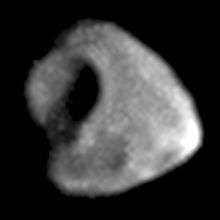 |
49.3±2 | moon of Jupiter | [108] · M | |
| Lutetia 21 |
49±1 | 1700±17 | belt asteroid type M | [172] · [173] | |
| Luscinia 713 |
48.984±0.438 | outer belt asteroid type C | [174] · M | ||
| Kalypso 53 |
48.631±13.299 | ≈ 5630±5000 | belt asteroid type XC | [175] · [73] | |
| Laurentia 162 |
48.511±0.247 | belt asteroid type STU/type Ch[176] | [176] · M | ||
| Tercidina 345 |
48.4325±0.4905 | 2680±1180 | belt asteroid type C | [86] · [73] | |
| Notburga 626 |
48.42±2.335 | 3240±1300 | belt asteroid type CX/type Xc | [73] · [73] | |
| Henrietta 225 |
47.967±0.625 | belt asteroid type F; Cybele asteroid | [177] · M | ||
| Abastumani 1390 |
47.925±1.142 | outer belt asteroid type P | [178] · M | ||
| Euforbo 4063 |
47.809±0.339 | Jupiter trojan (L4) type D | [179] · M | ||
| Tisiphone 466 |
47.748±0.175 | belt asteroid type C | [180] · M | ||
| Adria 143 |
47.689±0.349 | belt asteroid type C | [181] · M | ||
| Arsinoë 404 |
47.485±0.476 | 3420±3030 | belt asteroid type C | [182] · [73] | |
| Artemis 105 |
47.432±11.611 | 1540±540 | belt asteroid type C | [183] · [73] | |
| Proserpina 26 |
47.4±0.85 | 748±895 | belt asteroid type S | [184] · [73] | |
| Philosophia 227 |
47.318±1.278 | belt asteroid | [86] · M | ||
| Kolga 191 |
47.268±0.217 | belt asteroid type XC/type Cb | [185] · M | ||
| Andromache 175 |
47.266±0.542 | belt asteroid type C | [186] · M | ||
| Kassandra 114 |
47.089±0.477 | belt asteroid type T | [187] · M | ||
| Juliet Uranus XI |
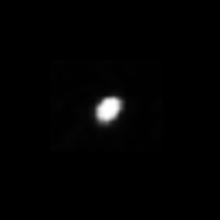 |
46.8±4 | moon of Uranus | [5] · M | |
| Urania 30 |
46.394±1.02 | 1740±490 | belt asteroid type S | [188] · [73] | |
| Irmintraud 773 |
45.836±0.45 | belt asteroid type D/type T | [189] · M | ||
| Ausonia 63 |
45.816±2.181 | 1530±150 | belt asteroid type S | [86] · [73] | |
| Polyxena 595 |
45.324±0.724 | outer belt asteroid | [190] · M | ||
| Beatrix 83 |
44.819±1.326 | belt asteroid type X | [86] · M | ||
| Concordia 58 |
44.806±0.419 | belt asteroid type C | [86] · M | ||
| Teucer 2797 |
44.715±0.378 | Jupiter trojan (L4) type D | [191] · M | ||
| Echidna Typhon I |
 |
44.5±3 | moon of 42355 Typhon | [115] · M | |
| Alkeste 124 |
.jpg) |
44.324±0.826 | belt asteroid type S | [192] · M | |
| Automedon 2920 |
44.287±0.898 | Jupiter trojan (L4) type D | [193] · M | ||
| Vanadis 240 |
43.964±0.808 | 1100±920 | belt asteroid type C | [194] · [73] | |
| Ottilia 401 |
43.902±0.218 | belt asteroid type C | [195] · M | ||
| 90 Antiope | 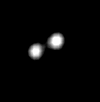 |
43.9±0.5 | 828±22 | belt asteroid type C; binary | [196] · [196] |
| Kythera 570 |
43.743±0.392 | outer belt asteroid type T | [197] · M | ||
| Hermentaria 346 |
43.224±0.963 | 6330±180 | belt asteroid type S | [198] · [73] | |
| Prometheus Saturn XVI |
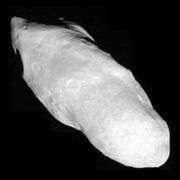 |
43.1±2.7 | 159.5±1.5 | moon of Saturn | [25] · [25] |
| Lydia 110 |
43.045±1 | belt asteroid type M/type X | [199] · M | ||
| Elara Jupiter VII |
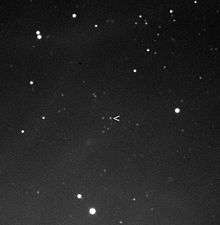 |
≈ 43 | moon of Jupiter | [5] · M | |
| Danaë 61 |
42.969±1.076 | 2890±2780 | belt asteroid type S | [200] · [73] | |
| Hekate 100 |
42.867±0.981 | belt asteroid type S | [201] · M | ||
| Thetis 17 |
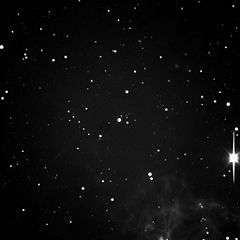 |
42.449±1.014 | 1200 | belt asteroid type S | [202] · [53] |
| Pandora 55 |
42.397±1.251 | belt asteroid type M | [203] · M | ||
| Huenna 379 |
42.394±0.779 | 383±19 | belt asteroid type B/type C; binary | [204] · [101] | |
| Virginia 50 |
42.037±0.121 | 2310±700 | belt asteroid type X/type Ch | [205] · [73] | |
| Feronia 72 |
41.975±2.01 | ≈ 3320±8490 | belt asteroid type TDG | [73] · [73] | |
| Hera 103 |
41.954±1.046 | belt asteroid type S | [206] · M | ||
| S/2000 (90) 1 Antiope I |
 |
41.9±0.5 | secondary of 90 Antiope | [196] · M | |
| Miriam 102 |
41.298±0.2 | belt asteroid type P/type C | [207] · M | ||
| Felicitas 109 |
41.294±0.308 | belt asteroid type GC/type Ch[208] | [208] · M | ||
| Poulydamas 4348 |
41.016±0.313 | Jupiter trojan (L5) type C | [209] · M | ||
| Logos 58534 |
41±9 | 458±6.9 | cubewano; binary | [210] · [210] | |
| Pandora Saturn XVII |
40.7±1.5 | 137.1±1.9 | moon of Saturn | [25] · [25] | |
| Thalassa Neptune IV |
40.7±2.8 | moon of Neptune | [97] · M | ||
| S/2007 (119979) 1 2002 WC19 I |
≈ 40.5 | moon of (119979) 2002 WC19 | [67] · M | ||
| Gallia 148 |
40.435±0.52 | ≈ 4890±1670 | belt asteroid type GU/type S | [82] · [73] | |
| Niobe 71 |
40.43±0.4 | belt asteroid type S | [82] · M | ||
| Asbolus 8405 |
40.415 | centaur | [211] · M | ||
| Pomona 32 |
40.38±0.8 | belt asteroid type S | [212] · M | ||
| Belinda Uranus XIV |
 |
40.3±8 | moon of Uranus | [5] · M | |
| Thyra 115 |
39.915±0.7 | belt asteroid type S | [213] · M | ||
| Cressida Uranus IX |
39.8±2 | moon of Uranus | [5] · M | ||
| Hertha 135 |
39.62±1 | belt asteroid type M | [214] · M | ||
| Amycus 55576 |
38.15±6.25 | centaur | [59] · M | ||
| Hylonome 10370 |
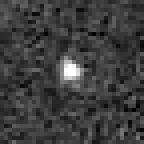 |
37.545 | centaur | [215] · M | |
| Gaussia 1001 |
36.356±0.149 | outer belt asteroid type PC | [216] · M | ||
| Klio 84 |
39.16±0.48 | belt asteroid type G/type Ch | [82] · M | ||
| 1974 FV1 3708 |
37.831±0.404 | Jupiter trojan (L5) type C | [86] · M | ||
| Nysa 44 |
37.83±0.37 | belt asteroid type E | [82] · M | ||
| Hecuba 108 |
37.749±0.946 | belt asteroid type S | [217] · M | ||
| Cyrene 133 |
36.088±0.466 | belt asteroid type S | [218] · M | ||
| Rosalind Uranus XIII |
36±6 | moon of Uranus | [5] · M | ||
| Caliban Uranus XVI |
≈ 36 | moon of Uranus | [5] · M | ||
| Maja 66 |
35.895±0.46 | belt asteroid type C | [82] · M | ||
| Sirona 116 |
35.85±2.9 | belt asteroid type S | [219] · M | ||
| Ariadne 43 |
35.67±0.627 | ≈ 1210±220 | belt asteroid type S | [220] · [73] | |
| Iphigenia 112 |
35.535±0.26 | ≈ 1970±6780 | belt asteroid type C | [73] · [73] | |
| Gerda 122 |
35.338±0.456 | belt asteroid type ST/type L[221] | [221] · M | ||
| Sappho 80 |
34.282±0.517 | belt asteroid type S | [222] · M | ||
| Dike 99 |
33.677±0.208 | belt asteroid type C | [223] · M | ||
| Zoe Logos I |
≈ 33.5 | moon of 58534 Logos | [210] · M | ||
| Desdemona Uranus X |
32±4 | moon of Uranus | [5] · M | ||
| Helena 101 |
32.92±0.65 | belt asteroid type S | [224] · M | ||
| Echeclus 60558 or 174P |
32.3±0.8 | centaur | [96] · M | ||
| Eurybates 3548 |
 |
31.943±0.149 | Jupiter trojan (L4) type CP | [86] · M | |
| Eurynome 79 |
31.739±0.476 | belt asteroid type S | [225] · M | ||
| Eurydike 75 |
31.189±0.802 | belt asteroid type M | [226] · M | ||
| Thereus 5145 |
31±3 | centaur | [96] · M | ||
| Halimede Neptune IX |
≈ 31 | moon of Neptune | [5] · M | ||
| Crantor 82982 |
30.795 | centaur | [227] · M | ||
| Frigga 77 |
.png) |
30.695±0.089 | ≈ 1740±680 | belt asteroid type MU/type Xe[228] | [228] · [73] |
| Phocaea 25 |
30.527±1.232 | 599±60 | belt asteroid type S | [86] · [73] | |
| Naiad Neptune III |
30.2±3.2 | moon of Neptune | [97] · M | ||
| Schwassmann– Wachmann 1 29P |
30.2±3.7 | comet | [229] · M | ||
| Hale–Bopp C/1995 O1 |
 |
30±10 | comet | [230] · M | |
| Neso Neptune XIII |
≈ 30 | moon of Neptune | [5] · M | ||
| Angelina 64 |
29.146±0.541 | belt asteroid type E | [231] · M | ||
| Alkmene 82 |
28.811±0.357 | belt asteroid type S | [232] · M | ||
| Althaea 119 |
28.65±0.55 | belt asteroid type S | [233] · M | ||
| Nessus 7066 |
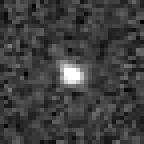 |
28.5±8.5 | centaur | [96] · M | |
| Asia 67 |
28.155±0.198 | ≈ 1030±100 | belt asteroid type S | [234] · [73] | |
| Polana 142 |
27.406±0.139 | belt asteroid type F | [235] · M | ||
| Bianca Uranus VIII |
 |
27±2 | moon of Uranus | [5] · M | |
| Tolosa 138 |
26.453±0.524 | 493±259 | belt asteroid type S | [236] · [73] | |
| Mathilde 253 |
26.4 | 103.3±4.4 | belt asteroid type C | [237] · [238] | |
| Hidalgo 944 |
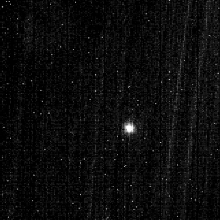 |
26.225±1.8 | centaur, first to be discovered in 1920; historically called asteroid. | [82] · M | |
| Piazzia 1000 |
25.775±0.43 | belt asteroid type C | [82] · M | ||
| Orus 21900 |
 |
25.405±0.405 | Jupiter trojan (L4) type C/type D | [86] · M | |
| Amalthea 113 |
25.069±0.633 | belt asteroid type S; Flora family; binary | [86] · M | ||
| Prospero Uranus XVIII |
 |
≈ 25 | moon of Uranus | [5] · M | |
| Liberatrix 125 |
24.209±0.267 | belt asteroid type M | [86] · M | ||
| Setebos Uranus XIX |
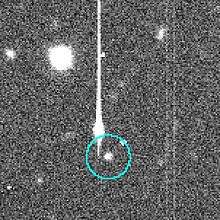 |
≈ 24 | moon of Uranus | [5] · M | |
| Carme Jupiter XI |
 |
≈ 23 | 130 | moon of Jupiter | [5] · M |
| Elatus 31824 |
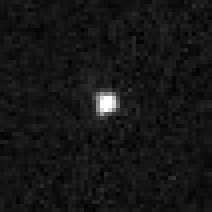 |
22.935 | centaur | [239] · M | |
| Brunhild 123 |
22.605±0.942 | belt asteroid type S | [240] · M | ||
| Velleda 126 |
≈ 22.41±0.65 | belt asteroid type S | [241] · M | ||
| Klytia 73 |
22.295±0.471 | belt asteroid type S | [242] · M | ||
| Sao Neptune XI |
≈ 22 | moon of Neptune | [5] · M | ||
| Echo 60 |
21.609±0.286 | 315±32 | belt asteroid type S | [243] · [73] | |
| Metis Jupiter XVI |
21.5±2 | ≈ 119.893 | moon of Jupiter | [108] · [244] | |
| Aethra 132 |
21.435±0.8 | ≈ 410±2710 | belt asteroid type M | [245] · [73] | |
| Ophelia Uranus VII |
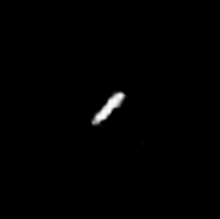 |
21.4±4 | moon of Uranus | [5] · M | |
| Laomedeia Neptune XII |
≈ 21 | moon of Neptune | [5] · M | ||
| Peitho 118 |
20.106±0.246 | belt asteroid type S | [246] · M | ||
| Cordelia Uranus VI |
20.1±3 | moon of Uranus | [5] · M | ||
| Lacrimosa 208 |
20.028±0.297 | belt asteroid type S; Koronis family | [247] · M | ||
| Pasiphae Jupiter VIII |
≈ 20 | moon of Jupiter | [5] · M | ||
| Siarnaq Saturn XXIX |
≈ 20 | moon of Saturn | [5] · M | ||
| Psamathe Neptune X |
≈ 20 | moon of Neptune | [5] · M |
From 1 to 19 km
This list contains some examples of Solar System objects between 1 and 19 km in radius. This is a common size for asteroids, comets, and moons.
| Body[note 1] | Image | Radius[note 2] (km) |
Mass (1015 kg) |
Type – notes | Refs[note 6] r · M |
|---|---|---|---|---|---|
| Urda 167 |
19.968±0.132 | belt asteroid type S; Koronis family | [248] · M | ||
| Hydra Pluto III |
 |
19.65 | 48±42 | moon of Pluto | [249] · [250] |
| Koronis 158 |
19.513±0.231 | belt asteroid type S; Koronis family | [251] · M | ||
| Nix Pluto II |
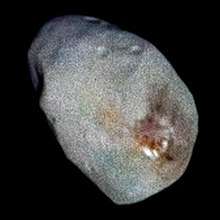 |
19.017 | 45±40 | moon of Pluto | [249] · [250] |
| Sinope Jupiter IX |
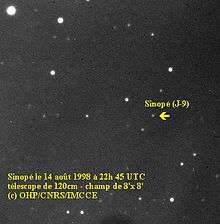 |
≈ 19 | moon of Jupiter | [5] · M | |
| Ganymed 1036 |
18.838±0.199 | ≈ 167±318 | Amor asteroid type S | [86] · [73] | |
| Austria 136 |
18.447±0.259 | belt asteroid type M | [252] · M | ||
| Okyrhoe 52872 |
18±0.6 | centaur | [253] · M | ||
| Lysithea Jupiter X |
 |
≈ 18 | moon of Jupiter | [5] · M | |
| Helene Saturn XII |
 |
17.6±0.4 | moon of Saturn; Dione trojan (L4) | [25] · M | |
| Hippocamp Neptune XIV |
17.4 | ≈ 50 | moon of Neptune | [97] · [97] | |
| Leucus 11351 |
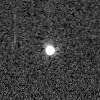 |
17.078±0.323 | Jupiter trojan (L4) type D | [86] · M | |
| Albiorix Saturn XXVI |
≈ 16 | moon of Saturn | [5] · M | ||
| Stephano Uranus XX |
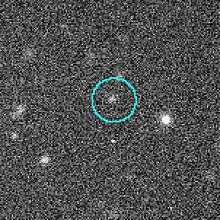 |
≈ 16 | moon of Uranus | [5] · M | |
| S/2002 (121) 1 Hermione I |
≈ 16 | asteroid moon of 121 Hermione | [100] · M | ||
| Arrokoth 486958 |
15.85±0.25 | cubewano; contact binary; New Horizons flyby | [254] · M | ||
| Weringia 226 |
15.747±0.155 | belt asteroid type S | [255] · M | ||
| Ida 243 |
15.7 | 42±6 | belt asteroid type S; Koronis family; binary; Galileo flyby | [256] · [257] | |
| Vala 131 |
15.669±0.152 | belt asteroid type SU/type Xc[241] | [258] · M | ||
| Comas Solà 1655 |
15.3±1.1 | belt asteroid type B | [259] · M | ||
| Beethoven 1815 |
15.299±0.084 | belt asteroid type F | [86] · M | ||
| Atlas Saturn XV |
15.1±0.9 | 6.6 | moon of Saturn | [25] · [25] | |
| Pan Saturn XVIII |
14.1±1.3 | 4.95 | moon of Saturn | [25] · [260] | |
| Linus Kalliope I |
14±1 | ≈ 60 | asteroid moon of 22 Kalliope | [107] · [261] | |
| Dioretsa 20461 |
14±3 | centaur; damocloid | [262] · M | ||
| Ananke Jupiter XII |
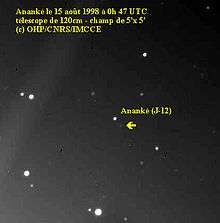 |
≈ 14 | moon of Jupiter | [5] · M | |
| Perdita Uranus XXV |
13±1 | moon of Uranus | [5] · M | ||
| Telesto Saturn XIII |
12.4±0.4 | moon of Saturn; Tethys trojan (L4) | [25] · M | ||
| Mab Uranus XXVI |
12±1 | moon of Uranus | [5] · M | ||
| Medusa 149 |
11.859±0.134 | belt asteroid type S | [263] · M | ||
| Phobos Mars I |
11.267 | 10.659 | moon of Mars | [264] · [265] | |
| Paaliaq Saturn XX |
≈ 11 | moon of Saturn | [5] · M | ||
| Francisco Uranus XXII |
≈ 11 | moon of Uranus | [5] · M | ||
| Calypso Saturn XIV |
10.7±0.7 | moons of Saturn; Tethys trojan (L5) | [25] · M | ||
| Polymele 15094 |
 |
10.548±0.068 | Jupiter trojan (L4) type P | [87] · M | |
| Leda Jupiter XIII |
≈ 10 | moon of Jupiter | [5] · M | ||
| Margaret Uranus XXIII |
≈ 10 | moon of Uranus | [5] · M | ||
| Ferdinand Uranus XXIV |
≈ 10 | moon of Uranus | [5] · M | ||
| Euler 2002 |
9.887±0.029 | belt asteroid type S | [266] · M | ||
| S/2000 (762) 1 Pulcova I |
 |
9.5±3.5 | asteroid moon of 762 Pulcova | [114] · M | |
| Cupid Uranus XXVII |
9±1 | moon of Uranus | [5] · M | ||
| Ymir Saturn XIX |
≈ 9 | moon of Saturn | [5] · M | ||
| Trinculo Uranus XXI |
≈ 9 | moon of Uranus | [5] · M | ||
| Romulus Sylvia I |
≈ 9 | 93.19+207 −83 |
asteroid moon of 87 Sylvia | [267] · [267] | |
| Eros 433 |
.jpg) |
8.42±0.02 | 6.687±0.003 | Amor asteroid type S; NEAR Shoemaker orbited and landed | [268] · [268] |
| Adrastea Jupiter XV |
8.2±2 | moon of Jupiter | [5] · M | ||
| Kiviuq Saturn XXIV |
≈ 8 | moon of Saturn | [5] · M | ||
| S/2001 (107) 1 Camilla I |
8±3 | asteroid moon of 107 Camilla | [269] · M | ||
| Tarvos Saturn XXI |
≈ 7.5 | moon of Saturn | [5] · M | ||
| Herschel 2000 |
7.384 | belt asteroid | [86] · M | ||
| 2002 RP120 65407 |
7.3±1.4 | damocloid | [270] · M | ||
| Kerberos Pluto IV |
.jpg) |
≈ 6.333 | 16±9 | moon of Pluto | [271] · [272] |
| Gaspra 951 |
6.266 | 20–30 | belt asteroid type S; Galileo flyby | [273] · [274] | |
| Deimos Mars II |
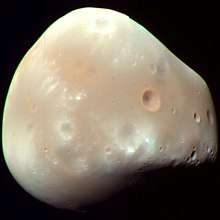 |
6.2±0.18 | 1.476 | moon of Mars | [5] · [275] |
| Skamandrios Hektor I |
6±1.5 | asteroid moon of 624 Hektor | [84] · M | ||
| Ijiraq Saturn XXII |
≈ 6 | moon of Saturn | [5] · M | ||
| Halley's Comet 1P |
5.75 | 0.22 | comet | [276] · [277] | |
| Styx Pluto V |
.jpg) |
≈ 5.5 | ≈ 7.65 | moon of Pluto | [271] · [272] |
| Masursky 2685 |
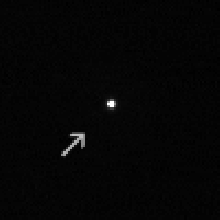 |
5.372±0.085 | belt asteroid type S; Cassini flyby | [278] · M | |
| Damocles 5335 |
≈ 5 | centaur; damocloid | [27] · M | ||
| Erriapus Saturn XXVIII |
≈ 5 | moon of Saturn | [5] · M | ||
| Alexhelios Kleopatra I |
4.45±0.8 | asteroid moon of 216 Kleopatra | [279] · M | ||
| Callirrhoe Jupiter XVII |
≈ 4.3 | moon of Jupiter | [5] · M | ||
| Comas Solà 32P |
4.2 | Jupiter-family comet | [280] · M | ||
| Esclangona 1509 |
4.085±0.3 | inner belt asteroid type S; binary | [281] · M | ||
| Misterrogers 26858 |
4.035±0.085 | Mars crosser type S | [82] · M | ||
| Themisto Jupiter XVIII |
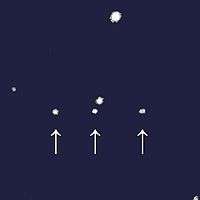 |
≈ 4 | moon of Jupiter | [5] · M | |
| Daphnis Saturn XXXV |
3.8±0.8 | 0.077±0.015 | moon of Saturn | [25] · [25] | |
| Petit-Prince Eugenia I |
3.5±1 | asteroid moon of 45 Eugenia | [95] · M | ||
| S/2003 (130) 1 Elektra I |
3.5±1.5 | asteroid moon of 130 Elektra | [282] · M | ||
| Bestla Saturn XXXIX |
≈ 3.5 | moon of Saturn | [5] · M | ||
| Remus Sylvia II |
≈ 3.5 | 73.3+47 −23 |
asteroid moon of 87 Sylvia | [267] · [267] | |
| Cleoselene Kleopatra II |
3.45±0.8 | asteroid moon of 216 Kleopatra | [279] · M | ||
| S/2019 (31) 1 Euphrosyne I |
3.35±1.2 | asteroid moon of 31 Euphrosyne | [283] · M | ||
| Tempel 1 9P |
.jpg) |
3±0.1 | Jupiter-family comet; Deep Impact flyby and impacted | [284] · M | |
| S/2006 S 1 (Lost moon) |
3 | 0.15 | Moon of Saturn | [285] · M | |
| S/2006 S 3 (Lost moon) |
3 | 0.15 | Moon of Saturn | [285] · M | |
| S/2004 S 13 (Lost moon) |
3 | 0.15 | Moon of Saturn | [285] · M | |
| S/2007 S 2 (Lost moon) |
3 | 0.15 | Moon of Saturn | [285] · M | |
| S/2004 S 7 (Lost moon) |
3 | 0.15 | Moon of Saturn | [285] · M | |
| Phaethon 3200 |
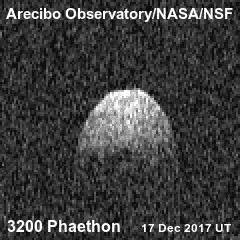 |
2.9 | Apollo asteroid type F | [286] · M | |
| S/2003 (379) 1 Huenna I |
2.9±0.6 | asteroid moon of 379 Huenna | [287] · M | ||
| 1999 JM8 53319 |
2.7±0.6 | Apollo asteroid type X | [288] · M | ||
| Borrelly 19P |
 |
2.66 | Jupiter-family comet | [289] · M | |
| S/2014 (130) 1 Elektra II |
2.6±0.6 | asteroid moon of 130 Elektra | [282] · M | ||
| Šteins 2867 |
.png) |
2.58±0.084 | belt asteroid type E; Rosetta flyby | [86] · M | |
| S/2004 (45) 1 Eugenia II |
2.5±1 | asteroid moon of 45 Eugenia | [95] · M | ||
| S/2004 S 12 (Lost moon) |
2.5 | 0.09 | Moon of Saturn | [285] · M | |
| S/2007 S 3 (Lost moon) |
2.5 | 0.09 | Moon of Saturn | [285] · M | |
| Atira 163693 |
2.4±0.25 | Atira asteroid type S; binary | [290] · M | ||
| Annefrank 5535 |
2.4 | belt asteroid type S Stardust flyby | [291] · M | ||
| Encke 2P |
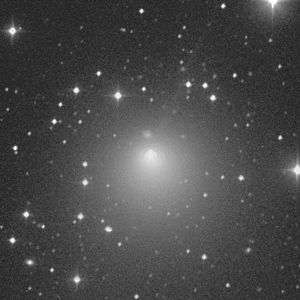 |
≈ 2.4 | comet | [292] · M | |
| Comet Hyakutake C/1996 B2 |
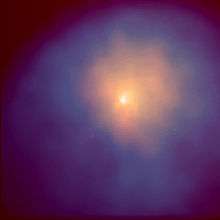 |
≈ 2.4 | comet | [293] · M | |
| Balam 3749 |
2.332±0.107 | 0.51±0.02 | belt asteroid type S; trinary | [294] · [295] | |
| Pallene Saturn XXXIII |
 |
2.22±0.07 | moon of Saturn | [296] · M | |
| Florence 3122 |
2.201±0.015 | 0.079±0.002 | Amor asteroid type S; trinary | [74] · [297] | |
| Wild 2 81P |
 |
2.133 | Jupiter family comet; Stardust flyby | [298] · M | |
| Litva 2577 |
2.115 | Mars-crosser type EU; Hungaria family; trinary | [299] · M | ||
| Hal 9000 |
2.055 | Inner belt asteroid type S; Flora family | [300] · M | ||
| Littlewood 26993 |
2.0035 | Main-belt asteroid | [301] · M | ||
| Churyumov–Gerasimenko 67P |
2 | 0.00998 | Jupiter-family comet | [302] · [303] | |
| Eirene Jupiter LVII |
2 | 0.09 | Moon of Jupiter | [304] · M | |
| S/2004 S 17 (Lost moon) |
2 | 0.05 | Moon of Saturn | [285] · M | |
| Donaldjohanson 52246 |
1.948±0.007 | belt asteroid type C | [305] · M | ||
| Toro 1685 |
1.905±0.025 | Apollo asteroid type S | [74] · M | ||
| Cuno 4183 |
1.826±0.051 | Apollo asteroid type S/type Q | [306] · M | ||
| Aegis Minerva I |
1.8±0.5 | asteroid moon of 93 Minerva | [307] · M | ||
| S/2016 (107) 1 Camilla II |
1.75±0.25 | asteroid moon of 107 Camilla | [269] · M | ||
| LINEAR 118401 or 176P |
1.75±0.05 | belt asteroid; comet; Themis family | [308] · M | ||
| Holmes 17P |
≈ 1.71 | Jupiter-family comet | [309] · M | ||
| Gorgoneion Minerva II |
1.6±0.45 | asteroid moon of 93 Minerva | [307] · M | ||
| 1986 DA 6178 |
1.575 | Amor asteroid type M | [310] · M | ||
| Pichi üñëm Alauda I |
1.55±0.45 | asteroid moon of 702 Alauda | [311] · M | ||
| Toutatis 4179 |
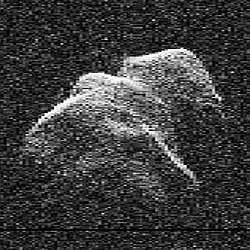 |
1.516 | 0.0505 | Apollo asteroid type S; Chang'e 2 flyby | [312] · [312] |
| Kaʻepaokaʻawela 514107 |
≈ 1.5 | retrograde Jupiter co-orbital | [313] · M | ||
| S/2016 J 1 Jupiter LIV |
1.5 | 0.015 | Moon of Jupiter | [304] · M | |
| Methone Saturn XXXII |
1.45±0.03 | moon of Saturn | [296] · M | ||
| 1998 QE2 285263 |
1.375 | Amor asteroid type S; binary | [314] · M | ||
| Polydeuces Saturn XXXIV |
1.3±0.4 | moon of Saturn; Dione trojan (L5) | [25] · M | ||
| 2001 SN263 153591 |
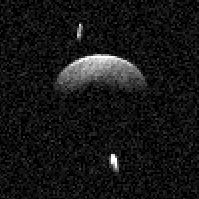 |
1.315±0.2 | 0.00951±0.00013 | Amor asteroid type C; trinary | [315] · [316] |
| S/2003 (1509) 1 Esclangona I |
≈ 1.285 | asteroid moon of 1509 Esclangona | [317] · M | ||
| APL 132524 |
≈ 1.25 | belt asteroid type S; New Horizons flyby | [318] · M | ||
| Magellan 4055 |
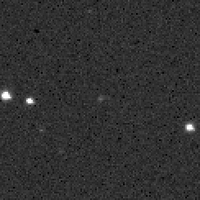 |
1.245 | Amor asteroid type V | [319] · M | |
| Camillo 3752 |
1.153±0.044 | Apollo asteroid type S | [74] · M | ||
| 2002 VU94 90075 |
1.117±0.042 | Apollo asteroid type S | [320] · M | ||
| Cruithne 3753 |
1.036±0.053 | Aten asteroid type Q; quasi-satellite of Earth | [321] · M | ||
| Zephyr 12923 |
1.03±0.007 | Apollo asteroid type S | [74] · M | ||
| Ersa Jupiter LXXI |
1 | 0.015 | Moon of Jupiter | [304] · M | |
| Pandia Jupiter LXV |
1 | 0.015 | Moon of Jupiter | [304] · M | |
| S/2017 J 7 Jupiter LXVIII |
1 | 0.015 | Moon of Jupiter | [304] · M | |
| S/2017 J 6 Jupiter LXVII |
1 | 0.015 | Moon of Jupiter | [304] · M | |
| S/2017 J 3 Jupiter LXIV |
1 | 0.015 | Moon of Jupiter | [304] · M | |
| S/2017 J 5 Jupiter LXVI |
1 | 0.015 | Moon of Jupiter | [304] · M | |
| S/2017 J 2 Jupiter LXIII |
1 | 0.015 | Moon of Jupiter | [304] · M | |
| S/2017 J 1 Jupiter LIX |
1 | 0.015 | Moon of Jupiter | [304] · M | |
| S/2017 J 9 Jupiter LXX |
1 | 0.015 | Moon of Jupiter | [304] · M | |
| S/2010 J 1 Jupiter LI |
1 | Moon of Jupiter | [304] · M | ||
| Eupheme Jupiter LX |
1 | 0.015 | Moon of Jupiter | [304] · M | |
| S/2003 J 18 Jupiter LV |
1 | 0.015 | Moon of Jupiter | [304] · M | |
| S/2003 J 19 Jupiter LXI |
1 | 0.015 | Moon of Jupiter | [304] · M | |
| Philophrosyne Jupiter LVIII |
1 | 0.015 | Moon of Jupiter | [304] · M | |
| S/2003 J 2 (Lost moon) |
1 | 0.015 | Moon of Jupiter | [304] · M | |
| S/2003 J 4 (Lost moon) |
1 | 0.015 | Moon of Jupiter | [304] · M | |
| S/2003 J 23 (Lost moon) |
1 | 0.015 | Moon of Jupiter | [304] · M | |
| S/2003 J 10 (Lost moon) |
1 | 0.015 | Moon of Jupiter | [304] · M | |
| S/2003 J 16 (Lost moon) |
1 | 0.015 | Moon of Jupiter | [304] · M | |
| Euporie Jupiter XXXIV |
1 | 0.015 | Moon of Jupiter | [304] · M | |
| Thelxinoe Jupiter XLII |
1 | 0.015 | Moon of Jupiter | [304] · M | |
| Mneme Jupiter XL |
1 | 0.015 | Moon of Jupiter | [304] · M | |
| Herse Jupiter L |
1 | 0.015 | Moon of Jupiter | [304] · M | |
| Kale Jupiter XXXVII |
1 | 0.015 | Moon of Jupiter | [304] · M | |
| Kallichore Jupiter XLIV |
1 | 0.015 | Moon of Jupiter | [304] · M | |
| Pasithee Jupiter XXXVIII |
1 | 0.015 | Moon of Jupiter | [304] · M | |
| Kore Jupiter XLIX |
1 | 0.015 | Moon of Jupiter | [304] · M |
Below 1 km
This list contains examples of objects below 1 km in radius. That means that irregular bodies can have a longer chord in some directions, hence the mean radius averages out.
In the asteroid belt alone there are estimated to be between 1.1 and 1.9 million objects with a radius above 0.5 km,[322] many of which are in the range 0.5–1.0 km. Countless more have a radius below 0.5 km.
Very few objects in this size range have been explored or even imaged. The exceptions are objects that have been visited by a probe, or have passed close enough to Earth to be imaged. Radius is by mean geometric radius. Number of digits not an endorsement of significant figures. Mass scale shifts from × 1015 to 109 kg, which is equivalent to one billion kg or 1012 grams (Teragram – Tg).
Currently most of the objects of mass between 109 kg to 1012 kg (less than 1000 teragrams (Tg)) listed here are near-Earth asteroids (NEAs). The Aten asteroid 1994 WR12 has less mass than the Great Pyramid of Giza, 5.9 × 109 kg.
For more about very small objects in the Solar System, see meteoroid, micrometeoroid, and interplanetary dust cloud. (See also Visited/imaged bodies.)
| Body[note 1] | Image | Radius[note 2] (m) |
Mass (109 kg) |
Type – notes | Refs[note 6] r · M |
|---|---|---|---|---|---|
| Ra-Shalom 2100 |
990±25 | Aten asteroid type C | [82] · M | ||
| Geographos 1620 |
980±30 | Apollo asteroid type S | [86] · M | ||
| Midas 1981 |
975±35 | Apollo asteroid type S | [82] · M | ||
| Mithra 4486 |
924.5±11 | Apollo asteroid type S | [74] · M | ||
| S/2002 (3749) 1 Balam I |
≈ 920 | asteroid moon of 3749 Balam | [295] · M | ||
| 1998 OH 12538 |
831.5±164.5 | Apollo asteroid type S | [74] · M | ||
| S/2008 (3749) 1 Balam II |
≈ 830 | asteroid moon of 3749 Balam | [295] · M | ||
| Tantalus 2102 |
824.5±22.5 | Apollo asteroid type Q | [323] · M | ||
| Braille 9969 |
820 | Mars-crosser type Q; Deep Space 1 flyby | [324] · M | ||
| 2005 GO21 308242 |
780 | Aten asteroid type S | [325] · M | ||
| Apollo 1862 |
≈ 750 | Apollo asteroid type Q | [326] · M | ||
| 1999 JD6 85989 |
731±10.5 | Aten asteroid type K; contact binary | [327] · M | ||
| Icarus 1566 |
730 | Apollo asteroid type S | [328] · M | ||
| Dactyl Ida I |
700 | asteroid moon of 243 Ida | [329] · M | ||
| Castalia 4769 |
≈ 700 | Apollo asteroid type S; contact binary | [330] · M | ||
| S/2009 (2577) 1 Litva I |
≈ 700 | asteroid moon of 2577 Litva | [331] · M | ||
| 2007 PA8 214869 |
675±70 | Apollo asteroid type Q | [332] · M | ||
| Moshup 66391 |
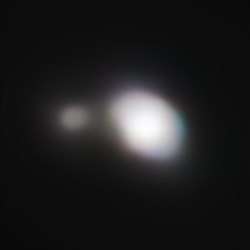 |
658.5±20 | 2490±54 | Aten asteroid type S; binary | [333] · [334] |
| 1950 DA 29075 |
.png) |
653 | ≈ 2000 | Apollo asteroid type S | [335] · [336] |
| 2006 HY51 394130 |
609±114 | Apollo asteroid | [337] · M | ||
| Wirtanen 46P |
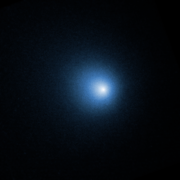 |
≈ 600 | Jupiter-family comet | [338] · M | |
| S/2012 (2577) 1 Litva II |
≈ 600 | asteroid moon of 2577 Litva | [331] · M | ||
| Hartley 2 103P |
570±80 | ≈ 300 | Jupiter-family comet; Deep Impact flyby | [339] · [339] | |
| S/2008 (153591) 1 2001 SN263 I |
 |
≈ 530 | asteroid moon of (153591) 2001 SN263 | [316] · M | |
| 2003 SD220 163899 |
515 | Aten asteroid type S | [340] · M | ||
| Nyx 3908 |
500±75 | Amor asteroid type V | [341] · M | ||
| S/2017 (163693) 1 Atira I |
500±150 | asteroid moon of 163693 Atira | [290] · M | ||
| Valetudo Jupiter LXII |
≈ 500 | moon of Jupiter | [342] · M | ||
| S/2017 J 8 Jupiter LXIX |
≈ 500 | moon of Jupiter | [342] · M | ||
| S/2010 J 2 Jupiter LII |
≈ 500 | moon of Jupiter | [342] · M | ||
| S/2003 J 12 (Lost moon) |
500 | 1500 | Moon of Jupiter | [304] · M | |
| S/2011 J 1 Jupiter LXXII |
500 | 1500 | Moon of Jupiter | [304] · M | |
| S/2011 J 2 Jupiter LVI |
500 | 1500 | Moon of Jupiter | [304] · M | |
| S/2003 J 9 (Lost moon) |
500 | 1500 | Moon of Jupiter | [304] · M | |
| 2001 WN5 153814 |
466±5.5 | Apollo asteroid | [343] · M | ||
| 1989 JA 7335 |
466±76.5 | Apollo asteroid type S | [74] · M | ||
| 2017 YE5 | 450±25 | Apollo asteroid type S; binary | [344] · M | ||
| Verenia 3551 |
≈ 450 | Amor asteroid type V | [345] · M | ||
| Ryugu 162173 |
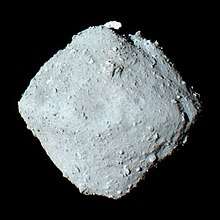 |
432.5±7.5 | ≈ 450 | Apollo asteroid type Cg; visited by Hayabusa2 | [346] · [347] |
| 1997 AE12 162058 |
423.5±6.5 | Amor asteroid type S | [348] · M | ||
| 2014 JO25 | .gif) |
409 | Apollo asteroid type S; contact binary | [349] · M | |
| Hermes 69230 |
400±50 | Apollo asteroid type Sq | [350] · M | ||
| 1998 RO1 66063 |
400±75 | 447 | Aten asteroid type S; binary | [351] · [351] | |
| Didymos 65803 |
390±4 | 527 | Apollo asteroid type Xk; binary | [352] · [353] | |
| Aten 2062 |
365±15 | Aten asteroid type S | [86] · M | ||
| Aegaeon Saturn LIII |
330±60 | moon of Saturn | [296] · M | ||
| 2015 TB145 |  |
325±15 | Apollo asteroid type S | [354] · M | |
| 1994 CC 136617 |
310±30 | 266±32.9 | Apollo asteroid type Sq; trinary | [355] · [356] | |
| 2001 WR1 172034 |
315.5±9 | Amor asteroid type S | [357] · M | ||
| 1992 FE 5604 |
≈ 275 | Aten asteroid type V | [358] · M | ||
| 1989 VA 99907 |
≈ 273.5 | Aten asteroid type Sq | [359] · M | ||
| Golevka 6489 |
265±15 | Apollo asteroid type Q | [360] · M | ||
| Bennu 101955 |
262.5±37.5 | 78±9 | Apollo asteroid type B; visited by OSIRIS-REx | [361] · [362] | |
| 2004 UL 374158 |
≈ 258 | Apollo asteroid type S | [363] · M | ||
| 2000 WO107 153201 |
255±41.5 | Aten asteroid type X | [364] · M | ||
| 2002 CU11 163132 |
230±8.5 | Apollo asteroid | [365] · M | ||
| S/2008 (153591) 2 2001 SN263 II |
 |
≈ 230 | asteroid moon of (153591) 2001 SN263 | [316] · M | |
| Squannit 1999 KW4 I |
 |
225.5±13.5 | asteroid moon of 66391 Moshup | [334] · M | |
| 1998 WT24 33342 |
_1998_WT24_bistatic_radar_image.gif) |
≈ 205 | Aten asteroid type E/type S | [366] · M | |
| 2014 HQ124 | 204.5±84 | Aten asteroid type S | [86] · M | ||
| 2013 YP139 | 201±13 | Apollo asteroid | [358] · M | ||
| 2008 EV5 341843 |
200±7 | Aten asteroid type X/type C | [74] · M | ||
| 2006 DP14 388188 |
≈ 200 | Apollo asteroid type S; contact binary | [367] · M | ||
| 1988 EG 6037 |
199.5±1.35 | Apollo asteroid type S | [368] · M | ||
| S/2001 (66063) 1 1998 RO1 I |
190±40 | asteroid moon of (66063) 1998 RO1 | [351] · M | ||
| 2010 TK7 | 189.5±61.5 | Aten asteroid; Earth trojan (L4) | [369] · M | ||
| 2006 HY51 394130 |
609±114 | Apollo asteroid | [337] · M | ||
| 2006 SU49 292220 |
≈ 188.5 | ≈ 73 | Apollo asteroid | [370] · [370] | |
| 2005 YU55 308635 |
180±20 | Apollo asteroid type C | [371] · M | ||
| 2010 SO16 | 178.5±63 | Apollo asteroid; co-orbital with Earth | [358] · M | ||
| Itokawa 25143 |
173 | 35.1±1.05 | Apollo asteroid type S; visited by Hayabusa | [372] · [372] | |
| Nereus 4660 |
≈ 165 | Apollo asteroid type Xe | [373] · M | ||
| Apophis 99942 |
162.5±7.5 | ≈ 61 | Aten asteroid type Sq | [374] · [375] | |
| S/2009 S 1 | ≈ 150 | moon of Saturn | [376] · M | ||
| S/2017 (3122) 2 Florence II |
≈ 150 | asteroid moon of 3122 Florence | [297] · M | ||
| 2005 WK4 | ≈ 142 | Apollo asteroid type S | [377] · M | ||
| 2004 BL86 357439 |
 |
131.5±13 | Apollo asteroid type V; binary | [378] · M | |
| 2007 TU24 | 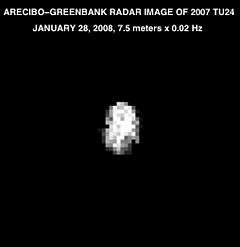 |
≈ 125 | Apollo asteroid type S | [379] · M | |
| 2002 VE68 | ≈ 118 | Aten asteroid type X; co-orbital with Venus | [380] · M | ||
| 2011 UW158 436724 |
.gif) |
110±20 | Apollo asteroid type S | [381] · M | |
| S/2017 (3122) 1 Florence I |
≈ 100 | asteroid moon of 3122 Florence | [297] · M | ||
| S/2003 (65803) 1 Didymos I |
85±15 | asteroid moon of 65803 Didymos | [353] · M | ||
| 2009 FD 410777 |
≈ 80 | ≈ 3.2 | Apollo asteroid type C; binary | [382] · [382] | |
| 2017 BQ6 | 78 | Apollo asteroid type S | [383] · M | ||
| 1994 WR12 | ≈ 65 | ≈ 2.9 | Aten asteroid | [384] · [384] | |
| YORP 54509 |
61.833 | Apollo asteroid type S | [385] · M | ||
| S/2009 (136617) 1 1994 CC I |
56.5±15 | asteroid moon of (136617) 1994 CC | [356] · M | ||
| S/2015 (357439) 1 2004 BL86 I |
 |
≈ 45 | asteroid moon of (357439) 2004 BL86 | [386] · M | |
| S/2015 (410777) 1 2009 FD I |
45±15 | asteroid moon of (410777) 2009 FD | [387] · M | ||
| 2011 XC2 | ≈ 42.5 | ≈ 0.84 | Apollo asteroid | [388] · [388] | |
| Kamoʻoalewa 469219 |
41 | Apollo asteroid type S; quasi-satellite of Earth | [389] · M | ||
| S/2009 (136617) 2 1994 CC II |
40±15 | asteroid moon of (136617) 1994 CC | [356] · M | ||
| 2002 MN | ≈ 36.5 | ≈ 0.54 | Apollo asteroid | [390] · [390] | |
| 2015 HM10 | ≈ 28.5 | Apollo asteroid/Amor asteroid type S | [391] · M | ||
| Duende 367943 |
23.75 | Aten asteroid/Atira asteroid type L | [393] · M | ||
| 2000 SG344 | ≈ 20 | ≈ 0.071 | Aten asteroid | [394] · [394] | |
| 2016 CW30 | ≈ 16 | Apollo asteroid | [395] · M | ||
| 1998 KY26 | ≈ 15 | Apollo asteroid type X | [396] · M | ||
| 2010 AL30 | ≈ 15 | Apollo asteroid | [397] · M | ||
| 2011 YQ1 | ≈ 15 | Apollo asteroid | [398] · M | ||
| 2015 XA378 | ≈ 14 | Apollo asteroid | [399] · M | ||
| 2009 RR | ≈ 13 | ≈ 0.024 | Apollo asteroid | [400] · [400] | |
| 2012 TC4 | 11.5 | Apollo asteroid type E/type Xe | [401] · M | ||
| 2010 GA6 | ≈ 11 | Apollo asteroid | [402] · M | ||
| 2004 FH | 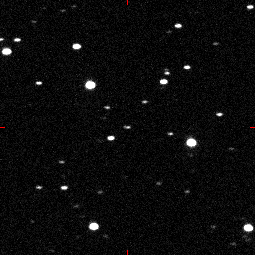 |
≈ 11 | Aten asteroid type S | [403] · M | |
| 2014 RC | ≈ 11 | Apollo asteroid type Sq | [404] · M | ||
| 2004 OD4 | ≈ 8.5 | Apollo asteroid | [405] · M | ||
| 2016 CA194 | ≈ 6 | Amor asteroid | [406] · M | ||
| 2009 TM8 | ≈ 4.5 | Apollo asteroid | [407] · M | ||
| 2006 JY26 | ≈ 3.5 | ≈ 0.00052 | Apollo asteroid | [408] · [408] | |
| 2010 RF12 | ≈ 3.5 | ≈ 0.0005 | Apollo asteroid | [409] · [409] | |
| 2011 MD | 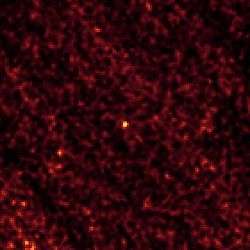 |
3+2 −1 |
Apollo asteroid/Amor asteroid type S | [410] · M | |
| 2015 TC25 | ≈ 2.5 | ≈ 0.00012 | Apollo asteroid type E | [411] · [411] | |
| 2008 TC3 | 2.05 | 0.00008 | Apollo asteroid type F/type M; impacted Earth in 2008 | [412] · [412] | |
| 2019 AS5 | ≈ 0.76 | Apollo asteroid | [413] · M | ||
| 2011 CQ1 | ≈ 0.5 | Aten asteroid | [414] · M | ||
| 2008 TS26 | ≈ 0.49 | Apollo asteroid | [415] · M |
Surface gravity
The surface gravity at the equator of a body can in most cases be accurately calculated using Newton's law of universal gravitation and centrifugal force.
The gravitational acceleration at the equator is given by Newton's law of universal gravitation. The formula that follows from this law is:
where
- ag is the magnitude of the gravitational acceleration
- G is the gravitational constant
- m is the mass of the celestial body
- r is the equatorial radius of the celestial body (if this varies significantly, the mean equatorial radius is used)
The magnitude of the outward acceleration due to centrifugal force is given by
where
- T is the rotation period of the celestial body
The surface gravity at the equator is then given by:
See also
Notes
- Radius estimated using equatorial radius and assuming body is spherical
- Radius has been determined by various methods, such as optical (Hubble), thermal (Spitzer), or direct imaging via spacecraft
- Radius estimated by using three radii and assuming body is spheroid
- Best fit, assuming Haumea is in hydrostatic equilibrium
- Calculated in Wolfram Alpha using semi axes of 1050 × 840 × 537 (Ellipsoid volume: 1.98395×10^9 km³)
- The mass estimate is based on the assumed density of 1.2 g/cm³, and a volume of 3.5 ×106 km³ obtained from a detailed shape model in Stooke (1994).[98]
- The mean radius of 76.25±5, or mean diameter of 152.5±10, is derived from the given dimensions 218±7 × 87±3
- Name of body, including alternative names using Roman numerals to designate moons (such as "Saturn I" for Mimas), and numbers to designate minor planets
- Mean radius including uncertainties
- Given as surface gravity (1 bar for gaseous planets)
- Ranking by radius of the largest bodies in the Solar System; may not reflect the latest updates of measured radii
- Figures from default source Johnston's Archive—List of Known Trans-Neptunian Objects,[27] if otherwise not mentioned in the References column
- Reference column specifically for radius (r) and mass (M) citations
References
- Brown, M. "The Dwarf Planets". Caltech. Archived from the original on 2011-01-16. Retrieved 2008-09-25.
- "Iapetus' peerless equatorial ridge". The Planetary Society. Retrieved 2020-01-04.
- "Gǃkúnǁ'hòmdímà and Gǃò'é ǃhú". .lowell.edu. Retrieved 2020-01-04.
- Britt, D. T.; Consolmagno, G. J.; Merline, W. J. (2006). "Small Body Density and Porosity: New Data, New Insights" (PDF). Lunar and Planetary Science XXXVII. Archived from the original (PDF) on 2008-12-17. Retrieved 2008-12-16.
- "Planetary Satellite Physical Parameters". JPL (Solar System Dynamics). 2008-10-24. Retrieved 2008-12-16.
- Williams, D. R. (2007-11-23). "Uranian Satellite Fact Sheet". NASA (National Space Science Data Center). Archived from the original on 2010-01-05. Retrieved 2008-12-12.
- Brown, Michael E. "How many dwarf planets are there in the outer solar system?". California Institute of Technology. Retrieved 28 April 2019.
- Park, R. S.; Konopliv, A. S.; Bills, B. G.; Rambaux, N.; Castillo-Rogez, J. C.; Raymond, C. A.; Vaughan, A. T.; Ermakov, A. I.; Zuber, M. T.; Fu, R. R.; Toplis, M. J.; Russell, C. T.; Nathues, A.; Preusker, F. (2016). "A partially differentiated interior for (1) Ceres deduced from its gravity field and shape". Nature. 537 (7621): 515–517. Bibcode:2016Natur.537..515P. doi:10.1038/nature18955. PMID 27487219.
- "Iapetus' peerless equatorial ridge".
- "Uranus Fact Sheet".
- Emilio, M.; Kuhn, J. R.; Bush, R. I.; Scholl, I. F. (2012). "Measuring the Solar Radius from Space during the 2003 and 2006 Mercury Transits". The Astrophysical Journal. 750 (2): 135. arXiv:1203.4898. Bibcode:2012ApJ...750..135E. doi:10.1088/0004-637X/750/2/135.
- Nimmo, Francis; et al. (2017). "Mean radius and shape of Pluto and Charon from New Horizons images". Icarus. 287: 12–29. arXiv:1603.00821. Bibcode:2017Icar..287...12N. doi:10.1016/j.icarus.2016.06.027.
- https://nssdc.gsfc.nasa.gov/planetary/factsheet/plutofact.html
- Sicardy, B.; et al. (2011). "Size, density, albedo and atmosphere limit of dwarf planet Eris from a stellar occultation" (PDF). European Planetary Science Congress Abstracts. 6: 137. Bibcode:2011epsc.conf..137S. Retrieved 2011-09-14.
- Brown, Michael E.; Schaller, Emily L. (15 June 2007). "The Mass of Dwarf Planet Eris". Science. 316 (5831): 1585. Bibcode:2007Sci...316.1585B. doi:10.1126/science.1139415. PMID 17569855.CS1 maint: ref=harv (link)
- Dunham, E. T.; Desch, S. J.; Probst, L. (April 2019). "Haumea's Shape, Composition, and Internal Structure". The Astrophysical Journal. 877 (1): 11. arXiv:1904.00522. Bibcode:2019ApJ...877...41D. doi:10.3847/1538-4357/ab13b3.
- Ragozzine, D.; Brown, M. E. (2009). "Orbits and Masses of the Satellites of the Dwarf Planet Haumea (2003 EL61)". The Astronomical Journal. 137 (6): 4766–4776. arXiv:0903.4213. Bibcode:2009AJ....137.4766R. doi:10.1088/0004-6256/137/6/4766.CS1 maint: ref=harv (link)
- M.E. Brown (2013). "On the size, shape, and density of dwarf planet Makemake". The Astrophysical Journal Letters. 767 (1): L7(5pp). arXiv:1304.1041. Bibcode:2013ApJ...767L...7B. doi:10.1088/2041-8205/767/1/L7.
- Kiss, Csaba; Marton, Gabor; Parker, Alex H.; Grundy, Will; Farkas-Takacs, Aniko; Stansberry, John; Pal, Andras; Muller, Thomas; Noll, Keith S.; Schwamb, Megan E.; Barr, Amy C.; Young, Leslie A.; Vinko, Jozsef (2019). "The mass and density of the dwarf planet (225088) 2007 OR10". Icarus. 334: 3–10. arXiv:1903.05439. Bibcode:2018DPS....5031102K. doi:10.1016/j.icarus.2019.03.013.
Initial publication at the American Astronomical Society DPS meeting #50, with the publication ID 311.02 - Braga-Ribas, F.; Sicardy, B.; Ortiz, J. L.; Lellouch, E.; Tancredi, G.; Lecacheux, J.; et al. (August 2013). "The Size, Shape, Albedo, Density, and Atmospheric Limit of Transneptunian Object (50000) Quaoar from Multi-chord Stellar Occultations". The Astrophysical Journal. 773 (1): 13. Bibcode:2013ApJ...773...26B. doi:10.1088/0004-637X/773/1/26. hdl:11336/1641.
- Roatsch Jaumann et al. 2009, p. 765, Tables 24.1–2
- "Agenda - NASA Exploration Science Forum 2015". Archived from the original on 2015-07-24. Retrieved 2015-07-25.
- Rayman, M. D. (28 May 2015). "Dawn Journal, May 28, 2015". Jet Propulsion Laboratory. Archived from the original on 30 May 2015. Retrieved 23 July 2015.
- Grundy, W. M.; Noll, K. S.; Roe, H. G.; Buie, M. W.; Porter, S. B.; Parker, A. H.; Nesvorný, D.; Benecchi, S. D.; Stephens, D. C.; Trujillo, C. A. (2019). "Mutual Orbit Orientations of Transneptunian Binaries" (PDF). Icarus. 334: 62–78. Bibcode:2019Icar..334...62G. doi:10.1016/j.icarus.2019.03.035. ISSN 0019-1035.
- Thomas, P. C. (July 2010). "Sizes, shapes, and derived properties of the saturnian satellites after the Cassini nominal mission" (PDF). Icarus. 208 (1): 395–401. Bibcode:2010Icar..208..395T. doi:10.1016/j.icarus.2010.01.025.CS1 maint: ref=harv (link)
- Grundy, W.M.; Noll, K.S.; Buie, M.W.; Benecchi, S.D.; Ragozzine, D.; Roe, H.G. (2019). "The Mutual Orbit, Mass, and Density of Transneptunian Binary Gǃkúnǁʼhòmdímà ((229762) 2007 UK126)". Icarus. 334: 30–38. doi:10.1016/j.icarus.2018.12.037.
- Wm. Robert Johnston (25 May 2019). "List of Known Trans-Neptunian Objects". Johnston's Archive. Retrieved 31 May 2019.
- Braga-Ribas, Felipe; Sicardy, Bruno; Assafin, Marcelo; Ortiz, José-Luis; Camargo, Julio; Desmars, Josselin; et al. (September 2019). The stellar occultation by the TNO (174567) Varda of September 10, 2018: size, shape and atmospheric constraints (PDF). EPSC-DPS Joint Meeting 2019. 13. European Planetary Science Congress. Retrieved 14 October 2019.
- Vilenius, E.; et al. (2014). ""TNOs are Cool": A survey of the trans-Neptunian region X. Analysis of classical Kuiper belt objects from Herschel and Spitzer observations". Astronomy & Astrophysics. 564: A35. arXiv:1403.6309. Bibcode:2014A&A...564A..35V. doi:10.1051/0004-6361/201322416.
- Ceravolo, D.; Ceravolo, P. (19 August 2019). "(307261) 2002 MS4, 2019 Aug 19 occultation". asteroidoccultation.com.
- Sheppard, Scott; Fernandez, Yanga; Moullet, Arielle (6 September 2018). "The Albedos, Sizes, Colors and Satellites of Dwarf Planets Compared with Newly Measured Dwarf Planet 2013 FY27". The Astronomical Journal. 156 (6): 270. arXiv:1809.02184. Bibcode:2018AJ....156..270S. doi:10.3847/1538-3881/aae92a.
- Dias-Oliveira, A.; Sicardy, B.; Ortiz, J. L.; Braga-Ribas, F.; Leiva, R.; Vieira-Martins, R.; et al. (July 2017). "Study of the Plutino Object (208996) 2003 AZ84 from Stellar Occultations: Size, Shape, and Topographic Features". The Astronomical Journal. 154 (1): 13. arXiv:1705.10895. Bibcode:2017AJ....154...22D. doi:10.3847/1538-3881/aa74e9.
- Santos-Sanz, P.; et al. (2012). ""TNOs are Cool": A Survey of the Transneptunian Region IV. Size/albedo characterization of 15 scattered disk and detached objects observed with Herschel Space Observatory-PACS". Astronomy & Astrophysics. 541: A92. arXiv:1202.1481. Bibcode:2012A&A...541A..92S. doi:10.1051/0004-6361/201118541.
- Vilenius, E.; Kiss, C.; Mommert, M.; et al. (2012). ""TNOs are Cool": A survey of the trans-Neptunian region VI. Herschel/PACS observations and thermal modeling of 19 classical Kuiper belt objects". Astronomy & Astrophysics. 541: A94. arXiv:1204.0697. Bibcode:2012A&A...541A..94V. doi:10.1051/0004-6361/201118743.
- Lorenzi, V.; Pinilla-Alonso, N.; Licandro, J. P.; Dalle Ore, C. M.; Emery (24 January 2014). "Rotationally resolved spectroscopy of (20000) Varuna in the near-infrared". Astronomy & Astrophysics. 562: A85. arXiv:1401.5962. Bibcode:2014A&A...562A..85L. doi:10.1051/0004-6361/201322251.
cited data from: Lellouch et al., 2013, of estimated diameter of 668 (+154,−86) km
- Lacerda, Pedro; Jewitt, David (2006). "Densities of Solar System Objects from their Rotational Lightcurves". The Astronomical Journal. 133 (4): 1393. arXiv:astro-ph/0612237. Bibcode:2007AJ....133.1393L. doi:10.1086/511772.
- M.E. Brown (4 November 2013). "The density of mid-sized Kuiper belt object 2002 UX25 and the formation of the dwarf planets". The Astrophysical Journal. 778 (2): L34. arXiv:1311.0553. Bibcode:2013ApJ...778L..34B. doi:10.1088/2041-8205/778/2/L34.
- Benedetti-Rossi, G.; Sicardy, B.; Buie, M. W.; Ortiz, J. L.; Vieira-Martins, R.; Keller, J. M.; et al. (December 2016). "Results from the 2014 November 15th Multi-chord Stellar Occultation by the TNO (229762) 2007 UK126". The Astronomical Journal. 152 (6): 11. arXiv:1608.01030. Bibcode:2016AJ....152..156B. doi:10.3847/0004-6256/152/6/156.
- Gerdes, David W.; Sako, Masao; Hamilton, Stephanie; Zhang, Ke; Khain, Tali; Becker, Juliette C.; et al. (2017). "Discovery and Physical Characterization of a Large Scattered Disk Object at 92 AU". The Astrophysical Journal Letters. 839 (1): L15. arXiv:1702.00731. Bibcode:2017ApJ...839L..15G. doi:10.3847/2041-8213/aa64d8.
- Bannister, Michele T.; Alexandersen, Mike; Benecchi, Susan D.; Chen, Ying-Tung; Delsanti, Audrey; Fraser, Wesley C.; et al. (December 2016). "OSSOS. IV. Discovery of a Dwarf Planet Candidate in the 9:2 Resonance with Neptune". The Astronomical Journal. 152 (6): 8. arXiv:1607.06970v2. Bibcode:2016AJ....152..212B. doi:10.3847/0004-6256/152/6/212.
- Fernández-Valenzuela, Estela; Ortiz, Jose Luis; Duffard, René (2015). "2008 OG19: A highly elongated Trans-Neptunian Object". Monthly Notices of the Royal Astronomical Society. 456 (3): 2354–2360. arXiv:1511.06584. Bibcode:2016MNRAS.456.2354F. doi:10.1093/mnras/stv2739.
- Lellouch, E.; Santos-Sanz, P.; Lacerda, P.; Mommert, M.; Duffard, R.; Ortiz, J. L.; et al. (September 2013). ""TNOs are Cool": A survey of the trans-Neptunian region. IX. Thermal properties of Kuiper belt objects and Centaurs from combined Herschel and Spitzer observations" (PDF). Astronomy and Astrophysics. 557: 19. arXiv:1202.3657. Bibcode:2013A&A...557A..60L. doi:10.1051/0004-6361/201322047. Retrieved 27 April 2019.
- "Asteroid (78799) 2002 XW93". Small Bodies Data Ferret. Retrieved 17 November 2018.
- Mommert, Michael; Harris, A. W.; Kiss, C.; Pál, A.; Santos-Sanz, P.; Stansberry, J.; Delsanti, A.; et al. (May 2012). "TNOs are cool: A survey of the trans-Neptunian region—V. Physical characterization of 18 Plutinos using Herschel-PACS observations". Astronomy & Astrophysics. 541: A93. arXiv:1202.3657. Bibcode:2012A&A...541A..93M. doi:10.1051/0004-6361/201118562.
- Benedetti-Rossi, Gustavo; Santos-Sanz, P.; Ortiz, J. L.; Assafin, M.; Sicardy, B.; Morales, N. (2019). "The trans-Neptunian object (84922) 2003 VS2 through stellar occultations". The Astronomical Journal. 158: 159. arXiv:1908.06645. doi:10.3847/1538-3881/ab3b05.
- Perna, D.; Dotto, E.; Barucci, M. A.; Rossi, A.; Fornasier, S.; de Bergh, C. (21 October 2009). "Rotations and densities of trans-Neptunian objects". Astronomy & Astrophysics. 508 (1): 451–455. Bibcode:2009A&A...508..451P. doi:10.1051/0004-6361/200911970. Retrieved 1 June 2019.
- Pál, A.; et al. (2015). "Pushing the Limits: K2 Observations of the Trans-Neptunian Objects 2002 GV31 and (278361) 2007 JJ43". The Astrophysical Journal Letters. 804 (2). L45. arXiv:1504.03671. Bibcode:2015ApJ...804L..45P. doi:10.1088/2041-8205/804/2/L45.
- Fu, R. R.; Hager, B. H.; Ermakov, A.I.; Zuber, M.T. (2013). "Early Viscous Relaxation of Asteroid Vesta and Implications for Late Impact-Driven Despinning" (PDF). 44th Lunar and Planetary Science Conference. 44 (1719): 2115. Bibcode:2013LPI....44.2115F.
- Asmar, S. W.; Konopliv, A. S.; Park, R. S.; Bills, B. G.; Gaskell, R.; Raymond, C. A.; Russell, C. T.; Smith, D. E.; Toplis, M. J.; Zuber, M. T. (2012). "The Gravity Field of Vesta and Implications for Interior Structure" (PDF). 43rd Lunar and Planetary Science Conference. 43 (1659): 2600. Bibcode:2012LPI....43.2600A.
- Russell, C. T.; et al. (2012). "Dawn at Vesta: Testing the Protoplanetary Paradigm". Science. 336 (6082): 684–686. Bibcode:2012Sci...336..684R. doi:10.1126/science.1219381. PMID 22582253.
- Carry, B.; et al. (2009). "Physical properties of (2) Pallas". Icarus. 205 (2): 460–472. arXiv:0912.3626. Bibcode:2010Icar..205..460C. doi:10.1016/j.icarus.2009.08.007.
- Baer, James; Steven R. Chesley (2008). "Astrometric masses of 21 asteroids, and an integrated asteroid ephemeris". Celestial Mechanics and Dynamical Astronomy. 100 (2008): 27–42. Bibcode:2008CeMDA.100...27B. doi:10.1007/s10569-007-9103-8.
- Roatsch, T.; Jaumann, R.; Stephan, K.; Thomas, P. C. (2009). "Cartographic Mapping of the Icy Satellites Using ISS and VIMS Data". Saturn from Cassini-Huygens. pp. 763–781. doi:10.1007/978-1-4020-9217-6_24. ISBN 978-1-4020-9216-9.
- Jacobson, R. A.; Antreasian, P. G.; Bordi, J. J.; Criddle, K. E.; Ionasescu, R.; Jones, J. B.; Mackenzie, R. A.; et al. (December 2006). "The Gravity Field of the Saturnian System from Satellite Observations and Spacecraft Tracking Data". The Astronomical Journal. 132 (6): 2520–2526. Bibcode:2006AJ....132.2520J. doi:10.1086/508812.
- Thomas, P. C. (1988). "Radii, shapes, and topography of the satellites of Uranus from limb coordinates". Icarus. 73 (3): 427–441. Bibcode:1988Icar...73..427T. doi:10.1016/0019-1035(88)90054-1.
- Jacobson, R. A.; Campbell, J. K.; Taylor, A. H.; Synnott, S. P. (June 1992). "The masses of Uranus and its major satellites from Voyager tracking data and earth-based Uranian satellite data". The Astronomical Journal. 103 (6): 2068–2078. Bibcode:1992AJ....103.2068J. doi:10.1086/116211.
- Pál, A.; Kiss, C.; Müller, T. G.; Santos-Sanz, P.; Vilenius, E.; Szalai, N.; Mommert, M.; et al. (May 2012). ""TNOs are Cool": A survey of the trans-Neptunian region - VII. Size and surface characteristics of (90377) Sedna and 2010 EK139". Astronomy & Astrophysics. 541: L6. arXiv:1204.0899. Bibcode:2012A&A...541L...6P. doi:10.1051/0004-6361/201218874.
- Stansberry, John; Grundy, Will; Brown, Mike; Cruikshank, Dale; Spencer, John; Trilling, David; Margot, Jean-Luc (2008). "Physical Properties of Kuiper Belt and Centaur Objects: Constraints from the Spitzer Space Telescope" (PDF). The Solar System Beyond Neptune. University of Arizona Press. pp. 161–179. arXiv:astro-ph/0702538. Bibcode:2008ssbn.book..161S. ISBN 978-0-8165-2755-7.
- Sickafoose, A. A.; Bosh, A. S.; Levine, S. E.; Zuluaga, C. A.; Genade, A.; Schindler, K.; Lister, T. A.; Person, M. J. (February 2019). "A stellar occultation by Vanth, a satellite of (90482) Orcus". Icarus. 319: 657–668. arXiv:1810.08977. Bibcode:2019Icar..319..657S. doi:10.1016/j.icarus.2018.10.016.
- Vernazza, P.; Jorda, L.; Ševeček, P.; Brož, M.; Viikinkoski, M.; Hanuš, J.; et al. (2020). "A basin-free spherical shape as an outcome of a giant impact on asteroid Hygiea" (PDF). Nature Astronomy. 273 (2): 136–141. Bibcode:2020NatAs...4..136V. doi:10.1038/s41550-019-0915-8.
- Alvarez-Candal, A.; Ortiz, J. L.; Morales, N.; Jiménez-Teja, Y.; Duffard, R.; Sicardy, B.; et al. (November 2014). "Stellar occultation by (119951) 2002 KX14 on April 26, 2012" (PDF). Astronomy & Astrophysics. 571 (A48): 8. Bibcode:2014A&A...571A..48A. doi:10.1051/0004-6361/201424648. Retrieved 14 October 2019.
- Thirouin, A.; Knoll, K. S.; Ortiz, J. L.; Morales, N. (September 2014). "Rotational properties of the binary and non-binary populations in the Trans-Neptunian belt". Astronomy & Astrophysics. 569 (A3): 20. arXiv:1407.1214. Bibcode:2014A&A...569A...3T. doi:10.1051/0004-6361/201423567.
- "JPL definition of Main-belt Asteroid (MBA)". JPL Solar System Dynamics. Retrieved 12 March 2009.
- Thirouin, A.; Ortiz, J. L.; Duffard, R.; Santos-Sanz, P.; Aceituno, F. J.; Morales, N. (2010). "Short-term variability of a sample of 29 trans-Neptunian objects and Centaurs". Astronomy & Astrophysics. 522: A93. arXiv:1004.4841. Bibcode:2010A&A...522A..93T. doi:10.1051/0004-6361/200912340.
- Kiss, C.; Pál, A.; Farkas-Takács, A. I.; Szabó, G. M.; Szabó, R.; Kiss, L. L.; et al. (April 2016). "Nereid from space: Rotation, size and shape analysis from K2, Herschel and Spitzer observations" (PDF). Monthly Notices of the Royal Astronomical Society. 457 (3): 2908–2917. arXiv:1601.02395. Bibcode:2016MNRAS.457.2908K. doi:10.1093/mnras/stw081.
- Johnston, Wm. Robert (27 May 2019). "(119979) 2002 WC19". Johnston's Archive. Retrieved 14 June 2019.
- Hanuš, J.; Vernazza, P.; Viikinkoski, M.; Ferrais, M.; Rambaux, N.; Podlewska-Gaca, E.; et al. (2020). "(704) Interamnia: A transitional object between a dwarf planet and a typical irregular-shaped minor body". Astronomy & Astrophysics. 633: A65. arXiv:1911.13049. Bibcode:2020A&A...633A..65H. doi:10.1051/0004-6361/201936639.
- Johnston, Wm. Robert (31 January 2015). "(450894) 2008 BT18". Johnston's Archive. Retrieved 28 April 2019.
- Hastings, Danielle M.; Ragozzine, Darin; Fabrycky, Daniel C.; Burkhart, Luke D.; Fuentes, Cesar; Margot, Jean-Luc; Brown, Michael E.; Holman, Matthew (2016). "The Short Rotation Period of Hi'iaka, Haumea's Largest Satellite". The Astronomical Journal. 152 (6): 195. arXiv:1610.04305. Bibcode:2016AJ....152..195H. doi:10.3847/0004-6256/152/6/195.
- Kaasalainen, M.; Torppa, J.; Piironen, J. (October 2002). "Models of Twenty Asteroids from Photometric Data". Icarus. 159 (2): 369–395. Bibcode:2002Icar..159..369K. doi:10.1006/icar.2002.6907.
- Masiero, Joseph R.; Mainzer, A. K.; Grav, T.; Bauer, J. M.; Cutri, R. M.; Nugent, C.; Cabrera, M. S. (10 October 2012). "Preliminary Analysis of WISE/NEOWISE 3-Band Cryogenic and Post-cryogenic Observations of Main Belt Asteroids". The Astrophysical Journal Letters. 759 (1): L8. arXiv:1209.5794. Bibcode:2012ApJ...759L...8M. doi:10.1088/2041-8205/759/1/L8.
- Carry, B. (December 2012). "Density of asteroids". Planetary and Space Science. 73 (1): 98–118. arXiv:1203.4336. Bibcode:2012P&SS...73...98C. doi:10.1016/j.pss.2012.03.009.
- Mainzer, A.; Grav, T.; Masiero, J.; Hand, E.; Bauer, J.; Tholen, D. (November 2011). "NEOWISE Studies of Spectrophotometrically Classified Asteroids: Preliminary Results". The Astrophysical Journal. 741 (2): 25. arXiv:1109.6407. Bibcode:2011ApJ...741...90M. doi:10.1088/0004-637X/741/2/90.
- Elliot, J. L.; Person, M. J.; Zuluaga, C. A.; Bosh, A. S.; Adams, E. R.; Brothers, T. C.; et al. (2010). "Size and albedo of Kuiper belt object 55636 from a stellar occultation" (PDF). Nature. 465 (7300): 897–900. Bibcode:2010Natur.465..897E. doi:10.1038/nature09109. PMID 20559381.
- Johnston, Wm. Robert (21 September 2014). "(87) Sylvia, Romulus, and Remus". Retrieved 28 April 2019.
- Marchis, Franck; Decamps, Pascal; Hestroffer, Daniel; Berthier, Jérome (2005). "Discovery of the triple asteroidal system 87 Sylvia". Nature. 436 (7052): 822–824. Bibcode:2005Natur.436..822M. doi:10.1038/nature04018. PMID 16094362.
- Johnston, Wm. Robert (20 September 2014). "(120347) Salacia and Actaea". Johnston's Archive. Retrieved 13 June 2019.
- Johnston, Wm. Robert (8 October 2017). "(47171) Lempo, Paha, and Hiisi". Johnston's Archive. Retrieved 10 June 2019.
- Johnston, Wm. Robert (21 September 2014). "(26308) 1998 SM165 and S/2001 (26308) 1". Johnston's Archive. Retrieved 28 April 2019.
- "LCDB Data for (10199) Chariklo". Asteroid Lightcurve Database (LCDB). Retrieved 28 April 2019.
- Usui, Fumihiko; Kuroda, Daisuke; Müller, Thomas G.; Hasegawa, Sunao; Ishiguro, Masateru; Ootsubo, Takafumi; et al. (October 2011). "Asteroid Catalog Using Akari: AKARI/IRC Mid-Infrared Asteroid Survey". Publications of the Astronomical Society of Japan. 63 (5): 1117–1138. Bibcode:2011PASJ...63.1117U. doi:10.1093/pasj/63.5.1117. Retrieved 30 April 2019.
- Carry, Benoit; Snodgrass, Colin; Lacerda, Pedro; Hainaut, Olivier; Dumas, Christophe (16 July 2012). "Characterisation of candidate members of (136108) Haumea's family: II. Follow-up observations" (PDF). Astronomy & Astrophysics. 544: A137. arXiv:1207.6491. Bibcode:2012A&A...544A.137C. doi:10.1051/0004-6361/201219044. Archived from the original (PDF) on 7 November 2014. Retrieved 8 June 2014.
- Marchis, F.; Durech, J.; Castillo-Rogez, J.; Vachier, F.; Cuk, M.; Berthier, J.; et al. (March 2014). "The Puzzling Mutual Orbit of the Binary Trojan Asteroid (624) Hektor". The Astrophysical Journal Letters. 783 (2): 6. arXiv:1402.7336. Bibcode:2014ApJ...783L..37M. doi:10.1088/2041-8205/783/2/L37.
- Johnston, Wm. Robert (20 September 2014). "(79360) Sila-Nunam". Johnston's Archive. Retrieved 28 April 2019.
- Mainzer, A. K.; Bauer, J. M.; Cutri, R. M.; Grav, T.; Kramer, E. A.; Masiero, J. R.; et al. (June 2016). "NEOWISE Diameters and Albedos V1.0". NASA Planetary Data System: EAR–A–COMPIL–5–NEOWISEDIAM–V1.0. Bibcode:2016PDSS..247.....M. Retrieved 31 October 2018.
- Tedesco; et al. (2004). "Supplemental IRAS Minor Planet Survey (SIMPS)". IRAS-A-FPA-3-RDR-IMPS-V6.0. Planetary Data System. Archived from the original on 17 August 2009. Retrieved 29 December 2008.
- Sheppard, Michael K.; Richardsonb, James; Taylor, Patrick A.; et al. (2017). "Radar observations and shape model of asteroid 16 Psyche". Icarus. 281: 388–403. Bibcode:2017Icar..281..388S. doi:10.1016/j.icarus.2016.08.011.
- Viikinkoski, M.; Vernazza, P.; Hanuš, J.; Le Coroller, H.; Tazhenova, K.; Carry, B.; et al. (6 November 2018). "(16) Psyche: A mesosiderite-like asteroid?" (PDF). Astronomy & Astrophysics. 619 (L3): L3. arXiv:1810.02771. Bibcode:2018DPS....5040408M. doi:10.1051/0004-6361/201834091.
- Grundy, W.M.; Stansberry, J.A.; Noll K.S.; Stephens, D.C.; et al. (2007). "The orbit, mass, size, albedo, and density of (65489) Ceto/Phorcys: A tidally-evolved binary Centaur". Icarus. 191 (1): 286–297. arXiv:0704.1523. Bibcode:2007Icar..191..286G. doi:10.1016/j.icarus.2007.04.004.
- "LCDB Data for (82158)". Asteroid Lightcurve Database (LCDB). Retrieved 2 August 2017.
- Hanuš, J.; Marsset, M.; Vernazza, P.; Viikinkoski, M.; Drouard, A.; Brož, M.; et al. (24 April 2019). "The shape of (7) Iris as evidence of an ancient large impact?". Astronomy & Astrophysics. 624 (A121): A121. arXiv:1902.09242. Bibcode:2018DPS....5040406H. doi:10.1051/0004-6361/201834541.
- Jewitt, David; Haghighipour, Nader (2007). "Irregular Satellites of the Planets: Products of Capture in the Early Solar System" (PDF). Annual Review of Astronomy and Astrophysics. 45 (1): 261–95. arXiv:astro-ph/0703059. Bibcode:2007ARA&A..45..261J. doi:10.1146/annurev.astro.44.051905.092459. Archived from the original (PDF) on 2009-09-19.
- Torppa, J.; et al. (2003). "Shapes and rotational properties of thirty asteroids from photometric data" (PDF). Icarus. 164 (2): 346–383. Bibcode:2003Icar..164..346T. doi:10.1016/S0019-1035(03)00146-5.
- Wm. Robert Johnston (21 September 2014). "(45) Eugenia, Petit-Prince, and S/2004 (45) 1". Johnston's Archive. Retrieved 12 June 2019.
- Duffard, R.; Pinilla-Alonso, N.; Santos-Sanz, P.; Vilenius, E.; Ortiz, J. L.; Mueller, T.; et al. (April 2014). ""TNOs are Cool": A survey of the trans-Neptunian region. XI. A Herschel-PACS view of 16 Centaurs". Astronomy and Astrophysics. 564: 17. arXiv:1309.0946. Bibcode:2014A&A...564A..92D. doi:10.1051/0004-6361/201322377.
- Showalter, M. R.; de Pater, I.; Lissauer, J. J.; French, R. S. (2019). "The seventh inner moon of Neptune" (PDF). Nature. 566 (7744): 350–353. Bibcode:2019Natur.566..350S. doi:10.1038/s41586-019-0909-9. PMC 6424524. PMID 30787452.
- Stooke, Philip J. (1994). "The surfaces of Larissa and Proteus". Earth, Moon, and Planets. 65 (1): 31–54. Bibcode:1994EM&P...65...31S. doi:10.1007/BF00572198.CS1 maint: ref=harv (link)
- Matter, Alexis; Marco, Delbo; Sebastiano, Ligori; Nicolas, Crouzet; Paolo, Tanga (2011). "Determination of physical properties of the asteroid (41) Daphne from interferometric observations in the thermal infrared". Icarus. 215 (1): 47–56. arXiv:1108.2616. Bibcode:2011Icar..215...47M. doi:10.1016/j.icarus.2011.07.012.
- Johnston, Wm. Robert (21 September 2014). "(121) Hermione and S/2002 (121) 1 ("LaFayette")". Johnston's Archive. Retrieved 5 June 2019.
- Marchis, Franck; P. Descamps; J. Berthier; D. hestroffer; F. vachier; M. Baek; et al. (2008). "Main Belt Binary Asteroidal Systems With Eccentric Mutual Orbits". Icarus. 195 (1): 295–316. arXiv:0804.1385. Bibcode:2008Icar..195..295M. doi:10.1016/j.icarus.2007.12.010.
- Johnston, Wm. Robert (20 September 2014). "(88611) Teharonhiawako and Sawiskera". Johnston's Archive. Retrieved 13 June 2019.
- Parker, A. H.; Buie, M. W.; Grundy, W. M.; Noll, K. S. (25 April 2016). "Discovery of a Makemakean Moon". The Astrophysical Journal. 825 (1): L9. arXiv:1604.07461. Bibcode:2016ApJ...825L...9P. doi:10.3847/2041-8205/825/1/L9.
- Porco, C.C. (1991). "An Explanation for Neptune's Ring Arcs". Science. 253 (5023): 995–1001. Bibcode:1991Sci...253..995P. doi:10.1126/science.253.5023.995. PMID 17775342.
- Rojo, P.; Margot, J. L. (February 2011). "Mass and Density of the B-type Asteroid (702) Alauda". The Astrophysical Journal. 727 (2): 5. arXiv:1011.6577. Bibcode:2011ApJ...727...69R. doi:10.1088/0004-637X/727/2/69.
- Emelyanov, N.V.; Archinal, B. A.; A'hearn, M. F.; et al. (2005). "The mass of Himalia from the perturbations on other satellites" (PDF). Astronomy and Astrophysics. 438 (3): L33–L36. Bibcode:2005A&A...438L..33E. doi:10.1051/0004-6361:200500143.
- Descamps, P.; Marchis, F.; et al. (2008). "New determination of the size and bulk density of the binary asteroid 22 Kalliope from observations of mutual eclipses". Icarus. 196 (2): 578–600. arXiv:0710.1471. Bibcode:2008Icar..196..578D. doi:10.1016/j.icarus.2008.03.014.
- Thomas, P. C.; Burns, J. A.; Rossier, L.; Simonelli, D.; Veverka, J.; Chapman, C. R.; Klaasen, K.; Johnson, T. V.; Belton, M. J. S.; Galileo Solid State Imaging Team (September 1998). "The Small Inner Satellites of Jupiter". Icarus. 135 (1): 360–371. Bibcode:1998Icar..135..360T. doi:10.1006/icar.1998.5976.
- Anderson, J. D.; Johnson, T. V.; Schubert, G.; Asmar, S.; Jacobson, R. A.; Johnston, D.; Lau, E. L.; Lewis, G.; Moore, W. B.; Taylor, A.; Thomas, P. C.; Weinwurm, G. (27 May 2005). "Amalthea's Density is Less Than That of Water". Science. 308 (5726): 1291–1293. Bibcode:2005Sci...308.1291A. doi:10.1126/science.1110422. PMID 15919987.
- Karkoschka, Erich (2001). "Voyager's Eleventh Discovery of a Satellite of Uranus and Photometry and the First Size Measurements of Nine Satellites". Icarus. 151 (1): 69–77. Bibcode:2001Icar..151...69K. doi:10.1006/icar.2001.6597.
- Thirouin, Audrey; Sheppard, Scott S.; Noll, Keith S. (1 August 2017). "2004 TT357: A Potential Contact Binary in the Trans-Neptunian Belt". The Astrophysical Journal. 844 (2): 135. arXiv:1707.09927. Bibcode:2017ApJ...844..135T. doi:10.3847/1538-4357/aa7ed3.
- Rabinowitz, David L.; Benecchi, Susan D.; Grundy, William M.; Verbiscer, Anne J.; Thirouin, Audrey (November 2019). "The Complex Rotational Light Curve of (385446) Manwë-Thorondor, a Multi-Component Eclipsing System in the Kuiper Belt". arXiv:1911.08546 [astro-ph.EP].
- Johnston, Wm. Robert (31 January 2015). "1998 WW31 and S/2000 (1998 WW31) 1". Johnston's Archive. Retrieved 4 May 2019.
- Johnston, Wm. Robert (21 September 2014). "(762) Pulcova". Johnston's Archive. Retrieved 10 June 2019.
- Johnston, Wm. Robert (31 January 2015). "(42355) Typhon and Echidna". Johnston's Archive. Retrieved 14 June 2019.
- Benecchi, S.D; Noll, K. S.; Grundy, W. M.; Levison, H. F. (2010). "(47171) 1999 TC36, A Transneptunian Triple". Icarus. 207 (2): 978–991. arXiv:0912.2074. Bibcode:2010Icar..207..978B. doi:10.1016/j.icarus.2009.12.017.
- Pravec, P.; Harris, A. W.; Kusnirak, P.; Galad, A.; Hornoch, K. (2012). "Absolute Magnitudes of Asteroids and a Revision of Asteroid Albedo Estimates from WISE Thermal Observations". Icarus. 221 (1): 365–387. Bibcode:2012LPICo1667.6089P. doi:10.1016/j.icarus.2012.07.026.
- Ostro, Steven J.; Hudson, R. Scott; Nolan, Michael C.; Margot, Jean-Luc; Scheeres, Daniel J.; Campbell, Donald B.; et al. (May 2000). "Radar Observations of Asteroid 216 Kleopatra". Science. 288 (5467): 836–839. Bibcode:2000Sci...288..836O. doi:10.1126/science.288.5467.836. PMID 10797000.
- Grundy, W. M.; Noll, K. S.; Nimmo, F.; Roe, H. G.; Buie, M. W.; Porter, S. B.; Benecchi, S. D.; Stephens, D. C.; Levison, H. F.; Stansberry, J. A. (2011). "Five new and three improved mutual orbits of transneptunian binaries" (PDF). Icarus. 213 (2): 678. arXiv:1103.2751. Bibcode:2011Icar..213..678G. doi:10.1016/j.icarus.2011.03.012.
- Michalak, G. (2001). "Determination of asteroid masses". Astronomy & Astrophysics. 374 (2): 703–711. Bibcode:2001A&A...374..703M. doi:10.1051/0004-6361:20010731. Archived from the original on 2012-12-04. Retrieved 2008-11-10.
- Sheppard, Scott S.; Jewitt, David C. (2004). "Extreme Kuiper Belt Object 2001 QG298 and the Fraction of Contact Binaries". The Astronomical Journal. 4127 (5): 3023–3033. arXiv:astro-ph/0402277. Bibcode:2004AJ....127.3023S. doi:10.1086/383558.
- "JPL Small-Body Database Browser: 28 Bellona" (2018-10-18 last obs). Retrieved 30 April 2019.
- "JPL Small-Body Database Browser: 78 Diana" (2018-10-22 last obs). Retrieved 2 May 2019.
- "JPL Small-Body Database Browser: 514 Armida (A903 QC)" (2018-08-02 last obs). Retrieved 3 May 2019.
- "JPL Small-Body Database Browser: 150 Nuwa" (2018-10-22 last obs). Retrieved 30 April 2019.
- "JPL Small-Body Database Browser: 490 Veritas (A902 RE)" (2018-07-11 last obs). Retrieved 2 May 2019.
- "JPL Small-Body Database Browser: 3317 Paris (1984 KF)" (2018-07-08 last obs). Retrieved 30 April 2019.
- "JPL Small-Body Database Browser: 74 Galatea" (2018-05-22 last obs). Retrieved 2 May 2019.
- "JPL Small-Body Database Browser: 1867 Deiphobus (1971 EA)" (2018-06-21 last obs). Retrieved 2 May 2019.
- "JPL Small-Body Database Browser: 1172 Aneas (1930 UA)" (2018-07-03 last obs). Retrieved 1 May 2019.
- "JPL Small-Body Database Browser: 1437 Diomedes (1937 PB)" (2018-10-22 last obs). Retrieved 30 April 2019.
- "JPL Small-Body Database Browser: 81 Terpsichore" (2018-10-22 last obs). Retrieved 2 May 2019.
- "JPL Small-Body Database Browser: 791 Ani" (2018-09-21 last obs). Retrieved 3 May 2019.
- "JPL Small-Body Database Browser: 1093 Freda (1925 LA)" (2018-05-24 last obs). Retrieved 2 May 2019.
- "JPL Small-Body Database Browser: 909 Ulla (A919 CA)" (2018-09-20 last obs). Retrieved 2 May 2019.
- "JPL Small-Body Database Browser: 127 Johanna" (2018-10-19 last obs). Retrieved 2 May 2019.
- "JPL Small-Body Database Browser: 181 Eucharis" (2018-10-22 last obs). Retrieved 3 May 2019.
- "JPL Small-Body Database Browser: 12 Victoria" (2018-09-09 last obs). Retrieved 30 April 2019.
- "JPL Small-Body Database Browser: 276 Adelheid" (2018-10-18 last obs). Retrieved 2 May 2019.
- "JPL Small-Body Database Browser: 1143 Odysseus (1930 BH)" (2018-10-22 last obs). Retrieved 2 May 2019.
- "JPL Small-Body Database Browser: 2241 Alcathous (1979 WM)" (2018-06-17 last obs). Retrieved 2 May 2019.
- "JPL Small-Body Database Browser: 545 Messalina (A904 TC)" (2018-10-22 last obs). Retrieved 2 May 2019.
- "JPL Small-Body Database Browser: 57 Mnemosyne" (2018-06-25 last obs). Retrieved 30 April 2019.
- "JPL Small-Body Database Browser: 659 Nestor (A908 FE)" (2018-10-22 last obs). Retrieved 2 May 2019.
- Johnston, Wm. Robert (27 May 2019). "(229762) G!kunll'homdima and G!o'e!Hu". Johnston's Archive. Retrieved 10 June 2019.
- "JPL Small-Body Database Browser: 3063 Makhaon (1983 PV)" (2018-10-22 last obs). Retrieved 2 May 2019.
- "JPL Small-Body Database Browser: 40 Harmonia" (2018-09-15 last obs). Retrieved 3 May 2019.
- "JPL Small-Body Database Browser: 602 Marianna (A906 DJ)" (2018-10-23 last obs). Retrieved 2 May 2019.
- Masiero, J. R.; Nugent, C. R.; Mainzer, A. K.; Wright, E. L.; Bauer, J. M.; Cutri, R. M.; et al. (October 2017). "NEOWISE Reactivation Mission Year Three: Asteroid Diameters and Albedos" (PDF). The Astronomical Journal. 154 (4): 168. arXiv:1708.09504. Bibcode:2017AJ....154..168M. doi:10.3847/1538-3881/aa89ec.
- "JPL Small-Body Database Browser: 37 Fides" (2018-10-16 last obs). Retrieved 2 May 2019.
- "JPL Small-Body Database Browser: 663 Gerlinde (A908 MB)" (2018-10-24 last obs). Retrieved 3 May 2019.
- "JPL Small-Body Database Browser: 23 Thalia" (2018-10-21 last obs). Retrieved 2 May 2019.
- "JPL Small-Body Database Browser: 521 Brixia (A904 AE)" (2018-07-24 last obs). Retrieved 2 May 2019.
- "JPL Small-Body Database Browser: 176 Iduna" (2018-10-15 last obs). Retrieved 2 May 2019.
- "JPL Small-Body Database Browser: 62 Erato" (2018-05-24 last obs). Retrieved 3 May 2019.
- "JPL Small-Body Database Browser: 5 Astraea" (2018-09-16 last obs). Retrieved 30 April 2019.
- "JPL Small-Body Database Browser: 506 Marion (A903 DB)" (2018-10-23 last obs). Retrieved 3 May 2019.
- "JPL Small-Body Database Browser: 229 Adelinda" (2018-06-26 last obs). Retrieved 3 May 2019.
- "JPL Small-Body Database Browser: 1269 Rollandia (1930 SH)" (2018-10-20 last obs). Retrieved 3 May 2019.
- "JPL Small-Body Database Browser: 739 Mandeville (A913 CH)" (2018-10-24 last obs). Retrieved 3 May 2019.
- "JPL Small-Body Database Browser: 91 Aegina" (2018-07-31 last obs). Retrieved 3 May 2019.
- "JPL Small-Body Database Browser: 35 Leukothea" (2018-10-22 last obs). Retrieved 3 May 2019.
- "LCDB Data for (617)". Asteroid Lightcurve Database (LCDB). Retrieved 1 May 2019.
- "JPL Small-Body Database Browser: 814 Tauris (A916 AE)" (2018-07-16 last obs). Retrieved 3 May 2019.
- "JPL Small-Body Database Browser: 522 Helga (A904 AF)" (2018-10-22 last obs). Retrieved 3 May 2019.
- "JPL Small-Body Database Browser: 387 Aquitania (A894 EC)" (2018-10-18 last obs). Retrieved 3 May 2019.
- "JPL Small-Body Database Browser: 1208 Troilus (1931 YA)" (2018-07-22 last obs). Retrieved 2 May 2019.
- "JPL Small-Body Database Browser: 164 Eva" (2018-10-20 last obs). Retrieved 3 May 2019.
- Chamberlin, Alan. "JPL Small-Body Database Search Engine".
- "JPL Small-Body Database Browser: 233 Asterope" (2018-10-24 last obs). Retrieved 3 May 2019.
- "JPL Small-Body Database Browser: 192 Nausikaa" (2018-08-30 last obs). Retrieved 3 May 2019.
- Sierks, H.; Lamy, P.; Barbieri, C.; Koschny, D.; Rickman, H.; Rodrigo, R.; a'Hearn, M. F.; Angrilli, F.; Barucci, M. A.; Bertaux, J. - L.; Bertini, I.; Besse, S.; Carry, B.; Cremonese, G.; Da Deppo, V.; Davidsson, B.; Debei, S.; De Cecco, M.; De Leon, J.; Ferri, F.; Fornasier, S.; Fulle, M.; Hviid, S. F.; Gaskell, R. W.; Groussin, O.; Gutierrez, P.; Ip, W.; Jorda, L.; Kaasalainen, M.; Keller, H. U. (2011). "Images of Asteroid 21 Lutetia: A Remnant Planetesimal from the Early Solar System" (PDF). Science. 334 (6055): 487–490. Bibcode:2011Sci...334..487S. doi:10.1126/science.1207325. hdl:1721.1/110553. PMID 22034428.
- M. Pätzold; T. P. Andert; S. W. Asmar; J. D. Anderson; J.-P. Barriot; M. K. Bird; B. Häusler; et al. (28 October 2011). "Asteroid 21 Lutetia: Low Mass, High Density" (PDF). Science Magazine. 334 (6055): 491–2. Bibcode:2011Sci...334..491P. doi:10.1126/science.1209389. hdl:1721.1/103947. PMID 22034429.
- "JPL Small-Body Database Browser: 713 Luscinia (A911 HG)" (2018-09-01 last obs). Retrieved 3 May 2019.
- "JPL Small-Body Database Browser: 53 Kalypso" (2018-10-18 last obs). Retrieved 30 April 2019.
- "JPL Small-Body Database Browser: 162 Laurentia" (2018-10-04 last obs). Retrieved 3 May 2019.
- "JPL Small-Body Database Browser: 225 Henrietta" (2018-07-19 last obs). Retrieved 2 May 2019.
- "JPL Small-Body Database Browser: 1390 Abastumani (1935 TA)" (2018-10-22 last obs). Retrieved 3 May 2019.
- "JPL Small-Body Database Browser: 4063 Euforbo (1989 CG2)" (2018-10-18 last obs). Retrieved 30 April 2019.
- "JPL Small-Body Database Browser: 466 Tisiphone (A901 BB)" (2018-10-12 last obs). Retrieved 2 May 2019.
- "JPL Small-Body Database Browser: 143 Adria" (2018-09-18 last obs). Retrieved 3 May 2019.
- "JPL Small-Body Database Browser: 404 Arsinoe (A895 MA)" (2018-10-24 last obs). Retrieved 3 May 2019.
- "JPL Small-Body Database Browser: 105 Artemis" (2018-10-19 last obs). Retrieved 2 May 2019.
- "JPL Small-Body Database Browser: 26 Prosperina" (2018-10-22 last obs). Retrieved 3 May 2019.
- "JPL Small-Body Database Browser: 191 Kolga" (2018-06-08 last obs). Retrieved 3 May 2019.
- "JPL Small-Body Database Browser: 175 Andromache" (2018-06-20 last obs). Retrieved 3 May 2019.
- "JPL Small-Body Database Browser: 114 Kassandra" (2018-06-06 last obs). Retrieved 3 May 2019.
- "JPL Small-Body Database Browser: 30 Urania" (2018-09-11 last obs). Retrieved 3 May 2019.
- "JPL Small-Body Database Browser: 773 Irmintraud (A913 YF)" (2018-10-22 last obs). Retrieved 3 May 2019.
- "JPL Small-Body Database Browser: 595 Polyxena (A906 FL)" (2018-10-24 last obs). Retrieved 3 May 2019.
- "JPL Small-Body Database Browser: 2797 Teucer (1981 LK)" (2018-10-22 last obs). Retrieved 2 May 2019.
- "JPL Small-Body Database Browser: 124 Alkeste" (2018-10-22 last obs). Retrieved 4 May 2019.
- "JPL Small-Body Database Browser: 2920 Automedon (1981 JR)" (2018-10-15 last obs). Retrieved 2 May 2019.
- "JPL Small-Body Database Browser: 240 Vanadis" (2018-10-22 last obs). Retrieved 3 May 2019.
- "JPL Small-Body Database Browser: 401 Ottilia (A895 FA)" (2018-10-10 last obs). Retrieved 3 May 2019.
- Johnston, Wm. Robert (21 September 2014). "(90) Antiope and S/2000 (90) 1". Johnston's Archive. Retrieved 14 June 2019.
- "JPL Small-Body Database Browser: 570 Kythera (A905 OF)" (2018-10-02 last obs). Retrieved 3 May 2019.
- "JPL Small-Body Database Browser: 346 Hermentaria (A892 WC)" (2018-10-19 last obs). Retrieved 3 May 2019.
- "JPL Small-Body Database Browser: 110 Lydia" (2018-05-13 last obs). Retrieved 3 May 2019.
- "JPL Small-Body Database Browser: 61 Danae" (2018-07-13 last obs). Retrieved 4 May 2019.
- "JPL Small-Body Database Browser: 100 Hekate" (2018-06-10 last obs). Retrieved 3 May 2019.
- "JPL Small-Body Database Browser: 17 Thetis" (2018-05-13 last obs). Retrieved 3 May 2019.
- "JPL Small-Body Database Browser: 55 Pandora" (2018-10-22 last obs). Retrieved 4 May 2019.
- "JPL Small-Body Database Browser: 379 Huenna (A894 AA)" (2018-08-30 last obs). Retrieved 3 May 2019.
- "JPL Small-Body Database Browser: 50 Virginia" (2018-10-19 last obs). Retrieved 3 May 2019.
- "JPL Small-Body Database Browser: 103 Hera" (2018-09-19 last obs). Retrieved 3 May 2019.
- "JPL Small-Body Database Browser: 102 Miriam" (2018-07-20 last obs). Retrieved 4 May 2019.
- "JPL Small-Body Database Browser: 109 Felicitas" (2018-09-16 last obs). Retrieved 3 May 2019.
- "JPL Small-Body Database Browser: 4348 Poulydamas (1988 RU)" (2018-07-13 last obs). Retrieved 4 May 2019.
- Johnston, Wm. Robert (20 September 2014). "(58534) Logos and Zoe". Johnston's Archive. Retrieved 4 May 2019.
- "LCDB Data for (8405) Asbolus". Asteroid Lightcurve Database (LCDB). Retrieved 3 May 2019.
- "JPL Small-Body Database Browser: 32 Pomona" (2018-06-12 last obs). Retrieved 4 May 2019.
- "JPL Small-Body Database Browser: 115 Thyra" (2018-09-16 last obs). Retrieved 4 May 2019.
- "JPL Small-Body Database Browser: 135 Hertha" (2018-08-08 last obs). Retrieved 4 May 2019.
- "LCDB Data for (10370)". Asteroid Lightcurve Database (LCDB). Retrieved 4 May 2019.
- "JPL Small-Body Database Browser: 1001 Gaussia (A923 PD)" (2018-08-08 last obs). Retrieved 4 May 2019.
- "JPL Small-Body Database Browser: 108 Hecuba" (2019-05-10 last obs). Retrieved 3 June 2019.
- "JPL Small-Body Database Browser: 133 Cyrene" (2018-10-18 last obs). Retrieved 4 May 2019.
- "JPL Small-Body Database Browser: 116 Sirona" (2018-10-24 last obs). Retrieved 4 May 2019.
- "JPL Small-Body Database Browser: 43 Ariadne" (2018-10-20 last obs). Retrieved 4 May 2019.
- "JPL Small-Body Database Browser: 122 Gerda" (2018-10-24 last obs). Retrieved 4 May 2019.
- "JPL Small-Body Database Browser: 80 Sappho" (2018-09-13 last obs). Retrieved 4 May 2019.
- "JPL Small-Body Database Browser: 99 Dike" (2018-10-24 last obs). Retrieved 4 May 2019.
- "JPL Small-Body Database Browser: 101 Helena" (2018-10-22 last obs). Retrieved 4 May 2019.
- "JPL Small-Body Database Browser: 79 Eurynome" (2018-08-18 last obs). Retrieved 4 May 2019.
- "JPL Small-Body Database Browser: 75 Eurydike" (2019-05-08 last obs). Retrieved 3 June 2019.
- "LCDB Data for (83982)". Asteroid Lightcurve Database (LCDB). Retrieved 3 June 2019.
- "JPL Small-Body Database Browser: 77 Frigga" (2018-10-22 last obs). Retrieved 4 May 2019.
- "JPL Small-Body Database Browser: 29P/Schwassmann-Wachmann 1" (2018-10-16 last obs). Retrieved 4 May 2019.
- Fernández, Yanga R. (2002). "The Nucleus of Comet Hale-Bopp (C/1995 O1): Size and Activity". Earth, Moon, and Planets. 89 (1): 3–25. Bibcode:2002EM&P...89....3F. doi:10.1023/A:1021545031431.
- "JPL Small-Body Database Browser: 64 Angelina" (2019-05-09 last obs). Retrieved 3 June 2019.
- "JPL Small-Body Database Browser: 82 Alkmene" (2019-05-09 last obs). Retrieved 3 June 2019.
- "JPL Small-Body Database Browser: 119 Althaea" (2018-10-22 last obs). Retrieved 3 June 2019.
- "JPL Small-Body Database Browser: 67 Asia" (2018-10-16 last obs). Retrieved 3 June 2019.
- "JPL Small-Body Database Browser: 142 Polana" (2019-05-08 last obs). Retrieved 4 May 2019.
- "JPL Small-Body Database Browser: 138 Tolosa" (2018-05-13 last obs). Retrieved 4 May 2019.
- "JPL Small-Body Database Browser: 253 Mathilde" (2018-10-22 last obs). Retrieved 4 May 2019.
- D. K. Yeomans; et al. (1997). "Estimating the mass of asteroid 253 Mathilde from tracking data during the NEAR flyby". Science. 278 (5346): 2106–9. Bibcode:1997Sci...278.2106Y. doi:10.1126/science.278.5346.2106. PMID 9405343.
- "LCDB Data for (31824)". Asteroid Lightcurve Database (LCDB). Retrieved 5 June 2019.
- "JPL Small-Body Database Browser: 123 Brunhild" (2018-10-22 last obs). Retrieved 4 May 2019.
- "JPL Small-Body Database Browser: 126 Velleda" (2018-05-11 last obs). Retrieved 5 June 2019.
- "JPL Small-Body Database Browser: 73 Klytia" (2019-05-11 last obs). Retrieved 5 June 2019.
- "JPL Small-Body Database Browser: 60 Echo" (2019-05-11 last obs). Retrieved 3 June 2019.
- "Metis By the Numbers". NASA Solar System Exploration. 25 April 2019. Retrieved 3 May 2019.
- "JPL Small-Body Database Browser: 132 Aethra" (2018-10-22 last obs). Retrieved 4 June 2019.
- "JPL Small-Body Database Browser: 118 Peitho" (2018-10-22 last obs). Retrieved 5 June 2019.
- "JPL Small-Body Database Browser: 208 Lacrimosa" (2018-05-10 last obs). Retrieved 5 June 2019.
- "JPL Small-Body Database Browser: 167 Urda" (2018-05-11 last obs). Retrieved 5 June 2019.
- Verbiscer, A. J.; Porter, S. B.; Buratti, B. J.; Weaver, H. A.; Spencer, J. R.; Showalter, M. R.; Buie, M. W.; Hofgartner, J. D.; Hicks, M. D.; Ennico-Smith, K.; Olkin, C. B.; Stern, S. A.; Young, L. A.; Cheng, A. (2018). "Phase Curves of Nix and Hydra from the New Horizons Imaging Cameras". The Astrophysical Journal. 852 (2): L35. Bibcode:2018ApJ...852L..35V. doi:10.3847/2041-8213/aaa486.
- Stern, S. A.; Bagenal, F.; Ennico, K.; Gladstone, G. R.; et al. (15 October 2015). "The Pluto system: Initial results from its exploration by New Horizons". Science. 350 (6258): aad1815. arXiv:1510.07704. Bibcode:2015Sci...350.1815S. doi:10.1126/science.aad1815. PMID 26472913.
- "JPL Small-Body Database Browser: 158 Koronis" (2018-05-08 last obs). Retrieved 12 June 2019.
- "JPL Small-Body Database Browser: 136 Austria" (2018-05-10 last obs). Retrieved 5 June 2019.
- "JPL Small-Body Database Browser: 52872 Okyrhoe (1998 SG35)" (2018-08-18 last obs). Retrieved 4 May 2019.
- Stern, S.A.; et al. (9 January 2019). "Overview of initial results from the reconnaissance flyby of a Kuiper Belt planetesimal: 2014 MU69". arXiv:1901.02578 [astro-ph.EP].
- "JPL Small-Body Database Browser: 226 Weringia" (2018-05-10 last obs). Retrieved 5 June 2019.
- Britt, D. T.; Yeomans, D. K.; Housen, K.; Consolmagno, G. (2002). "Asteroid Density, Porosity, and Structure" (PDF). Asteroids III: 485–500. Bibcode:2002aste.book..485B. Retrieved 2008-10-27.
- Britt et al. 2002, p. 486
- "JPL Small-Body Database Browser: 131 Vala" (2018-10-19 last obs). Retrieved 5 June 2019.
- "JPL Small-Body Database Browser 1655 Comas Sola". NASA. Retrieved 2014-11-07.
Physical Parameter Table, diameter, 30.57
- Porco, C. C.; et al. (2007). "Saturn's Small Inner Satellites: Clues to Their Origins". Science. 318 (5856): 1602–1607. Bibcode:2007Sci...318.1602P. doi:10.1126/science.1143977. PMID 18063794.
- F. Marchis; et al. (2003). "A three-dimensional solution for the orbit of the asteroidal satellite of 22 Kalliope". Icarus. 165 (1): 112–120. Bibcode:2003Icar..165..112M. doi:10.1016/S0019-1035(03)00195-7.
- Harris, Alan W.; Delbó, Marco; Binzel, Richard P.; Davies, John K.; Roberts, Julie; Tholen, David J.; Whiteley, Robert J. (1 October 2001). "Visible to Thermal-Infrared Spectrophotometry of a Possible Inactive Cometary Nucleus". Icarus. 153 (2): 332–337. Bibcode:2001Icar..153..332H. doi:10.1006/icar.2001.6687.
- "JPL Small-Body Database Browser: 149 Medusa" (2018-05-08 last obs). Retrieved 5 June 2019.
- "Phobos In Depth". NASA Solar System Exploration. 25 April 2019. Retrieved 3 May 2019.
- "Phobos By the Numbers". NASA Solar System Exploration. 25 April 2019. Retrieved 3 May 2019.
- "JPL Small-Body Database Browser: 2002 Euler (1973 QQ1)" (2018-10-22 last obs). Retrieved 5 June 2019.
- Fang, Julia; Margot, Jean-Luc; Rojo, Patricio (16 July 2012). "Orbits, Masses, and Evolution of Main Belt Triple (87) Sylvia". The Astronomical Journal. 144 (2): 70. arXiv:1206.5755. Bibcode:2012AJ....144...70F. doi:10.1088/0004-6256/144/2/70.
- Yeomans, D. K.; Antreasian, P. G.; Barriot, J.-P.; Chesley, S. R.; Dunham, D. W.; Farquhar, R. W.; et al. (September 2000). "Radio Science Results During the NEAR-Shoemaker Spacecraft Rendezvous with Eros". Science. 289 (5487): 2085–2088. Bibcode:2000Sci...289.2085Y. doi:10.1126/science.289.5487.2085. ISSN 0036-8075. PMID 11000104.
- Johnston, Wm. Robert (5 September 2016). "(107) Camilla, S/2001 (107) 1, and S/2016 (107) 1". Johnston's Archive. Retrieved 5 June 2019.
- Fernández, Yanga R.; Jewitt, David C.; Sheppard, Scott S. (July 2005). "Albedos of Asteroids in Comet-Like Orbits". The Astronomical Journal. 130 (1): 308–318. Bibcode:2005AJ....130..308F. CiteSeerX 10.1.1.507.2206. doi:10.1086/430802.
- "Special Session: Planet 9 from Outer Space - Pluto Geology and Geochemistry". YouTube. Lunar and Planetary Institute. 25 March 2016. Retrieved 27 May 2019.
- Johnston, Robert. "(134340) Pluto, Charon, Nix, Hydra, Kerberos, and Styx". Retrieved 3 May 2019.
- P. C. Thomas; J. Veverka; D. Simonelli; P. Helfenstein; B. Carcich; M. J. S. Belton; et al. (1994). "The Shape of Gaspra". Icarus. 107 (1): 23–36. Bibcode:1994Icar..107...23T. doi:10.1006/icar.1994.1004.
- Krasinsky, G. A.; Pitjeva, E. V.; Vasilyev, M. V.; Yagudina, E. I. (July 2002). "Hidden Mass in the Asteroid Belt". Icarus. 158 (1): 98–105. Bibcode:2002Icar..158...98K. doi:10.1006/icar.2002.6837.
- "Deimos By the Numbers". NASA Solar System Exploration. 25 April 2019. Retrieved 3 May 2019.
- "What Have We Learned About Halley's Comet?". Astronomical Society of the Pacific (No. 6 – Fall 1986). 1986. Retrieved 16 December 2008.
- G. Cevolani; G. Bortolotti; A. Hajduk (1987). "Halley, comet's mass loss and age". Il Nuovo Cimento C. Italian Physical Society. 10 (5): 587–591. Bibcode:1987NCimC..10..587C. doi:10.1007/BF02507255.
- "JPL Small-Body Database Browser: 2685 Masursky (1981 JN)" (2018-05-09 last obs). Retrieved 5 June 2019.
- Johnston, Wm. Robert (21 September 2014). "(216) Kleopatra, Alexhelios, and Cleoselene". Johnston's Archive. Retrieved 8 June 2019.
- "JPL Small-Body Database Browser: 32P/Comas Sola" (2016-06-08 last obs). Retrieved 8 June 2019.
- "JPL Small-Body Database Browser: 1509 Esclangona (1938 YG)" (2019-05-11 last obs). Retrieved 5 June 2019.
- Johnston, Wm. Robert (21 September 2014). "(130) Elektra, S/2003 (130) 1, and S/2014 (130) 1". Johnston's Archive. Retrieved 5 June 2019.
- Johnston, Wm. Robert (27 May 2019). "(31) Euphrosyne". Johnston's Archive. Retrieved 15 June 2019.
- "JPL Small-Body Database Browser: 9P/Tempel 1" (2019-01-02 last obs). Retrieved 8 June 2019.
- Jacobson, B.; Brozović, M.; Gladman, B.; Alexandersen, M.; Nicholson, P. D.; Veillet, C. (28 September 2012). "Irregular Satellites of the Outer Planets: Orbital Uncertainties and Astrometric Recoveries in 2009–2011". The Astronomical Journal. 144 (5): 132. Bibcode:2012AJ....144..132J. doi:10.1088/0004-6256/144/5/132.
- Agle, D. C.; Brown, Dwayne; Farukhi, Suraiya (22 December 2017). "Arecibo Radar Returns with Asteroid Phaethon Images". NASA. Retrieved 7 June 2019.
- Johnston, Wm. Robert (21 September 2014). "(379) Huenna and S/2003 (379) 1". Johnston's Archive. Retrieved 5 June 2019.
- Reddy, Vishnu; Gaffey, Michael J.; Abell, Paul A.; Hardersen, Paul S. (May 2012). "Constraining albedo, diameter and composition of near-Earth asteroids via near-infrared spectroscopy". Icarus. 219 (1): 382–392. Bibcode:2012Icar..219..382R. doi:10.1016/j.icarus.2012.03.005.
- Weaver, H. A.; Stern, S.A.; Parker, J. Wm. (2003). "Hubble Space Telescope STIS Observations of Comet 19P/BORRELLY during the Deep Space 1 Encounter". The American Astronomical Society. 126 (1): 444–451. Bibcode:2003AJ....126..444W. doi:10.1086/375752.
- Johnston, Wm. Robert (19 February 2017). "(163693) Atira". Johnston's Archive. Retrieved 8 June 2019.
- "JPL Small-Body Database Browser: 5535 Annefrank (1942 EM)" (2018-05-24 last obs). Retrieved 8 June 2019.
- "JPL Small-Body Database Browser: 2P/Encke" (2018-11-05 last obs). Retrieved 8 June 2019.
- "JPL Small-Body Database Browser: C/1996 B2 (Hyakutake)" (1996-11-02 last obs). Retrieved 8 June 2019.
- "JPL Small-Body Database Browser: 3749 Balam (1982 BG1)" (2019-05-11 last obs). Retrieved 5 June 2019.
- Johnston, Wm. Robert (21 September 2014). "(3749) Balam, S/2002 (3749) 1, and third component". Johnston's Archive. Retrieved 5 June 2019.
- Thomas, P. C.; Burns, J. A.; Tiscareno, M. S.; Hedman, M. M.; et al. (2013). "Saturn's Mysterious Arc-Embedded Moons: Recycled Fluff?" (PDF). 44th Lunar and Planetary Science Conference. p. 1598. Retrieved 8 June 2019.
- Johnston, Wm. Robert (27 May 2019). "(3122) Florence". Johnston's Archive. Retrieved 9 June 2019.
- "Comet 81P/Wild 2". The Planetary Society. Archived from the original on 6 January 2009. Retrieved 8 June 2019.
- "LCDB Data for (2577)". Asteroid Lightcurve Database (LCDB). Retrieved 11 June 2019.
- "LCDB Data for (9000) Hal". Asteroid Lightcurve Database (LCDB). Retrieved 22 June 2019.
- "JPL Small-Body Database Browser: 26993 Littlewood (1997 XC1)" (2017-11-27 last obs). Retrieved 22 June 2019.
- "JPL Small-Body Database Browser: 67P/Churyumov-Gerasimenko" (2017-04-27 last obs). Retrieved 8 June 2019.
- Pätzold, M.; Andert, T.; et al. (4 February 2016). "A homogeneous nucleus for comet 67P/Churyumov–Gerasimenko from its gravity field". Nature. 530 (7588): 63–65. Bibcode:2016Natur.530...63P. doi:10.1038/nature16535. PMID 26842054.
- Sheppard, Scott S. "JupiterMoons". carnegiescience.edu. Retrieved 10 July 2019.
- Masiero, Joseph R.; Mainzer, A. K.; Grav, T.; Bauer, J. M.; Cutri, R. M.; Dailey, J.; et al. (November 2011). "Main Belt Asteroids with WISE/NEOWISE. I. Preliminary Albedos and Diameters". The Astrophysical Journal. 741 (2): 20. arXiv:1109.4096. Bibcode:2011ApJ...741...68M. doi:10.1088/0004-637X/741/2/68.
- "JPL Small-Body Database Browser: 4183 Cuno (1959 LM)" (2018-11-06 last obs). Retrieved 12 June 2019.
- Johnston, Wm. Robert (21 September 2014). "(93) Minerva, Aegis, and Gorgoneion". Johnston's Archive. Retrieved 8 June 2019.
- "JPL Small-Body Database Browser: 118401 LINEAR (1999 RE70)" (2018-02-21 last obs). Retrieved 7 June 2019.
- "JPL Small-Body Database Browser: 17P/Holmes" (2019-05-09 last obs). Retrieved 8 June 2019.
- Pravec, Petr; Harris, Alan W.; Kusnirák, Peter; Galád, Adrián; Hornoch, Kamil (September 2012). "Absolute magnitudes of asteroids and a revision of asteroid albedo estimates from WISE thermal observations". Icarus. 221 (1): 365–387. Bibcode:2012Icar..221..365P. doi:10.1016/j.icarus.2012.07.026.
- Johnston, Wm. Robert (21 September 2014). "(702) Alauda and Pichi unem". Johnston's Archive. Retrieved 15 June 2019.
- Huang, Jiangchuan; Ji, Jianghui; Ye, Peijian; Wang, Xiaolei; Yan, Jun; Meng, Linzhi (2013). "The Ginger-shaped Asteroid 4179 Toutatis: New Observations from a Successful Flyby of Chang'e-2". Scientific Reports. Nature Research. 3 (3411): 3411. arXiv:1312.4329. Bibcode:2013NatSR...3E3411H. doi:10.1038/srep03411. PMC 3860288. PMID 24336501.
- "Discovery of the first body in the Solar System with an extrasolar origin". www2.cnrs.fr (Press release). French National Center for Scientific Research. 22 May 2018. Retrieved 8 June 2019.
- Dr. Lance A. M. Benner (28 May 2013). "(285263) 1998 QE2 Goldstone Radar Observations Planning". NASA/JPL Asteroid Radar Research. Retrieved 7 June 2019.
- Fang, Julia; Margot, Jean-Luc; Brozovic, Marina; Nolan, Michael C.; Benner, Lance A. M.; Taylor, Patrick A. (May 2011). "Orbits of Near-Earth Asteroid Triples 2001 SN263 and 1994 CC: Properties, Origin, and Evolution". The Astronomical Journal. 141 (5): 15. arXiv:1012.2154. Bibcode:2011AJ....141..154F. doi:10.1088/0004-6256/141/5/154.
- Johnston, Wm. Robert (21 September 2014). "(153591) 2001 SN263, "Beta", and "Gamma"". Johnston's Archive. Retrieved 9 June 2019.
- Johnston, Wm. Robert (21 September 2014). "(1509) Esclangona and S/2003 (1509) 1". Johnston's Archive. Retrieved 5 June 2019.
- "New Horizons Mission to Pluto". Technology Org. 18 July 2015. Retrieved 4 December 2018.
- "JPL Small-Body Database Browser: 4055 Magellan (1985 DO2)" (2019-05-12 last obs). Retrieved 8 June 2019.
- "JPL Small-Body Database Browser: 90075 (2002 VU94)" (2019-01-07 last obs). Retrieved 12 June 2019.
- "JPL Small-Body Database Browser: 3753 Cruithne (1986 TO)" (2019-05-12 last obs). Retrieved 8 June 2019.
- Tedesco, Edward; Metcalfe, Leo (4 April 2002). "New study reveals twice as many asteroids as previously believed" (Press release). European Space Agency. Retrieved 20 October 2012.
- "JPL Small-Body Database Browser: 2102 Tantalus (1975 YA)" (2017-06-28 last obs). Retrieved 8 June 2019.
- "LCDB Data for (9969) Braille". Asteroid Lightcurve Database (LCDB). Retrieved 8 June 2019.
- "LCDB Data for (308242)". Asteroid Lightcurve Database (LCDB). Retrieved 9 June 2019.
- "JPL Small-Body Database Browser: 1862 Apollo (1932 HA)" (2018-04-27 last obs). Retrieved 8 June 2019.
- "JPL Small-Body Database Browser: 85989 (1999 JD6)" (2019-06-08 last obs). Retrieved 12 June 2019.
- Greenberg, Adam H.; Margot, Jean-Luc; Verma, Ashok K.; Taylor, Patrick A.; Naidu, Shantanu P.; Brozovic, Marina.; et al. (March 2017). "Asteroid 1566 Icarus's Size, Shape, Orbit, and Yarkovsky Drift from Radar Observations". The Astronomical Journal. 153 (3): 16. arXiv:1612.07434. Bibcode:2017AJ....153..108G. doi:10.3847/1538-3881/153/3/108.
- Chapman, Clark R. (October 1996). "S-Type Asteroids, Ordinary Chondrites, and Space Weathering: The Evidence from Galileo's Fly-bys of Gaspra and Ida". Meteoritics. 31 (6): 699–725. Bibcode:1996M&PS...31..699C. doi:10.1111/j.1945-5100.1996.tb02107.x.
- "JPL Small-Body Database Browser: 4769 Castalia (1989 PB)" (2016-06-17 last obs). Retrieved 8 June 2019.
- Johnston, Wm. Robert (21 September 2014). "(2577) Litva, second component, and S/2012 (2577) 1". Johnston's Archive. Retrieved 11 June 2019.
- Brozovic, Marina; Benner, Lance A. M.; Magri, Christopher; Scheeres, Daniel J.; Busch, Michael W.; Giorgini, Jon D. (April 2017). "Goldstone radar evidence for short-axis mode non-principal-axis rotation of near-Earth asteroid (214869) 2007 PA8". Icarus. 286: 314–329. Bibcode:2017Icar..286..314B. doi:10.1016/j.icarus.2016.10.016.
- "JPL Small-Body Database Browser: 66391 Moshup (1999 KW4)" (2019-06-04 last obs). Retrieved 8 June 2019.
- Johnston, Wm. Robert (20 September 2014). "(66391) Moshup and Squannit". Johnston's Archive. Retrieved 8 June 2019.
- Busch, Michael W.; Giorgini, Jon D.; Ostro, Steven J.; Benner, Lance A. M.; Jurgens, Raymond F.; Rose, Randy (October 2007). "Physical modeling of near-Earth Asteroid (29075) 1950 DA" (PDF). Icarus. 190 (2): 608–621. Bibcode:2007Icar..190..608B. doi:10.1016/j.icarus.2007.03.032.
- "Earth Impact Risk Summary: 29075". NASA/JPL Near-Earth Object Program Office. Archived from the original on 5 March 2019. Retrieved 14 June 2019.
- "JPL Small-Body Database Browser: 394130 (2006 HY51)" (2019-06-01 last obs). Retrieved 12 June 2019.
- "JPL Small-Body Database Browser: 46P/Wirtanen" (2019-05-31 last obs). Retrieved 8 June 2019.
- Lisse, C. M.; Fernandez; Reach; Bauer; A'Hearn; Farnham; et al. (2009). "Spitzer Space Telescope Observations of the Nucleus of Comet 103P/Hartley 2". Publications of the Astronomical Society of the Pacific. 121 (883): 968–975. arXiv:0906.4733. Bibcode:2009PASP..121..968L. doi:10.1086/605546. JSTOR 10.1086/605546.
- "LCDB Data for (163899)". Asteroid Lightcurve Database (LCDB). Retrieved 9 June 2019.
- "JPL Small-Body Database Browser: 3908 Nyx (1980 PA)" (2019-04-25 last obs). Retrieved 8 June 2019.
- Sheppard, Scott S. "Moons of Jupiter". sites.google.com. Carnegie Science. Retrieved 10 June 2019.
- "JPL Small-Body Database Browser: 153814 (2001 WN5)" (2019-06-02 last obs). Retrieved 10 June 2019.
- "LCDB Data for 2017 YE5". Asteroid Lightcurve Database (LCDB). Retrieved 9 June 2019.
- "JPL Small-Body Database Browser: 3551 Verenia (1983 RD)" (2019-04-30 last obs). Retrieved 8 June 2019.
- Müller, T. G.; Durech, J.; Ishiguro, M.; Mueller, M.; Krühler, T.; Yang, H. (March 2017). "Hayabusa-2 mission target asteroid 162173 Ryugu (1999 JU3): Searching for the object's spin-axis orientation". Astronomy and Astrophysics. 599: 25. arXiv:1611.05625. Bibcode:2017A&A...599A.103M. doi:10.1051/0004-6361/201629134.
- Clark, Stephen (6 September 2018). "Hayabusa 2 team sets dates for asteroid landings – Spaceflight Now". spaceflightnow.com. Retrieved 7 September 2018.
- Nugent, C. R.; Mainzer, A.; Bauer, J.; Cutri, R. M.; Kramer, E. A.; Grav, T.; et al. (September 2016). "NEOWISE Reactivation Mission Year Two: Asteroid Diameters and Albedos". The Astronomical Journal. 152 (3): 12. arXiv:1606.08923. Bibcode:2016AJ....152...63N. doi:10.3847/0004-6256/152/3/63.
- "LCDB Data for 2014 JO25". Asteroid Lightcurve Database (LCDB). Retrieved 9 June 2019.
- Marchis, F.; Enriquez, J. E.; Emery, J. P.; Mueller, M.; Baek, M.; Pollock, J.; et al. (November 2012). "Multiple asteroid systems: Dimensions and thermal properties from Spitzer Space Telescope and ground-based observations". Icarus. 221 (2): 1130–1161. arXiv:1604.05384. Bibcode:2012Icar..221.1130M. doi:10.1016/j.icarus.2012.09.013.
- Johnston, Wm. Robert (20 September 2014). "(66063) 1998 RO1". Johnston's Archive. Retrieved 12 June 2019.
- "JPL Small-Body Database Browser: 65803 Didymos (1996 GT)" (2018-04-24 last obs). Retrieved 8 June 2019.
- Johnston, Wm. Robert (20 September 2014). "(65803) Didymos". Johnston's Archive. Retrieved 8 June 2019.
- Müller, T. G.; Marciniak, A.; Butkiewicz-Bąk, M.; Duffard, R.; Oszkiewicz, D.; Käufl, H. U.; Szakáts, R.; Santana-Ros, T.; Kiss, C.; Santos-Sanz, P. (February 2017). "Large Halloween asteroid at lunar distance" (PDF). Astronomy & Astrophysics. 598: A63. arXiv:1610.08267. Bibcode:2017A&A...598A..63M. doi:10.1051/0004-6361/201629584. Retrieved 9 June 2019.
- Brozovic, Marina; Benner, Lance A. M.; Taylor, Patrick A.; Nolan, Michael C.; Howell, Ellen S.; Magri, Christopher (November 2011). "Radar and optical observations and physical modeling of triple near-Earth Asteroid (136617) 1994 CC". Icarus. 216 (1): 241–256. arXiv:1310.2000. Bibcode:2011Icar..216..241B. doi:10.1016/j.icarus.2011.09.002.
- Johnston, Wm. Robert (21 September 2014). "(136617) 1994 CC, "Beta", and "Gamma"". Johnston's Archive. Retrieved 9 June 2019.
- "JPL Small-Body Database Browser: 172034 (2001 WR1)" (2019-05-21 last obs). Retrieved 8 June 2019.
- Nugent, C. R.; Mainzer, A.; Masiero, J.; Bauer, J.; Cutri, R. M.; Grav, T.; et al. (December 2015). "NEOWISE Reactivation Mission Year One: Preliminary Asteroid Diameters and Albedos". The Astrophysical Journal. 814 (2): 13. arXiv:1509.02522. Bibcode:2015ApJ...814..117N. doi:10.1088/0004-637X/814/2/117.
- "LCDB Data for (99907)". Asteroid Lightcurve Database (LCDB). Retrieved 12 June 2019.
- "JPL Small-Body Database Browser: 6489 Golevka (1991 JX)" (2015-11-03 last obs). Retrieved 8 June 2019.
- Nolan, M. C.; Magri, C.; Howell, E. S.; Benner, L. A. M.; Giorgini, J. D.; Hergenrother, C. W.; Hudson, R. S.; Lauretta, D. S.; Margot, J. L.; Ostro, S. J.; Scheeres, D. J. (2013). "Shape model and surface properties of the OSIRIS-REx target Asteroid (101955) Bennu from radar and lightcurve observations". Icarus. 226 (1): 629–640. Bibcode:2013Icar..226..629N. doi:10.1016/j.icarus.2013.05.028. ISSN 0019-1035.
- Chesley, Steven R.; Farnocchia, Davide; Nolan, Michael C.; Vokrouhlický, David; Chodas, Paul W.; Milani, Andrea; Spoto, Federica; Rozitis, Benjamin; Benner, Lance A.M.; Bottke, William F.; Busch, Michael W.; Emery, Joshua P.; Howell, Ellen S.; Lauretta, Dante S.; Margot, Jean-Luc; Taylor, Patrick A. (2014). "Orbit and bulk density of the OSIRIS-REx target Asteroid (101955) Bennu". Icarus. 235: 5–22. arXiv:1402.5573. Bibcode:2014Icar..235....5C. doi:10.1016/j.icarus.2014.02.020. ISSN 0019-1035.
- "LCDB Data for (374158)". Asteroid Lightcurve Database (LCDB). Retrieved 12 June 2019.
- "JPL Small-Body Database Browser: 153201 (2000 WO107)" (2018-10-13 last obs). Retrieved 12 June 2019.
- "JPL Small-Body Database Browser: 163132 (2002 CU11)" (2018-09-09 last obs). Retrieved 8 June 2019.
- "LCDB Data for (33342)". Asteroid Lightcurve Database (LCDB). Retrieved 9 June 2019.
- "Radar Images of near-Earth Asteroid 2006 DP14". Jet Propulsion Laboratory. 25 February 2014. Retrieved 9 June 2019.
- Trilling, D. E.; Mueller, M.; Hora, J. L.; Fazio, G.; Spahr, T.; Stansberry, J. A.; et al. (August 2008). "Diameters and Albedos of Three Subkilometer Near-Earth Objects Derived from Spitzer Observations". The Astrophysical Journal Letters. 683 (2): L199–L202. arXiv:0807.1717. Bibcode:2008ApJ...683L.199T. doi:10.1086/591668.
- "JPL Small-Body Database Browser: (2010 TK7)" (2017-10-30 last obs). Retrieved 8 June 2019.
- "2006 SU49 Impact Risk". NASA/JPL Near-Earth Object Program Office. Archived from the original on 28 September 2006.
- M.W. Busch; et al. (31 March 2012). "Shape and Spin of Near-Earth Asteroid 308635 (2005 YU55) From Radar Images and Speckle Tracking" (PDF). Lunar and Planetary Institute. Retrieved 9 April 2012.
- Fujiwara, A.; Kawaguchi, J.; Yeomans, D. K.; Abe, M.; Mukai, T.; Okada, T. (June 2006). "The Rubble-Pile Asteroid Itokawa as Observed by Hayabusa". Science. 312 (5778): 1330–1334. Bibcode:2006Sci...312.1330F. doi:10.1126/science.1125841. PMID 16741107. Retrieved 8 June 2019.
- "JPL Small-Body Database Browser: 4660 Nereus (1982 DB)" (2017-07-26 last obs). Retrieved 8 June 2019.
- "JPL Small-Body Database Browser: 99942 Apophis (2004 MN4)" (2015-01-03 last obs). Retrieved 8 June 2019.
- "Earth Impact Risk Summary: 99942". NASA/JPL Near-Earth Object Program Office. Archived from the original on 5 March 2019. Retrieved 14 June 2019.
- "A Small Find Near Equinox". Cassini Solstice Mission. Jet Propulsion Laboratory. 7 August 2009. Archived from the original on 10 October 2009. Retrieved 8 June 2019.
- "LCDB Data for (277475)". Asteroid Lightcurve Database (LCDB). Retrieved 11 June 2019.
- Reddy, Vishnu; Gary, Bruce L.; Sanchez, Juan A.; Takir, Driss; Thomas, Cristina A.; Hardersen, Paul S. (September 2015). "The Physical Characterization of the Potentially Hazardous Asteroid 2004 BL86: A Fragment of a Differentiated Asteroid". The Astrophysical Journal. 811 (1): 10. arXiv:1509.07122. Bibcode:2015ApJ...811...65R. doi:10.1088/0004-637X/811/1/65.
- "NASA Scientists Get First Images of Earth Flyby Asteroid". Jet Propulsion Laboratory. 25 January 2008.
- "LCDB Data for 2002 VE68". Asteroid Lightcurve Database (LCDB). Retrieved 12 June 2019.
- Bruce L., Gary (January 2016). "Unusual Properties for the NEA (436724) 2011 UW158". The Minor Planet Bulletin. 43 (1): 33–38. Bibcode:2016MPBu...43...33G. ISSN 1052-8091.
- "Earth Impact Risk Summary: 2009 FD". NASA/JPL Near-Earth Object Program Office. Archived from the original on January 18, 2016. Retrieved May 1, 2014.
- "LCDB Data for 2017 BQ6". Asteroid Lightcurve Database (LCDB). Retrieved 9 June 2019.
- "Archive: Earth Impact Risk Summary: 1994 WR12". NASA/JPL Near-Earth Object Program Office. 26 March 2016. Archived from the original on 26 March 2016.CS1 maint: BOT: original-url status unknown (link)
- Taylor, Patrick A.; et al. (13 April 2007). "Spin Rate of Asteroid (54509) 2000 PH5 Increasing Due to the YORP Effect" (PDF). Science. 316 (5822): 274–277. Bibcode:2007Sci...316..274T. doi:10.1126/science.1139038. PMID 17347415.
- Johnston, Wm. Robert (31 January 2015). "(357439) 2004 BL86". Johnston's Archive. Retrieved 8 June 2019.
- Johnston, Wm. Robert (27 November 2015). "(410777) 2009 FD". Johnston's Archive. Retrieved 8 June 2019.
- "Earth Impact Risk Summary: 2001 XC2". NASA/JPL Near-Earth Object Program Office. Archived from the original on 5 March 2019. Retrieved 12 June 2019.
- "LCDB Data for (469219)". Asteroid Lightcurve Database (LCDB). Retrieved 8 June 2019.
- "Earth Impact Risk Summary: 2002 MN". NASA/JPL Near-Earth Object Program Office. Archived from the original on 2 February 2018. Retrieved 12 June 2019.
- "LCDB Data for 2015 HM10". Asteroid Lightcurve Database (LCDB). Retrieved 11 June 2019.
- Gary, Bruce L. (July 2013). "Asteroid 2012 DA14 Rotation Light Curve". The Minor Planet Bulletin. 40 (3): 122–124. Bibcode:2013MPBu...40..122G. ISSN 1052-8091. Retrieved 20 February 2018.
- Dr. Lance A. M. Benner (13 January 2013). "2012 DA14 Goldstone Radar Observations Planning". NASA/JPL Asteroid Radar Research. Retrieved 15 January 2013.
- "2000 SG344 Earth Impact Risk Summary". NASA/JPL Near-Earth Object Program Office. Archived from the original on 24 October 2004. Retrieved 14 June 2019.
- "NEO Exchange: 2016 CW30". 5 February 2016. Retrieved 22 June 2019.
- Ostro, Steven J.; Pravec, Petr; Benner, Lance A. M.; Hudson, R. Scott; Sarounová, Lenka; Hicks, Michael D. (June 1999). "Radar and Optical Observations of Asteroid 1998 KY26". Science. 285 (5427): 557–559 (SciHomepage). Bibcode:1999Sci...285..557O. doi:10.1126/science.285.5427.557. PMID 10417379.
- "First Results of the Goldstone High-Resolution Chirp Radar Imaging System: Application to Near-Earth Asteroid 2010 AL30". Jet Propulsion Laboratory. 4 October 2011. Retrieved 10 June 2019.
- "European Space Agency: 2011YQ1". 22 June 2019. Retrieved 22 June 2019.
- "European Space Agency: 2015XA378". 22 June 2019. Retrieved 22 June 2019.
- "Earth Impact Risk Summary: 2009 RR". NASA/JPL Near-Earth Object Program Office. Archived from the original on 7 June 2019. Retrieved 12 June 2019.
- "The 2012 TC4 Observing Campaign – Radar observations UPDATE October 12, 2017". University of Maryland. Retrieved 10 June 2019.
- "Asteroid to Fly by Within Moon's Orbit Thursday". Jet Propulsion Laboratory. 6 April 2010. Retrieved 10 June 2019.
- "LCDB Data for 2004 FH". Asteroid Lightcurve Database (LCDB). Retrieved 10 June 2019.
- "Reports of Meteorite Strike in Nicaragua and Update on Asteroid 2014 RC". NASA/JPL Near-Earth Object Program Office. Archived from the original on 11 October 2014. Retrieved 10 June 2019.
- "European Space Agency: 2004OD4" (2004-07-21 last obs). Retrieved 22 June 2019.
- https://minorplanetcenter.net/db_search/show_object?object_id=2016+CA194
- "JPL Small-Body Database Browser: 2009 TM8" (2009-10-17 last obs). Retrieved 22 June 2019.
- "Earth Impact Risk Summary: 2006 JY26". NASA/JPL Near-Earth Object Program Office. Archived from the original on 7 June 2019. Retrieved 12 June 2019.
- "Earth Impact Risk Summary: 2010 RF12". NASA/JPL Near-Earth Object Program Office. Archived from the original on 22 January 2017. Retrieved 12 June 2019.
- Mommert, M.; et al. (19 June 2014). "Physical properties of near-earth asteroid 2011 MD". The Astrophysical Journal Letters. 789 (1): L22. arXiv:1406.5253. Bibcode:2014ApJ...789L..22M. doi:10.1088/2041-8205/789/1/L22.
- "Earth Impact Risk Summary: 2015 TC25". NASA/JPL Near-Earth Object Program Office. Archived from the original on March 5, 2019. Retrieved June 12, 2019.
- Jenniskens, P.; et al. (2009). "The impact and recovery of asteroid 2008 TC3". Nature. 458 (7237): 485–488. Bibcode:2009Natur.458..485J. doi:10.1038/nature07920. PMID 19325630.
- Blašković, Teo (9 January 2019). "Asteroid 2019 AS5 flew past Earth at a very close distance of 0.04 LD". The Watchers. Retrieved 22 June 2019.
- Yeomans, Don & Chodas, Paul (4 February 2011). "Very Small Asteroid Makes Close Earth Approach on February 4, 2011". NASA/JPL Near-Earth Object Program Office. Archived from the original on 2 September 2011. Retrieved 10 June 2019.
- "Asteroid 2008 TS26". Asteroids Near Earth. Retrieved 22 June 2019.
Further reading
- NASA Planetary Data System (PDS)
- Asteroids with Satellites
- Minor Planet discovery circumstances
- Supplemental IRAS Minor Planet Survey (SIMPS) and IRAS Minor Planet Survey (IMPS)
- SIMPS & IMPS (V6, additional, from here)
- Asteroid Data Archive (dead link) Archive Planetary Science Institute
External links
- Planetary fact sheets
- Asteroid fact sheet
- All (known) Bodies in the Solar System Larger than 200 Miles in Diameter – in an image, put side-by-side.
- Size comparison of asteroids and comets visited by space probe (Parent article of image at The Planetary Society)
- Scaled Solar System montage at TPS Blog